
- Latest Stories
- Our Commitment
- Customer Reviews

The 15 Best Treks of the Himalayas

Wondering what the 15 greatest treks in the Himalayas are? Home to the world’s highest mountains most trekkers head straight for Everest Base Camp and while it’s a great option the opportunities for adventure abound among the peaks of the Himalayas of which over 100 exceed 7000m or 24000 feet. Here is a quick rundown of 15 great treks from Bhutan to India starting with Nepal.
The Greatest Treks of Nepal
Nepal lies almost in the middle of the Himalaya and while it’s a small country it hosts 8 of 14 of all the world’s mountains over 8000m.

#1: Everest Base Camp
This has to be our all time favorite trek in the Himalayas. Great views of Everest, a good trail, wonderful tea houses to stay in and almost continuous views of some of the tallest peaks in the world will keep your attention during what is typically an 11 day trek. The trail ends at Everest Base Camp where you can look directly up the ice fall of the Khumbu Glacier towards the peak of Everest which is still an impressive 3500m above you. On the way you will see 3 of the worlds 10 tallest peaks which asides from Everest also include Cho Oyu (8201m/26,906ft) and Lhotse (8,516m/27,940ft). Just as spectacular although not as tall are the ice laden walls of Pumori (7,161m/23,494ft) and Ama Dablam (6,812m/22,349ft). Trekking is possible from September to June and although it’s cold in December and January its probably one time of year you can find solitude.
Booking Information: Everest Base Camp 14 Day Trek Related Reads: Everest Weather , Treks in the Everest Region , Everest Blog Posts

#2: Poon Hill and the Annapurna Base Camp
This is really two treks that can either be done separately or together. Like the Everest Base Camp trek this one offers a great trail and fabulous tea house lodging for those looking for a little comfort. If you have just four or five days the trek to Poon Hill is one of the best short treks in the Himalayas and offers fantastic up close views of Annapurna. If you have a little more time make the journey to Annapurna Base Camp lying in the famed Annapurna Sanctuary where you can see a fantastic view of the south face of Annapurna I (8,091 m/26,538 ft) the 10th tallest peak in the world. The route approaching the base camp provides great views of the hanging glaciers and sheer cliff face of Machapuchare (6,993m/22,943ft) known locally as “Fish Tail or the Matterhorn of Asia.” Fish Tail is sacred to the locals and off limits to climbers.
Booking Information: Annapurna Base Camp 14 Day Trek , Poon Hill 9 Day Trek Related Reads: Trekking the Annapurna Region

#3: Manaslu Circuit
The Manaslu Trek is a 14 to 16 day tea-house trek which encircles the world’s 8th highest peak. In recent years the tea houses and trail have been improved and the trek is quickly becoming a popular alternative to the Annapurna Circuit. The total number of visitors in the past few years has been around 2000 with most coming in October. This is one of Nepal’s great treks and it gets you away from the crowds at the same time. The trek remains in a restricted area meaning that a $50 per/week fee is charged to trekkers.
Booking Information : Manaslu Circuit Trek 18 Days

#4: Makalu Base Camp Trek
It’s a 16 day trek to the base camp of Makalu (8463m) the worlds 5th tallest peak. Unlike the treks mentioned so far this is not a tea house trek and it requires organizing for camping. The trek starts from 435m and so transverses through a range of environments as it heads up the Barun Valley to the Makalu base camp. It’s a true wilderness experience with some of the last remnants of untouched forests and beautiful alpine meadows.
Booking Information: Makalu Base Camp 23 Days

#5: Upper Mustang Trek
The Upper Mustang Trek highlights the desert beauty and ancient Tibetan cultures of Nepal. The 18 day trek heads north from Jomsom on the far side of the Annapurna Range. A special permit is needed to enter the area and the trek needs to be arranged as a combination tea house and camping trek. Very few tourists (maybe 1000 a year) make the journey to see this remote part of Nepal. Some of the highlights of the trek include the ancient “Forbidden City” and the ancient monasteries and caves. The dry mountainous landscape might seem more similar to Ladakh in India then the other treks in Nepal.
Booking Information: Upper Mustang 18 Days
The Greatest Treks of India
The Himalayas span across northern India from the Indian state of Arunachal Pradesh in the east to Kashmir in the west. Sikkim in eastern India is famous for several trekking that skirt the base of Kanchenjunga the world’s third tallest mountain. Sikkim is one of the wettest places in the Himalayas and the culture is dominantly Buddhist. The central portion of the Indian Himalayas which includes the states of Himachal Pradesh and Uttarakhand is famous for its trekking routes many of which are also Hindu Pilgrimages that go high into the Himalayas. Ladakh in the west is one of the driest regions of the Himalaya and provides good trekking options when the rest of the region is experiencing Monsoon rainfall. Kashmir occupies the westernmost portion of the Himalayas and has often been referenced as “heaven on earth” for its beautiful alpine meadows and majestic pine forests although the beauty is at times overshadowed by security risks.

#6: Goecha La Trek
The Goecha La trek is an 8 day trek in the eastern India state of Sikkim. This is one of the wettest portions of the Himalayas due to the proximity with the Bay of Bengal and direct line of influence from the Indian Monsoon. The journey is at first up an often muddy trail through thick rain forests and then gradually the lowland forest is replaced by beautiful Rhododendron forests which are in full bloom in early May. The first view points are from Dzongri Top where you can see both Kangchenjunga and Mount Pandim. Dzongri is itself a stopping point for many but its worth trekking onwards to the Samiti Lake a sacred lake whose crystal waters are the source of the Prek River. Goecha La (16,000ft/4876m) itself serves as a basecamp for those looking to scale the southeast face Kanchenjunga. Here are 4 other great treks in Sikkim.

#7: Gangotri Glacier Trek
This 6+ day trek (pilgrimage) takes you to the source of the most sacred river in India the Ganges River. The trek starts at the end of the road near the temple town of Gangotri and heads 18km to Gomukh which is considered the source of the Ganges at the base of the glacier. The landscape here is spectacular with views of Mount Shivling and the Bhagirathi group of mountains. This is a great trek to see beautiful peaks, one of the largest glaciers in the central Himalaya.
Related Reading: Greatest Treks of Uttarakhand

#8: Frozen River Trek
An ancient route along the frozen Zanskar River this 6 day trek connects the villages of the Zanskar Valley with the village of Chilling which lies on the road to Leh (Ladakh, India). It is best to take this trek in late January and early February when the conditions are coldest and the frozen river can be used as a pathway. It’s a wonderful and beautiful trek if you can brave the average -10 C temperatures the day which fall as low as -20 to -25 C at night. The trek can be difficult in places where the river is not completely frozen over and a new path must be forged over the snow laden banks. It is certainly a once in a lifetime experience.
Related Reading: Ladakh Blog Posts

#9: Markha Valley
The Markha Valley trek is a 6 to 8 day trek and one of the most famous and easiest to organize in Ladakh, India. Trekkers also have the option of choosing to climb Stok Kangri (6,153 m). This is a trekking peak and since the top can be reached relatively quickly one must be careful to properly acclimatize. The trek itself involves crossing three passes – Stok La (4848 m), Kongmaru La (5274 m) and Gandla (4878 m) and follows the banks of the scenic Markha River valley. Camping near the base of Kang-Yutze peak is one of the highlights as well as getting a glimpse of Tibetan culture.
Related Reading: Ladakh Blog Posts , Climbing Stok Kangri
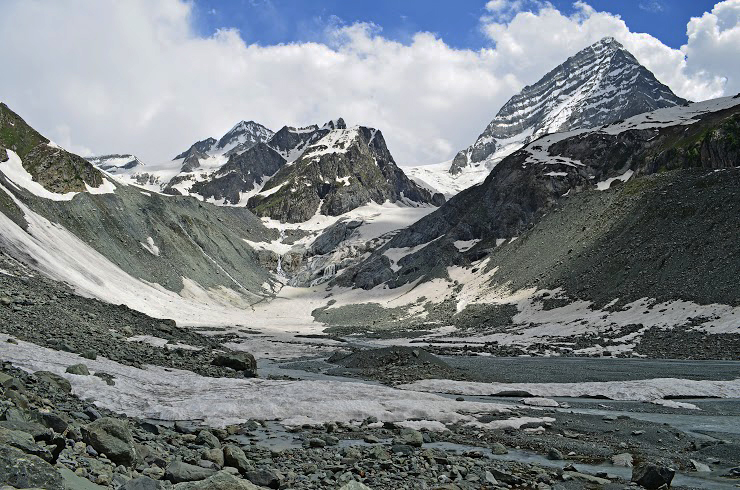
#10: Kolahoi Glacier Trek
Trekking in Kashmir is like nowhere else in the Himalayas with its beautiful mountain meadows and majestic pine trees it has often been compared to the Alps of Switzerland. The 3 day trek up Lidder Valley to Kolahoi Glacier is easily accessed from Srinigar and a good option for a first trek in Kashmir. The trail follows the course of the Lidder River and offers panoramic views of the surrounding snow laden peaks and meadows abound with wildflowers. During the summer the canyon is home to the Gujjars a nomadic people who have herded sheep in the region for centuries. If you make it all the way to the head of the valley you will be rewarded with fabulous views of the Kolahoi Glacier.
Related Reading: Trekking in Kashmir
The Greatest Treks of Tibet
The Himalayas of Tibet are much drier and colder than in India and Nepal and the best time to Trek is from May to September. Getting to Everest Base Camp in Tibet is more a drive than continuing upwards to the advanced base camp offer a once in a lifetime experience and is as high on Everest as you can go without a climbing permit.

#11: Kailash Circuit
The symmetrical mountain is one of the most beautiful and sacred of the Himalaya and the Kailash Circuit is famous as being one of the most difficult treks for religious pilgrims in the world. The mountain is considered by Hindu’s as the abode of Lord Shiva and is geographically and culturally important as the source of the giant rivers of India which include the Brahmaputra and Indus. Ancient texts refer to the mountain as the center of the world. A journey around the mountain will free pilgrims from endless cycles of birth and death. Pilgrims having been making the trek to the region in a tradition that dates back at least several thousand years. The journey is made in a clockwise direction by Hindus and Buddhists while followers of the Jain and Bönpo religions travel the 52km trek around the mountain in a counterclockwise direction.
Related Reading: Best Treks of Tibet

#12: Advanced Everest Base Camp
When most people think of Everest Base Camp they are referencing the base camp on the southern side of the mountain in Nepal which is much more popular as a trekking route. If you want to get to Everest Base Camp in Tibet you can actually drive all the way but the route beyond base camp is where it gets interesting. The route to Mount Everest Advance Base Camp (EABC) at 6,340m / 20795 ft is the highest that one can go on Everest without a climbing permit. This route covers the first 3 camps used by climbers as they approach the summit of Everest via the Northeast Ridge and is considered the world’s highest trek. The route has to Mount Everest Advance Base Camp is a challenging but beautiful trek through a stunning mountain landscape. The journey to EABC starts in Lhasa (11,975ft/ 3,650m) the capital of Tibet where it’s best to spend a few days acclimatizing before heading out towards Everest.
Booking Details: Trek to Advance Base Camp Related Reading: Best Treks of Tibet , The World’s Highest Trek
The Best Treks of Bhutan
Bhutan lies in the western portion of the Himalayas and is often shrouded both in mystery and literally in clouds. Arranging a trek here isn’t as simple or Nepal or India but Bhutan certainly presents some interesting trekking options (Read more – Best Treks in Bhutan ).

#13: Chomolhari Trek
This 10 day trek starts in Paro Valley and heads to the base camp of Chomolhari (7,326 m) the second tallest peak in Bhutan. The mountain is sacred to Tibetan Buddhists and restrictions mean few have ever climbed this beautiful peak. The trek combines beautiful mountain scenery with the unique culture of Bhutan where outsiders have had limited access for years. This is a camping trek that reaches a high point in elevation of almost 5000m.

#14: Snowman Trek
The Snowman Trek is a 25 day journey that traverses the spine of the Himalaya between Bhutan and Tibet. Crossing over 11 passes of which four are over 5000m in height the trek is often called the worlds most challenging. Asides from the passes the trekker most also deal with generally inclement weather and be prepared for almost complete isolation from the outside world. Starting in Paro, the trek generally traverses the spine of the Himalayas between Bhutan and Tibet. If you are thinking of going the best bet for good weather is during October before the snows come to the high passes and just after the monsoon ends.
Image credit: Christopher Fynn
Technically the mountains lying to the west of the Indus River are not considered part of the Greater Himalayas so the Karakoram should be viewed as a distinct mountain range. Security is always a concern trekking or climbing in Pakistan and we don’t recommend it but the beautiful trek up to the K2 Base Camp is certainly on our to do list if the situation improves.

#15: K2 Base Camp Trek
K2 (8611m) is the second tallest mountain in the world and this 20 day trek to the base camp is a once in life experience. The journey starts with great views of Karakoram Ranges with Nanga Parbat but the real highlight may be Concordia which is often called the “the Throne Room of the Gods.” Concordia is at the junction of the Godwin Austen and Baltoro glaciers and is ringed by 4 of the 14 highest peaks in the world. Those looking to summit Gasherbrum II, Gasherbrum IV, Chogolisa, Mitre Peak, Masherbrum, Broad Peak and the Trango Towers all pass this same route. This is not an easy journey to organize but it could not be left out as it must be one of the most impressive journeys in the Himalayas (One with the founders of Himalayanwonders).
Have some suggestions of great treks that we have left off this let us know as we will be updating and revising it.
About the Author Robert Hatch
Rob is an outdoor enthusiast and traveler who got tired of staring at the mountains from his desk, he now spends every minute he can on them instead. He fell in love with Nepal on his first visit and has looked for every opportunity to get back to the Himalayas ever since. He helps our guests find and plan their perfect Himalayan adventure.
Contact the author
XHTML: You can use these tags: <a href="" title=""> <abbr title=""> <acronym title=""> <b> <blockquote cite=""> <cite> <code> <del datetime=""> <em> <i> <q cite=""> <s> <strike> <strong>
Click here to cancel reply.
29 comments
Popular treks.

What’s Hot

- Climate and Weather (3)
- Everest Base Camp (2)
- Himalayas (8)
- Himachal Pradesh (1)
- Kashmir (3)
- Uttarakhand (1)
- Annapurna (4)
- Eastern Nepal (1)
- Everest (15)
- Kathmandu (4)
- Langtang (4)
- Staying Healthy (2)
- Training & Preparation (2)
- Trekking Peaks (3)
- Trekking Tips (6)

- Choosing a Trek
- Tea House Trekking
- Trekking Tips
- Flying to Lukla
- Packing List
- Fitness Training
- Travel Insurance
- Arrival & Visas
- Best Time to Go
- Staying Healthy
- Meet the Team

- Privacy Policy
- Terms & Conditions

Discover the Himalayas
Get our free monthly newsletter highlighting the best treks in the Himalayas.
Get our free monthly newsletter highlighting the best treks in the Himalayas. Get Inspired by amazing photos and our practical trekking advice.
Book with confidence .
15% off on EBC Trek for 2024

- Everest Base Camp Helicopter Return Trek
- Everest Base Camp Short Hike -11 Days
- Jiri to EBC Trek
- Gokyo Lakes Trek
Manaslu Circuit Trek
- Annapurna Base Camp Trek with Helicopter Return
Everest Base Camp Trek
Ghorepani poon hill trek.
- Everest Three High Passes Trek
Makalu Base Camp Trek
Annapurna circuit trek, annapurna base camp trek.
- Everest Round Trek
- Annapurna Panorama Trek
- Short Annapurna Base Camp Trek
- Tsum Valley with Manaslu Circuit Trek
Tamang Heritage Trail Trek
- Mustang Tiji Festival Trek
- Helambu Trek
- Langtang and Gosaikunda Lake Trek
- Nepal Family Adventure Tour
- Annapurna Circuit with Tilicho Lake Trek
- Everest Base Camp Luxury Trek
- Jomsom to Muktinath Trek
- North Everest Base Camp and Lhasa Tour
- Kailash Mansarovar Tour
- Khopra Ridge Trek
- EBC, Gokyo and Chola Pass Trek
- Ghorepani Poon hill Luxury Trek
- Mount Everest Panorama View Trek
Mardi Himal Trek
- Short Mardi Base Camp Trek
- Bhaktapur Day Tour
- Nepal Culture Tour
- India and Nepal Tour
- Sikkim and Darjeeling Tour
- Bhutan Cultural Tour
- Nepal Tibet Bhutan Tour
- Lhasa to Kathmandu Tour
- Kathmandu Day Tour
- Annapurna Family Hike
- Chandragiri Hill Short Hiking
- Nagarkot Hiking Tour
- Chisapani Nagarkot Hiking
- Short Annapurna Luxury Trek
- Mount Everest Flight in a Helicopter
- Pokhara Day Tour
- Pisang Peak Climbing
- Lobuche Peak Climbing with EBC
- Mera Peak Climbing
- Island Peak Climbing with EBC
- Chitwan National Park Tour
- Nepal Adventure Photography Tour
- Nepal Photography Tour
- River Rafting Tour
- Mountain Biking Tour of Mustang
- Upper Mustang Jeep Tour
- Everest Base Camp Trek - 14 days
- Everest Base Camp Luxury Trek - 16 days
- Everest Base Camp Short Hike - 11 Days
- Everest Three Passes Trek - 20 days
- Everest Gokyo Lake Trek - 12 days
- Everest Base Camp Heli Trek - 12 days
- Mount Everest Helicopter Flight -1 Day
- Everest Chola Pass Trek - 18 days
- Jiri to EBC Trek - 20 Days
- Everest View Trek - 07 days
- Everest Trekking Trip (3 High Passes, EBC & Gokyo Ri) - 19 Days
- Dhaulagiri Circuit Trek - 20 days
- Kanchenjunga Base Camp Trek - 24 days
- Makalu Base Camp Trek - 18 days
- Pikey Peak Trek - 09 days
- Annapurna Base Camp Trek - 15 days
- Short Annapurna Luxury Trek - 08 days
- Short Annapurna Base Camp Trek - 6 days
- Annapurna Panorama Trek - 10 Days
- Annapurna Circuit Trek - 18 days
- Annapurna Family Hike - 09 days
- Annapurna Base Camp Helicopter Trek - 10 days
- Ghorepani Poonhill Luxury Trek - 08 days
- Mardi Himal Trek - 10 days
- Short Mardi Himal Trek - 08 days
- Ghorepani Poon Hill Trek - 10 days
- Annapurna Tilicho Lake Trek - 17 days
- Khopra Ridge Trek - 13 days
- Island Peak Climbing - 17 days
- Lobuchhe Peak Climbing - 19 days
- Mera Peak Climbing - 20 days
- Pisang Peak Climbing - 20 days
- Tsum Valley Trek - 17 days
- Manaslu Circuit Trek - 14 days
- Tsum valley with Manaslu Circuit Trek - 21 days
- Jomsom to Muktinath Trek - 14 days
- Upper Mustang Trek - 18 days
- Upper Mustang Jeep Tour - 10 days
- Mountain Biking Tour -10 Days
- Mustang Tiji Festival Trek - 17 days
- River Rafting Tour - 05 days
- Langtang Valley Trek - 11 days
- Langtang Gosaikunda Trek - 14 Days
- Tamang Heritage Trail Trek - 10 days
- Helambu Trek - 09 days
- Chisapani Nagarkot Hiking – 03 Days
- Nagarkot Hiking Tour - 01 day
- Chandragiri Hill Short Hiking - 01 day
- Kathmandu Day Tour – 5-6 Hour
- Pokhara City Tour – 04 Hour
- Chitwan National Park Tour - 03 Days
- Nepal Cultural Tour - 7 Days
- Why Heaven Himalaya?
- Company Overview
- Our Mission
- Responsible Tourism Statement
- Legal Document
- Cookies Policy
- How to Book a Trip with Us
- How to Make a Payment
- Book With Confidence
- How to get to NepaL?
- Trek Grading
- Flight Delays in Nepal
- Packing List for Trekking
- Best Time to Trek in Nepal
- Geography of Nepal

Trekking in the Himalayas | 20 Best Treks to Fuel Your adventure
The Himalayas are the mountain range in Asia, which includes over 110 peaks up to a height of 24,000 ft. or more. Since the first ascent of Mount Everest, the Himalayas have been accessible to everyone around the world. Until now, the Himalayas have hosted hundreds of holiday destinations. Out of all adventure activities, trekking is the most popular one.
We have listed this region’s best treks and enthralling adventure holiday packages.
Before diving into all 20 walks, let us show you our recommendations for the top 5 Himalayan treks.
Table of Contents
5 Best Treks in the Himalayas
Going deep into the history of the Himalayas , we’ll find that it’s much more than just a mountain range. The Himalayas represent the origin of people, life, and living. In the ancient era, sages would go there to meditate, for it was, and is, the best way of self-realization. In the present age, it’s the center of adventure activities like trekking and mountaineering.
Every trekking route we have listed is unique, beautiful, and adventurous in its own way. Because each route has a story to tell and a beauty to represent.
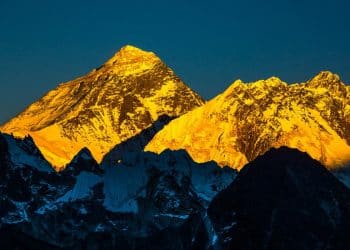
The trip to Everest Base Camp is more than just a mountain trek; it is a journey of self-discovery through the heavenly places in the Himalayas.
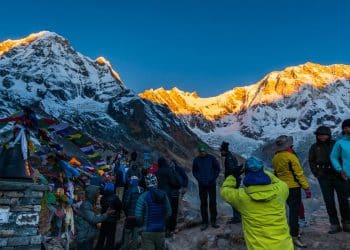
The Annapurna Base Camp Trek is a hiking trip package that takes you close to the Annapurna massif in Nepal.
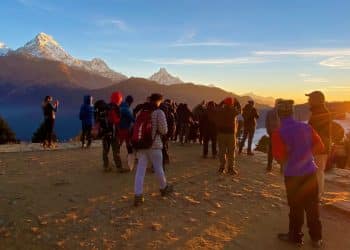
The Ghorepani Poon Hill Trek Package is a short yet exciting trekking tour to Nepal’s Annapurna region.
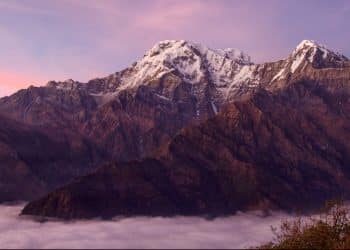
The Mardi Himal Trek is a short and jovial hiking trip in the Annapurna region of Nepal.

Annapurna Circuit trekking is a vintage trekking route that rises above the spirituality and adventures near majestic Annapurna massif.
What makes trekking in the Himalayas so special?
With snow-clad mountains, blue skies, wild landscapes, vast meadows, alpine forests, and stunning scenery, the Himalayas are the elements that make nature perfect. Undoubtedly, the Himalayas are the main reason for trekking in Nepal for travelers.
Here are some more reasons why the Himalayas are special.
- The rawness of natural beauty in the Himalayan trekking trails
- Unspoiled land featuring positive souls and an aura of spirituality.
- The mesmerizing light of the Himalayan sunrise plays hide-and-seek in the snowy mountains.
- The panoramic views help you forget about your exhausting hardships.
- Welcoming innocent smiles from the locals
- You will experience distinctive cultures and traditions along the routes.
Further, the real charm of trekking in the Himalayas is your faith to leap into the culturally pampered open-air play of the diversified treks.
Trekking in the Himalayas as a beginner
The Himalayas are home to diversified trekking trails, cultural diversity, and temperature variations. For beginners, it might sound intimidating, but that’s not true. With more variety comes more trekking destinations.
As a novice, you can always consider a variety of short treks. The spectacular beginner hikes range from classic to world-class adventure trekking.
The choice of trekking depends on your willpower and limitations. A few days of trekking on mild landscapes and familiar Himalayan trails is a good way to start. But if you want a bigger challenge, you can also do the EBC trek as a beginner .
The significant factors for beginners to consider are their interests, physical ability, acclimatization, weather, and equipment. The comfortable costume, a pair of good trekking shoes, and the gear listed below, along with food items and drinking water, can make the beginning quite encouraging.
Use lightweight diets to use maximum calories and not get too heavy and wearisome. Carry only the things that are necessary in your backpack.
Trekking at high altitudes can challenge the body, irrespective of body consumption. Mountains create barriers to network signals. And GPS receivers can be useless on some trekking routes. For that reason, an accurately printed map and compass can help you be self-sufficient.
Before setting out on a challenging trail, it’s always better to accompany an experienced trekker who knows the route well. Likewise, hiring a hiking guide can also be a suitable alternative.
To avoid compromises for a fulfilling trekking experience, make sure you choose a trusted trekking agency in Nepal .
The best time for trekking in the Himalayas
Plan a trek during the autumn (September, October, and November) to observe the clear blue sky, excellent weather, mild temperature, and unforgettable views of the Himalayas. No wonder; it’s the best trekking season of all.
If it’s not autumn, then spring (March, April, and May) can be the best time of the year for any trek in the Himalayas. There’s moderate weather in higher elevations (above 4000 meters), whereas in the lowlands (less than 4000 meters), it is mildly warm.
Also, spring can be suitable for eye-refreshing scenes of greenery, clear skies, surrounding places, mild climatic conditions, and, importantly, mountains.
The moonsoon (June, July, and August) also has waterfall and greenery benefits, but it’s not an ideal time for trekking in the Himalayas. Due to the rain, the trails will be slippery and wet. Also, the Himalayas are prone to landslides and soil erosion, which occur mainly in the rainy season, i.e., the moonsoon.
However, during monsoon, you can still have the best opportunity to travel the Himalayan rain shadow area of the Tibetan route connecting Nepali and Tibetan culture. The Dolpo region and Nar-Phu can give you the beautiful experience of losing yourself in deserted places. So, if you are visiting the Himalayas in summer, then the 4-WD Jeep tour to Upper Mustang can be a good option.
Winter (December, January, and February) can freeze, particularly at night. However, some people love playing in the snow, so winter can be your favorite time for trekking in the Hmalayas if you love cold weather. Winter treks are quite popular as well, especially in the low altitudes.
While snowfalls and freezing temperatures caused by defenseless wind can be difficult for newcomers, the gracious white landscapes are something that sets it apart from other seasons. Thus, it’s never a wasted visit to Nepal for a trekking expedition.
Packing list for trekking in the Himalayas
The satisfaction of the trekking holiday depends on a fruitful experience and wise packing. The carry-ons can’t be lost as if they were a porter and can’t be too light to miss necessary items.
Let’s have a look at an important checklist you don’t want to miss while enjoying the uncertainties of a trek in the Himalayas.
- Rain jacket
- Down jacket
- Sleeping bag
- Lightweight hiking shoes.
- Trekking pants
- Long-sleeved t-shirt
- Water bottles and purifiers
- Trekking Hat
Remember, the trekking routes in the Himalayas can be quite slippery and uncommon, so pack things that make you comfortable while walking. Porters are available to carry your packs along the way.
However, pack only the things you need, and don’t exceed your bag’s weight of 20 kg. Here’s a complete list of packing equipment for trekking .
The Best Trekking Packages in the Himalayas in Detail
Most of the Himalayan destinations lie between the glorious peaks and lush plains in Nepal. The more you go into this wonderland, the more spectacular it gets.
Although the Himalayas spread out in countries like Nepal, India, Pakistan, Tibet, and Burma, the thousands of towering mountains and the incredible trekking routes make Nepal the most popular country for any adventure in the Himalayas.
If you are an enthusiastic traveler and a mountain lover, then Nepal could be your favorite holiday destination. Who knows.
So, here’s a detailed study of the top 20 best treks in the Himalayas :
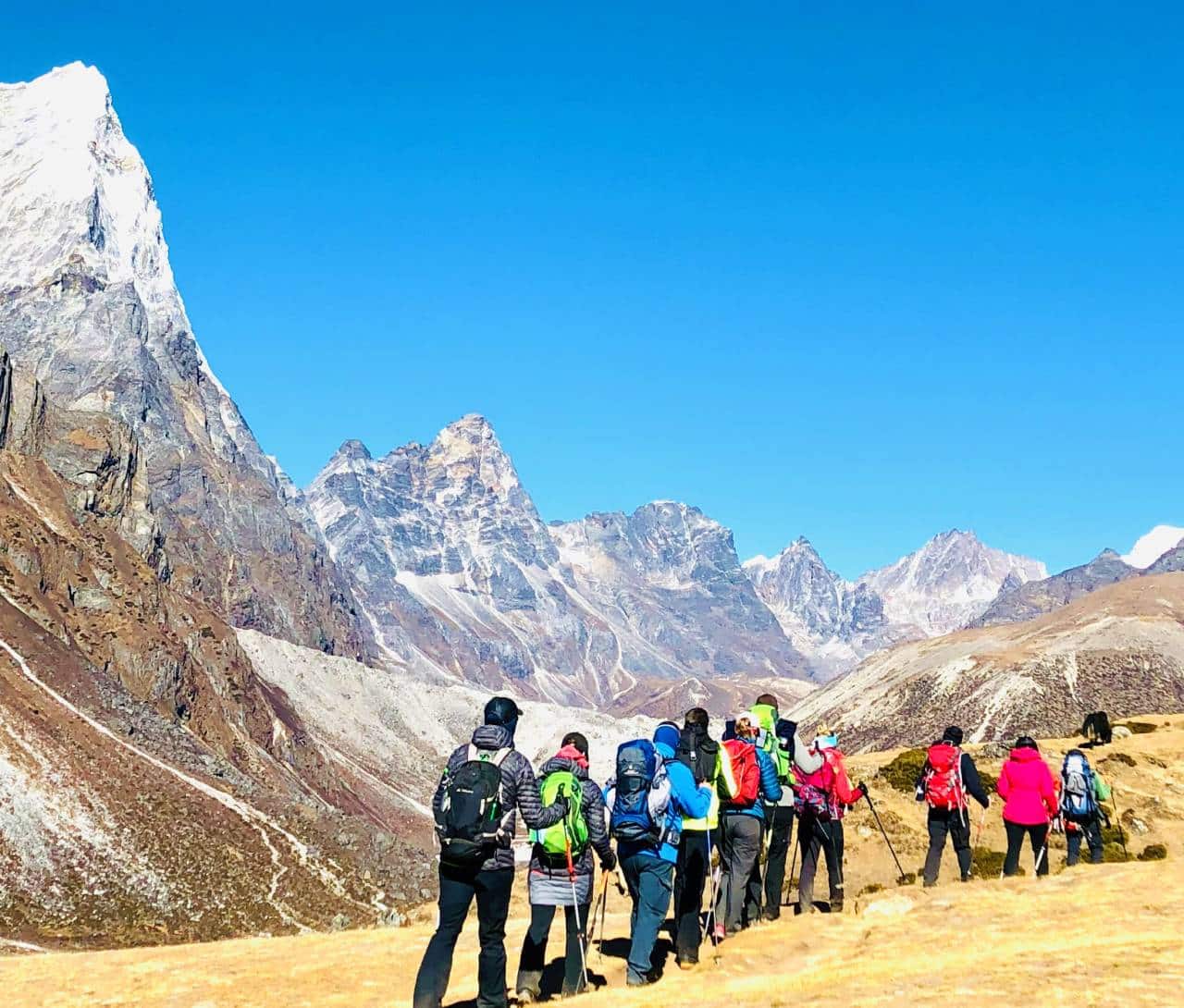
The Everest Base Camp Trek is one of the most popular treks in the Himalayas. Who wouldn’t know about the glory of the mightiest Mt. Everest? It is the world’s highest mountain, standing tall at a height of 8848.86 meters. It’s a lifetime achievement that will test your willpower and endurance capacity while giving you the magnificence of high-altitude terrain at the same time.
With the Everest Basse Camp Trek , you walk through Sagarmatha National Park, enjoying the enticing views of mountains in the Himalayan region. The Sherpa culture and Buddhist religion are the other glorifying aspects of this trek. This is the ultimate journey that gives you in-depth insights into the Himalayas, the Himalayan people, and the local lifestyle.
The journey starts with a flight to Lukla and traverses through Sagarmatha National Park to Namche Bazaar and then to Tengboche. The trail climbs up to Everest Base Camp via Lobuche and Gorakshep . At 5550 m, Kala Patthar is the highest point on the trek.
Moreover, magnificent views of sky-dominating mountains like Mt. Everest, Mt. Lhotse, and Mt. Nuptse Mt. Ama Dablam, Mt. Thamserku, Mt. Tawache, etc., glaciers, icefalls, and wild mountainous landscapes are the offerings of this trek. Thus, the trek to EBC makes it to the top of the list of the 20 best treks in the Himalayas in Nepal.
The best times to trek to Everest Base Camp are from March to May and September to October.
Here’s a list of the best Everest Base Camp trekking tips you shouldn’t ever miss .
Trip Highlights
- A walk to the base camp of the world’s highest mountain, Mt. Everest.
- Sherpa villages, especially Namche Bazaar—the gateway to Everest
- Sagarmatha National Park.
- Tengboche monastery
- Everest Base Camp/Khumbu Glacier
- A beautiful vantage point in the Everest region, Kala Patthar is
- Breathtaking views of mountains such as Mt. Everest, Mt. Lhotse, Mt. Nuptse, Mt. Ama Dablam, Mt. Thamserku, and Mt. Tawache.
Trekking to Annapurna Base Camp
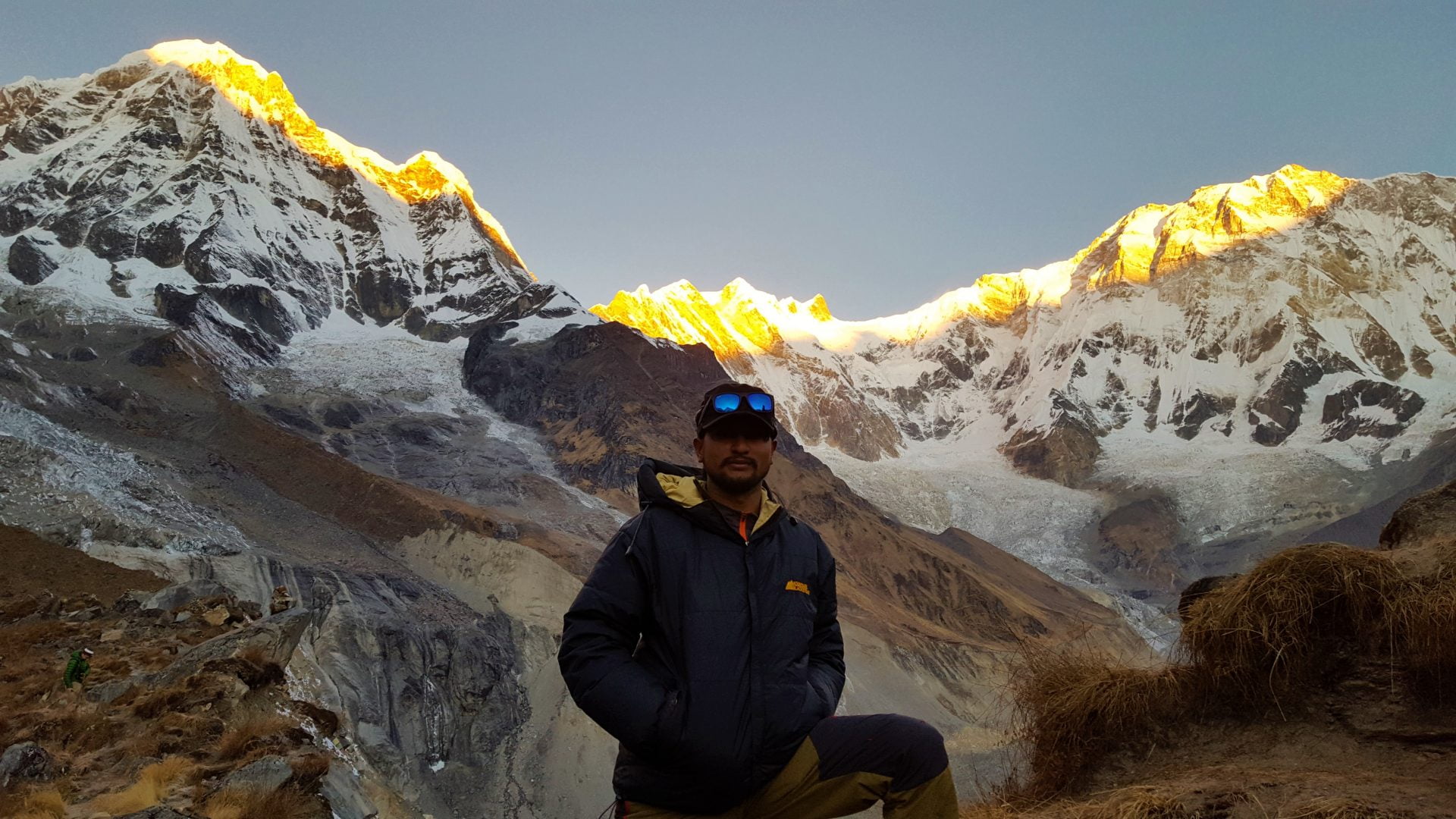
The Annapurna Base Camp Trek is a fascinating trip that takes you through an admirable landscape full of lush hills, valleys, rivers, forests, and mountains.
This hiking trail in the Himalayas starts from the foothills of Annapurna and traverses through charming villages full of traditional houses, cultivated farmlands, and ethnic people. Certainly, the Annapurna region is one of the best trekking destinations in the Himalayas.
The trail takes you deep into the Annapurna Conservation Area, which is home to diverse species of flora and fauna. Here, you can explore the biodiversity and soothe your senses with the magnificent views of the mountains in the background.
Many trails lead you to base camp. But, irrespective of the short Annapurna base camp trek or a long hiking trail, you will come across various stop points from which you can relish the undisturbed views of the Annapurna panorama. The grandeur of the great Annapurna massif is a major highlight of this Himalayan trek. Slowly and gradually, the trekking trail passes through the dense rhododendron forests and pastures to the Annapurna Base Camp.
Also known as Annapurna Sanctuary, it is a synonym for natural paradise. The base camp itself is surrounded by mountain peaks such as Mt. Annapurna I, Mt. Annapurna South, Mt. Machhapuchhre, Mt. Hiunchuli, Mt. Pisang, Gangapurna Himal, and many more. With the snowcapped mountains rising tall one after the other, one can’t help but let their gaze drift from one peak to the next.
Thus, when you are trekking in the Himalayas, you should never forget the famous Annapurna Base Camp Trek .
- The picturesque Pokhara city
- Ghorepani village, with the Himalayas in the background.
- Sunrise and sunset views along with the panoramic views of mountains from Poonhill
- The Annapurna Conservation Area is enriched with diverse flora and fauna.
- Annapurna Base Camp
- Breathtaking views of mountains such as Mt. Annapurna I, Mt. Annapurna South, Mt. Macchapucchre, Mt. Hiunchuli, Mt. Pisang, and the Gangapurna Himal.
- Explore lush landscapes, forests, and ethnic villages while celebrating the Himalayan people.
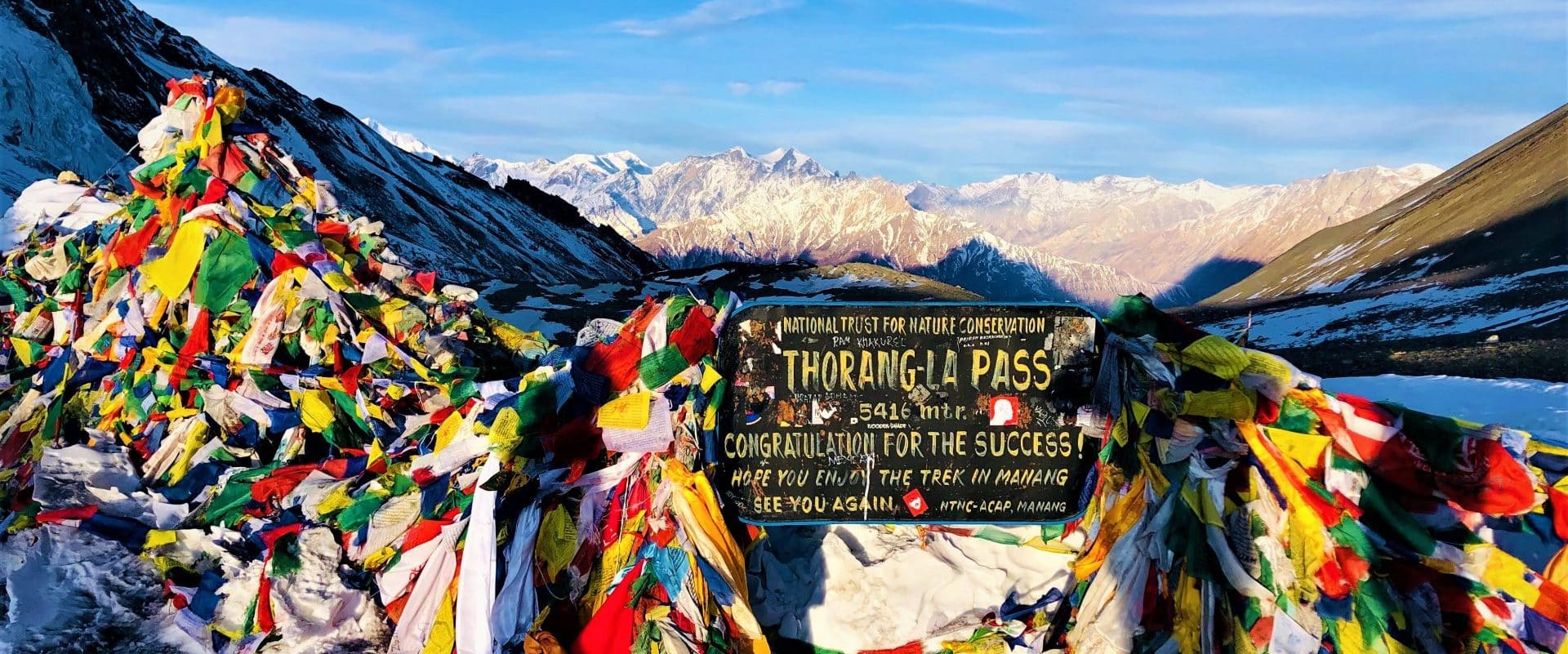
The Annapurna Circuit Trek is one of the classic journeys to the Himalayas. It allows you to experience the tremendous natural and cultural diversity of Nepal.
The trek follows the route of the Marshyangdi valley and takes you from the deepest gorge in the world, i.e., the Kali Gandaki gorge, to the highest mountain pass in the world, i.e., the Thorong La Pass, at an elevation of 5416 meters.
The trek is a fantastic retreat that showcases different aspects of the Himalayas in Nepal on a single trip. With the wild riverbed, picturesque villages, and enchanting valleys enhanced by the mightiness of the towering mountains, the Annapurna Circuit Trek is indeed a classic trek. Diversity in terms of landscapes, vegetation, climate, and geographical conditions is what one can expect from this trek.
The journey starts with a scenic drive from Kathmandu to Jagat. From Jagat, the Himalayan trail climbs up to the Pisang Valley via villages like Dharapani and Chame. The trail follows the Marshyangdi River valley and climbs up to the dry terrain of Manang. From Manang, the path climbs up to Thorong La, passing via the pastures of Yak Kharkha.
From here, one can enjoy the classic Annapurna mountain and glacier views. Leaving the pass, the Himalayan trekking track comes across Muktinath, a spiritual hub for Hindus and Buddhists. The Himalayan hiking trip concludes with a walk back to Pokhara.
- The highest pass in the world—Thorong La Pass
- The deepest gorge in the world—Kali Gandaki gorge
- variety in terms of landscape, climate, and vegetation.
- Pisang and Manang Valley
- Muktinath is a popular spiritual center in the region.
- Astonishing views of mountains such as Mt. Annapurna I, Mt. Annapurna South, Mt. Machhapuchhre, Mt. Hiunchuli, Mt. Pisang, Gangapurna Himal, etc.
- Traditional villages, traditional people, and the Himalayan lifestyle
Langtang Valley Trek
The Langtang Valley Trek is a journey full of excitement and adventure. The majestic views of mountains, wild landscapes, and interesting Tamang culture are the salient features that make the short trek a unique trekking experience in the Himalayas. Likewise, Langtang is a multi-day hiking destination near Kathmandu .
Though the valley is easily accessible from the capital city of Kathmandu, it can still preserve its natural beauty and cultural essence intact. Dominated by the Langtang ranges, the trek takes you through an amazing terrain full of rhododendron forests, waterfalls, rivers, and snowcapped mountains.
During the trek, you will walk through the periphery of the Langtang Conservation Area, which is home to various species of flora and fauna.
Do not be surprised if you meet any red pandas on your way, because you might encounter one in the dense woods of bamboo. As the path traverses through the Langtang Valley, one can notice the dominance of Tibetan Buddhism’s religion and Tamang culture.
Hiking up to Kyanjin Ri and visiting Kyanjin Gompa is a joyous moment for the trek in the Himalayas.
Besides, the cheese factory, traditional villages, and mind-blowing views of mountains like Langtang Himal, Langtang Lirung, Dorje Lakpa, Naya Kanga La, etc. make the Langtang Valley Trek a lively memory.
Further, the Langtang Himalaya hike can also be suitable for beginners who are into trekking and adventure.
Highlights of the Trip
- Trip to Syabrubensi via scenic roads
- Traverse into the rich ecosystem of Langtang National Park.
- Explore Langtang village and visit Kynajin Gompa.
- Hike up to Kyanjin Ri for close views of Langtang Himal, Langtang Lirung, Dorje Lakpa, Naya Kanga La, and other mountains in the range.
- Check out the cheese factory.

This trek is a journey around the world’s eighth-highest peak, i.e., Mt. Manaslu. Opened in 1992, the trek attracted instant attention from its fellow travelers because of its natural beauty and wilderness. The trek follows an off-beaten route full of charming villages, cultivated farmlands, forests, hills, rivers, and stunning mountain scenery.
Between Nepal and the Tibet border, the trek exhibits the culture and lifestyle of both Hindu and Buddhist people. The trek is one of the classic treks of the Himalayas of Nepal that allows you to meander around Mt. Manaslu, which is a giant that rises above eight thousand.
As the route is remote and physically demanding, the Himalayan trail gets a comparatively lower number of travelers. Maybe that’s the reason the region can still maintain its natural authenticity intact.
The Manaslu Circuit Trekking starts with a scenic drive from Kathmandu to Sotikhola. From Sotikhola, we follow a beautiful route that passes through forests, rivers, and villages and climbs up to the ridges.
The trail goes through various villages and traverses the periphery of the Manaslu Conservation Area. After around four days of the trek, one catches glimpses of the mountains.
From Deng, the mountains become visible. There is a viewpoint at Narung village that offers panoramic and close-up views of Ganesh Himal and Mt. Hiunchuli.
The Himalayan trek follows a trail to Dharamshala via Sanagaon. Finally, the trail climbs up to Larkya La Pass, which offers some enticing views of mountains and glaciers. Larkya La Pass is the highest point of the trek. From the pass, we descend to Besisahar, making a circuit around the Manaslu Himal.
- Drive along a scenic route to Sotikhola
- Gorge of the Budigandaki River
- The Manaslu Conservation Area is enriched with biodiversity.
- Manaslu is the eighth-highest mountain in the world.
- At an elevation of 5106 meters, cross Larkya La.
- Enchanting views of mountains such as Mt. Manaslu, Lamjung Himal, Mt. Annapurna II, etc.
Ghorepani Poonhill Trek
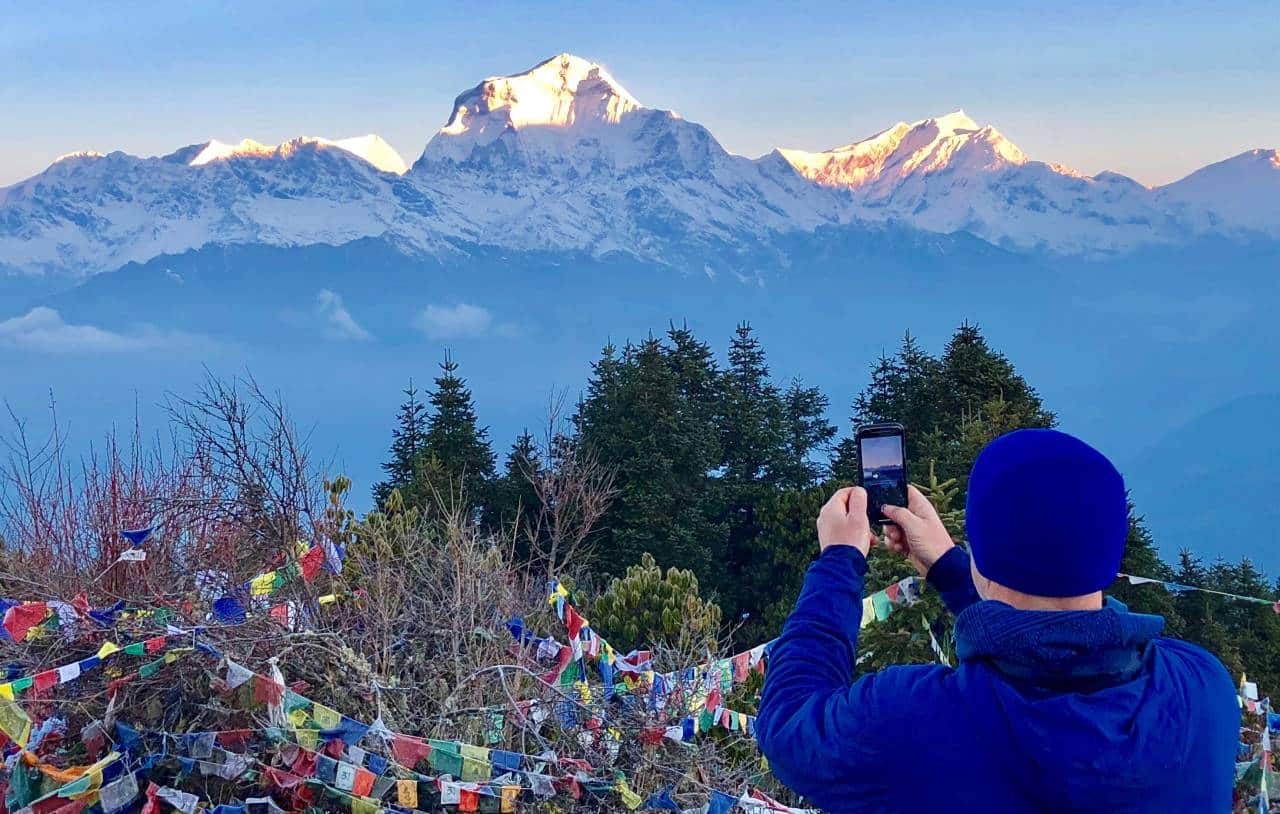
The Ghorepani Poonhill Trek is a favorite trek in the Himalayas of all time. It has three key features: it’s short and full of natural scenery that includes mountains as its priority. Besides, this is also an easy Himalayan trek, best for beginners.
Imagine yourself at a point from where your eyes can capture panoramic views of mountains in the Annapurna and Dhaulagiri ranges! Yes, it’s possible with the Ghorepani Poon Hill Trek on Poon Hill, which has remained the evergreen vantage point in the Annapurna region.
The trail that starts from the foothills of Annapurna traverses a diverse route full of rhododendron forests, charming villages, cultivated farmlands, and mountain views.
The trek starts from Nayapul and climbs up via villages like Birenthanti, Tikhedhunga, and Ulleri to Ghorepani.
At Ghorepani, one can get some insights into the Gurung people, their culture, and tradition while enjoying the captivating views of mountains in the backdrop.
Poonhill is the best location to watch the sunrise amidst the mountain ranges. The trek ends with a jovial descent along an attractive route to Pokhara via the popular village of Ghandruk .
- The shortest and easiest trek in the Annapurna region is suitable for all.
- The city of Pokhara
- Scenic landscapes of the Annapurna region
- Ethnic villages have diverse people and diverse cultures.
- The villages of Ghorepani and Ghandruk
- Gurung villages and Gurung culture
- Sunrise views from Poonhill
- Panoramic views of mountains in the Annapurna region, such as Mt. Annapurna, Mt. Dhaulagiri, Mt. Nilgiri, Mt. Macchapucchre, Mt. Nilgiri, and many more.
Everest Panorama Trek
A trip to Mt. Everest is like a dream come true for various passionate trekkers, travelers, and mountain lovers. Mt. Everest, the highest mountain in the world, is one of the major highlights! Many passionate trekkers are laid back enough to opt for the Everest Base Camp Trek due to time/money constraints or health issues.
After all, it’s not that easy to climb to the height of Everest Base Camp, the base camp of one of the tallest mountains in the world . So, for those, the Everest Panorama Trek is a suitable option. Similar to the Everest View Trek , it is a short and easy trek to the Everest region.
The hike allows you to relish the close-up views of Everest along with other towering mountains in the region like Mt. Ama Dablam, Mt. Nuptse, Mt. Lhotse, Mt. Tawache, Mt. Thamserku, etc.
Everest Panorama Trek starts with a flight to Lukla. The Himalayan trail then climbs slowly via the Sherpa villages, into Sagarmatha National Park.
The trek follows the routes of Phakding, Monjo, and Jorsale to the Namche Bazaar. Here, you can hike to the Everest View Hotel and visit various monasteries, gompas, museums, and villages nearby. From here, the trail climbs up to Tengboche monastery.
From this place, one can enjoy some enchanting views of towering mountains in the region, especially Mt. Everest , Mt. Amadablam, Mt. Nuptse, Mt. Lhotse, Mt. Tawache, Mt. Thamserku, and other neighboring peaks.
- A short trek to the Everest region
- Close-up views of towering mountains in the Everest region include mountains such as Mt. Everest, Mt. Amadablam, Mt. Nuptse, Mt. Lhotse, Mt. Tawache, and Mt. Thamserku.
- Flight to Lukla Airport
- Sherpa villages, Sherpa people, and Sherpa culture.
- Namche Bazaar—the gateway to Everest
- Everest View Hotel and Tengboche Monastery
Upper Mustang Trek
This trek is a journey to the mystic land of the Upper Mustang. Also popular as the Last Forbidden Kingdom, the Nepali government opened the region to travelers only in 1992. Still, there is a limit of 1,000 visitors each year to this region and everyone should get Upper Mustang entry permits .
The Upper Mustang region treasures a rich history that comprises the Tibetan Buddhist religion, culture, ancient monasteries, caves, traditional villages, and traditional people. The long-walled city of Lo Manthang is the major attraction of this region. Not only is it culturally rich, but there are also countless reasons to trek to Upper Mustang .
The travel package to Upper Mustang Trek introduces you to the remote Trans-Himalayan region with its dry desert-like landscape, wild rock formations, deep ravines, and towering mountains surrounding you.
Besides, the myths and stories of this place are out of this world. As you travel through the region, you feel as if you have traveled back in time. The region is still so traditional and ancient, with no hint of modernization from the outer world.
Therefore, it is the one trek in the Himalayas that is both a cultural trip and an adventure trip. Besides, there is road access to the area, so if you don’t want to trek, you can opt-out for an overland tour to Upper Mustang .
- Upper Mustang: The Last Forbidden Kingdom
- The long-walled city of Lo Manthang
- An arid, desert-like landscape surrounded by mountains on all sides.
- Ancient monasteries, caves, and gompas
- Traditional people have a rich culture and lifestyle.
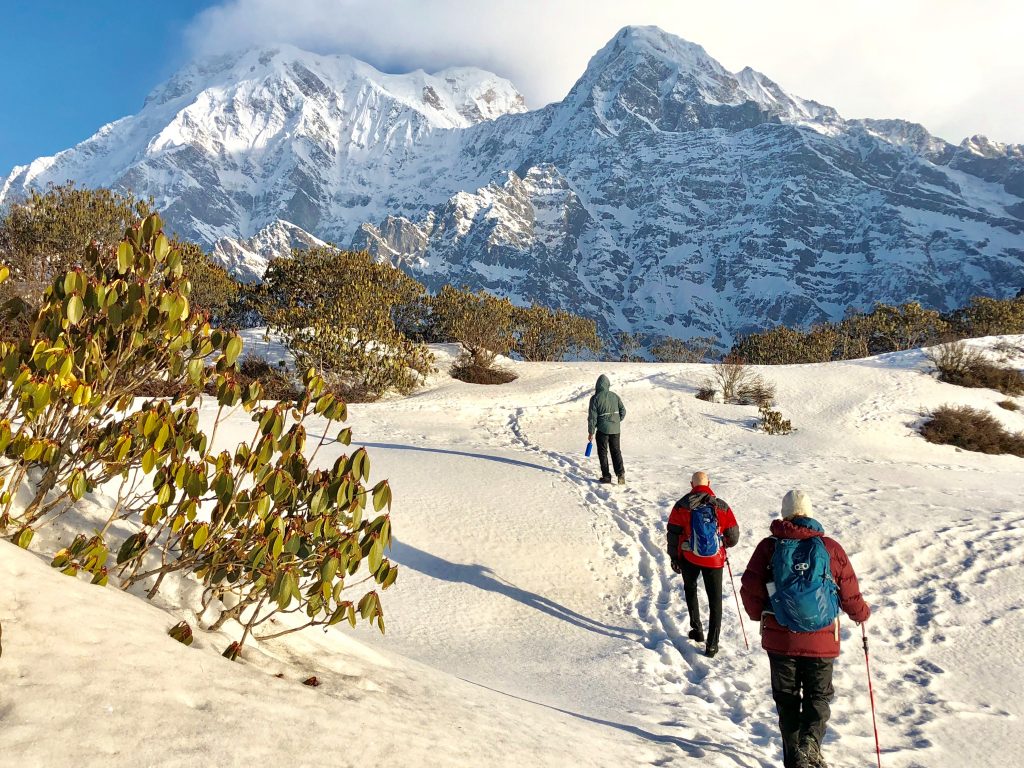
The Mardi Himal Trek has become a favorite of almost all travelers who have opted for this trek.
This trek is a gem that takes you deep into the Annapurna region to taste the wilderness of off-beaten routes and mountains. In a short time, you will stand right before the towering peaks of the Annapurna and surrounding ranges.
The hike takes you to the base camp of the beautiful Mardi Himal, which lies just below the umbrella of the Machhapuchhre Himal. The hike not only offers close-up views of Mardi Himal and Machhapuchhre Himal but also showers captivating views of mountains that include mountains like Mt. Dhaulagiri, Mt. Annapurna, Mt. Hiunchuli, Mt. Nilgiri, and many more.
The trek follows an off-beaten route through the hillside villages, terraced farmlands, forests, pastures, and ridgeline.
Climbing up the ridgeline offers an opportunity to get some magnificent views of the mountains. It has been the best spot for photographers to take photos and admire the glory of the mountains. Mardi Himal is also the best point to observe the sunrise and sunset amidst the panorama of the mountains.
Since it is a low-altitude trek, a novice trekker can go on this Himalayan trip. If you only have a week-long vacation, then the Short Mardi Base Camp Trek can also be a wonderful choice. The easy trails and wonderful mountain views make Mardi Himal one of the best trekking destination in the Himalayas.
- short trek in Nepal, full of enticing mountain views.
- The best Himalayan trek for beginners
- Off-beaten trekking routes
- The rugged high mountain landscape offers some stunning views of Mardi Himal, Machhapuchhre Himal, Mt. Annapurna, Mt. Hiunchuli, etc.
- Less-crowded treks to Annapurna
- Mardi Himal Base Camp.
- Glorious sunrise and sunset views
Kanchenjunga Trek
In between the Nepal and Sikkim borders lies a glorious mountain at an elevation of 8568 meters. It is none other than the sacred Mt. Kanchenjunga, the third-highest mountain in the world.
The Kanchenjunga Trek is a remote trekking experience to the third-highest mountain on earth. Though demanding, the Himalayan Trek is an apple pie for risk-takers and mountain lovers.
The trek will test your strength, but the test is worth it. Himalayan trekking through the region offers an opportunity to traverse a diverse terrain that ranges from the lush tropical jungles and alpine forests to the highly glaciated terrain of the base camp.
With the diverse terrain, you will come across diverse vegetation, biodiversity, wildlife, people, and cultures.
Kanchenjunga Trekking is a restricted trekking area that requires a special trekking permit. The trail to the Kanchenjunga Base Camp passes through the Arun Valley, which is one of the most beautiful sections of Nepal for trekking.
Besides, the trek runs through the Kanchenjunga Conservation Area, which is a treasure trove of diverse flora, fauna, birds, and wildlife. On top of all that, the Kanchenjunga journey can be one of the longest treks in the Himalayas, lasting around 25 days.
- Explore one of Nepal’s most remote and underutilized Himalayan regions.
- Kanchenjunga Base Camp, the base camp of the world’s third-highest mountain
- Yalung Glacier
- diverse terrain that ranges from the lush tropical jungles and alpine forests to the high glaciated terrain of the base camp.
- A physically demanding trek
- Arun valley
- Kanchenjunga Conservation Area
- Traditional villages, traditional people, culture, and lifestyle
Everest-Gokyo Lake Trek
The Gokyo Lakes trek is a delightful trip that allows you to explore the endless beauty of the Everest region. Mount Everest, the highest peak in the world, has always been a charm of the Everest region, but many of us neglect the beauty of the Gokyo Lakes.
Gokyo Valley is a magical place with many emerald-colored freshwater lakes surrounded by towering peaks on all sides. Imagine standing on the Gokyo Ri and taking in the beauty of the blue sky, snow-capped mountains, glaciers, and pristine turquoise-colored Gokyo lakes.
Isn’t it a magical combo? The Gokyo Lake Trek can be quite challenging, but the captivating aura of the place is worth it. Hence, it makes it to the list of the best treks in the Himalayas.
- Off the beaten path of the Everest region is the Gokyo Valley.
- Inspiring views of Mt. Everest, Mt. Ama Dablam, Mt. Nuptse, Mt. Lhotse, Mt. Thamserku, Mt. Tawache, etc.
- The spellbinding beauty of the Gokyo Valley
- Emerald-colored Gokyo Lakes
Tsum Valley Trek
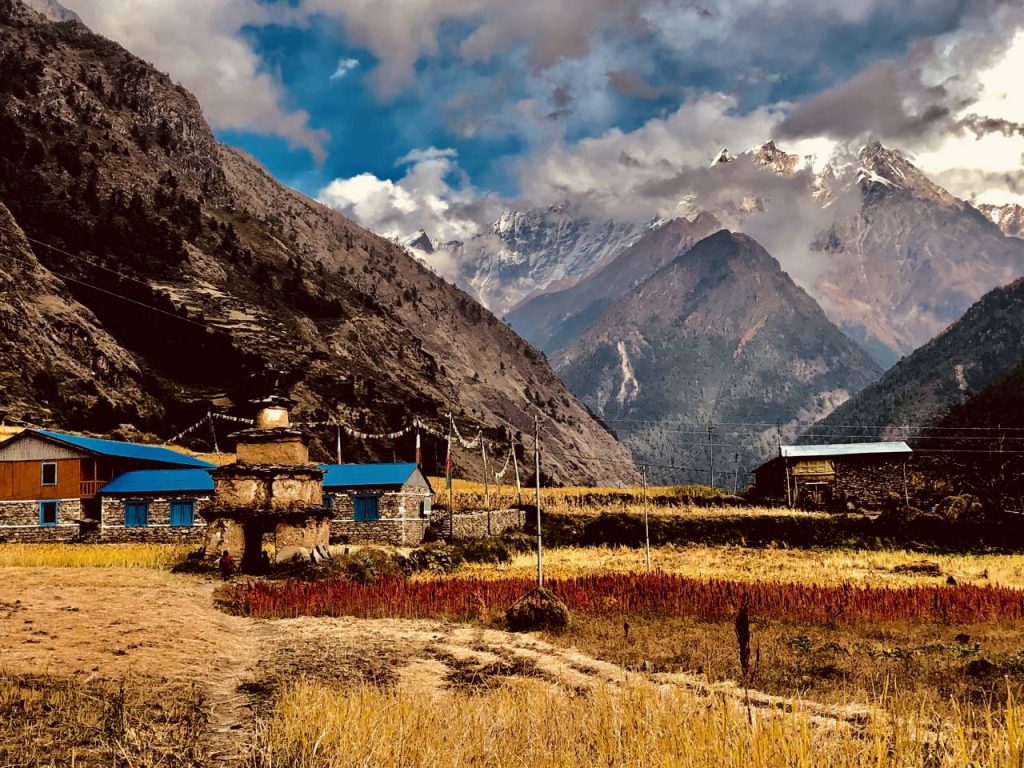
The Tsum Valley Trek is a mesmerizing journey to the majestic valley of the Tsum in the Himalayas. The trek takes you to the sacred Tsum valley in the northern Gorkha district of Nepal.
The name “Tsum” means “vivid” and reflects the vividness of the valley that lies in the backdrop of the beautiful Ganesh Himal, Singri Himal, and Boudha ranges.
The valley, hidden in the shadows of the mountains, displays ancient art, culture, and religion similar to Tibetan society. The physical features of the locals and their dialect resemble those of the Tibetans because they all have Tibetan origins.
The colorful prayer flags , mani walls, chortens, and stupas along the way reflect the Buddhist religion prevalent in the region.
As you travel deep into the valley, you come across the ancient caves and gompas that date back a century. Thus, a hike to Tsum Valley allows you to experience the remoteness of the villages in the Himalayas.
- Walk through the Manaslu region into the less-explored Tsum valley .
- The Tsum Valley is a hidden jewel of the Himalayas.
- Ancient gompas, monasteries, and caves
- Influence of Tibetan Buddhist culture
- Rachen Gompa, Mu Gompa, and and Gompa Lungdang
- Traditional villages, traditional people, and their unique cultures
- Captivating views of Mt. Manaslu, Mt. Hiunchuli, Ganesh Himal, and other mountains in the range.
The Tamang Heritage Trail trek is an enriching trek that takes you through a culturally rich Himalayan trail full of the Tamang community. Since it is a great way to learn about the Tamang people, their culture, and their lifestyle in scenic surroundings, it is also blessed with lush hills, valleys, and mountains.
The Tamang Heritage Trail is a superb combo of wild mountains, antique villages, and picturesque landscapes.
So, one can enjoy the great hospitality of the Tamang people, explore ancient monasteries, and relish the creativity of the Tamang people.
The route begins with a drive from Kathmandu to Syabrubensi. So, the drive is followed by a walk towards the Tamang villages in the Langtang region.
Throughout the trek, you will be blessed with some amusing views of mountains along with interaction with the helpful and cheerful locals.
Also, if you want to experience the Tamang culture through trekking in the Himalayas, then the Tamang Heritage Trail Hike is the perfect fit.
- A cultural trek that gives you some meaningful insights into the Tamang people living in the Langtang region of Nepal.
- Stay at the local homestays and enjoy the great hospitality.
- Explore Tamang villages.
- Hot water springs at Tatopani
- Spectacular views of Ganesh Himal and Langtang Himal.
Trekking to Khopra Ridge

Khopra Ridge Trek, often called Khopra Danda Trek, is an amazing alternative to Poon Hill Trek . Unlike the Poonhill hike, the Khopra Danda Trek is a less crowded, peaceful, and wild hike in the Himalayas. Khopra Danda is less known amongst adventure lovers, but the trek is getting more popular day by day.
Travelers consider Khopra Ridge amongst the best vantage points in the Annapurna region. The Khopra hike follows a less-traveled route along the ridgeline to Khopra Danda.
From the top, we see some magnificent views of mountains that include mountains such as Dhaulagiri Himal, Nilgiri Himal, Annapurna Himal, Hiunchuli, and many other mountains in the range. A hike to Khayer Lake from the Khopra Danda is another major attraction of this Himalayan trek .
- Walk from low-altitude, lush tropical terrain to high-altitude terrain.
- The Ridge Walk is accompanied by stunning views of mountains.
- Panoramic views of mountains in the Annapurna range along with the great Annapurna massif
- Off the beaten trail that passes through remote villages and wild forests
- Hike to Khayer Lake via Khopra Ridge.
- A less crowded trail in the Annapurna region is getting more popular day by day.
Until 1950, Makalu Himal was unknown or very little known to the rest of the world. Still, the Makalu region is amongst the least visited sections in Nepal. Though remote, the region is a darling place in the Himalayas for enthusiastic trekkers and nature lovers.
The Makalu Base Camp Trek takes you to the base camp of Mt. Makalu, the fifth-highest mountain in the world.
The hike runs through the Makalu Barun National Park, which is recognized for its natural richness and biodiversity. The rugged route full of exciting and enticing mountain views is what one can expect from this Himalayan trek.
The trek is not so easy! It’s demanding, physically and mentally. However, the astonishing views of lush hills, valleys, forests, rivers, villages, and mountains make the trek worthwhile.
The trek takes you up to an elevation of 4200 meters to cross Shipton La, which is not a joke at all. But the captivating views of mountains and mountainous terrain from the mountain pass are spellbinding.
One can enjoy panoramic views of the world’s highest mountains like Mt. Everest, Mt. Lhotse, Mt. Chamlang, Mt. Baruntse, etc. Thus, the Makalu Trek is not only an excellent choice for novice hikers, but it is also one of the best hikes in the Himalayas .
- Walk past a beautiful trail full of rhododendron forests, hanging glaciers, waterfalls, and Himalayan views.
- Sherpa and Rai villages
- Makalu Barun National Park
- A rich ecosystem with diverse species of flora and fauna
- Panoramic views of the world’s highest mountains are like Mt. Everest, Mt. Lhotse, Mt. Chamlang, Mt. Baruntse, etc.
- Makalu Base Camp and Shipton La
Annapurna Tilicho Lake Trek
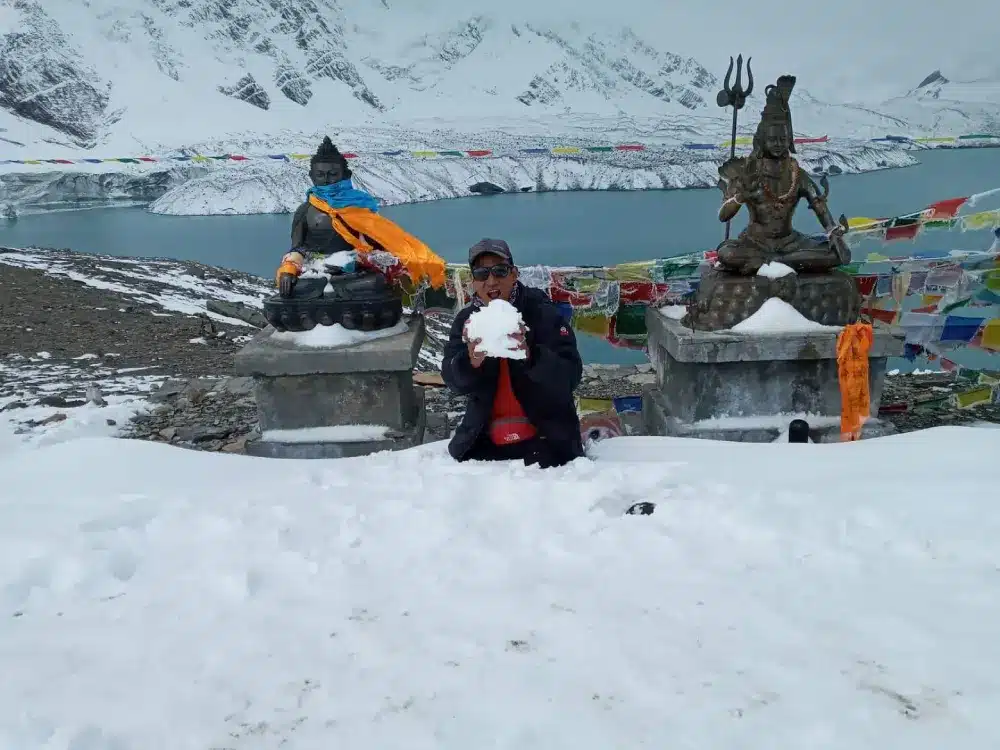
The Annapurna Tilicho Lake Trek is an incredible journey full of adventure, fun, and mountain views. The journey begins with a peaceful day walk along the Kali Gandaki River and follows the Marshyangdi River valley.
The trail further traverses through the Pisang Valley to Manang. From Manang, the trail diverges from the primary route of the Annapurna Circuit to the route of Tilicho Lake.
The trail climbs up to Tilicho Base Camp, a rising trekking destination in the Himalayas, and then to the lake. Being around the serene lake water and spending time on the bank of Tilicho Lake is indeed a rejuvenating experience.
After exploring the lake, the trail descends to Pisang and joins the principal route to the Thorong La Pass via Yak Kharkha.
Thorong La pass, at 5416 meters, is the highest point of the Tilicho Lake trek that offers some amazing views of mountains and mountainous terrain in the Annapurna region. Finally, the Himalayan trail descends to Muktinath and then to Pokhara city via Jomsom.
- Make a circuit around the Annapurna massif.
- Trek to Tilicho Lake, the world’s highest lake.
- Cross the Thorong La Pass, the highest pass in the world.
- Traditional villages, ethnic people, their culture, and traditions
- diverse terrain full of magnificent mountain views.
- Muktinath temple
- Panoramic views of Mt. Dhaulagiri, Mt. Annapurna, Mt. Manaslu, Mt. Nilgiri, Mt. Hiunchuli, and many more.
Himalaya Trek to Dhaulagiri
The Dhaulagiri Trek is one of the extraordinary trekking challenges in the Himalayas . It is demanding, but highly adventurous at the same time. It is not an appropriate hike for beginners, but for experts who will face challenges at every step of the journey.
The Dhaulagiri Trek is a walk to the base camp of Mt. Dhaulagiri, the seventh-highest mountain in the world. The trek will test the limits of fellow travelers at every level.
During the trek, you will travel through one of the most isolated and least traveled sections of the Nepalese Himalayas.
The trek starts from the Kali Gandaki Gorge and climbs up through a lush landscape full of remote villages, farmlands, and forests. As you move higher, you will come across the stunning presence of the mighty Mt. Dhaulagiri.
Walking up to the Italian Base Camp and crossing the French Pass to Dhaulagiri Base Camp is a major highlight of this trip to the Himalayas.
- Walk past the remote sections of Nepal.
- Explore the traditional people, their culture, and their traditions.
- Outstanding views of Mt. Dhaulagiri, the Annapurna massif, and other surrounding peaks.
- Cross the French Pass and hike up to Dhaulagiri Base Camp.
- Enjoy the fun and real adventure of the camping trek.
Everest Chola Pass Trek

The Everest Chola Pass Trek is one of the most challenging Himalayan treks in the Everest region of Nepal. The Chola Pass Trek with Everest Base Camp takes you deep into the Everest region and lets you experience different aspects of the region.
First, it will take you to the Everest Base Camp to admire the grandeur of the world’s highest peak, and then you will cross the Chola Pass, which is one of the highest mountain passes in Nepal.
Crossing the pass is not a simple task! It requires patience, dedication, willpower, and endurance capacity. The Chola Pass trek takes you to the beautiful valley of Gokyo, where you can enjoy the alluring views of Gokyo lakes in the backdrop of the beautiful Himalayas.
Trip Highlights]
- Walkthrough the stunning terrain of the Everest region.
- Vibrant Sherpa villages and Sagarmatha National Park
- Everest Base Camp and hike to Kalapatthar
- Astonishing views of mountains in the Everest region, such as Mt. Everest, Mt. Ama Dablam, Mt. Thamserku, Mt. Tawache, Mt. Nuptse, Mt. Lhotse, etc.
- Cross the Chola Pass.
- Walk towards Gokyo Valley and hike to Gokyo Ri.
- Beautiful Gokyo lakes in the backdrop of the Himalayas
Trekking the Three Passes in the Everest
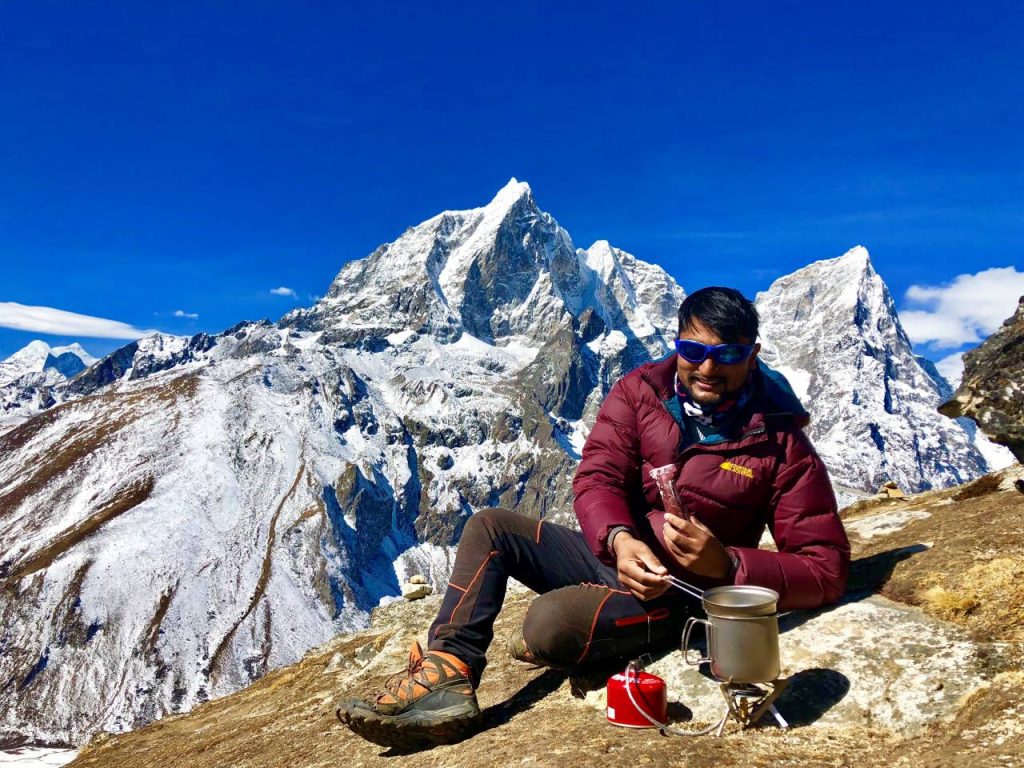
The Everest Base Camp Three High Passes Trek is amongst the toughest treks in the Himalayan Region. The trek starts with a flight to Lukla and traverses through the Sagarmatha National Park to Everest Base Camp. Also, this trek allows an opportunity to cross three high passes, namely the Kongma La Pass, Chola Pass, and Renjo La Pass.
So, the trail of this trek is beautiful in all ways. The mountain views, mountainous terrain, and Sherpa culture are the major highlights of this journey. Crossing the mountain passes over 5000 meters is not a simple task! It requires hard effort and endurance capacity. Without a doubt, it’s one of the toughest hiking tours of Mt. Everest .
So, the magnificence of mountains, glaciers, valleys, and high-altitude terrain is a reward for the trekkers’ tough effort. Though a challenging trek, the Three Passes trek makes it to the list of the best treks in the Himalayas because of the wonderful mountain vistas and thrilling adventures on the way.
- A challenging and adventurous trek to the Everest region.
- Cross three 5000-meter-high Passes, Kongma La Pass, Chola Pass, and Renjo La Pass.
- mountain views, stunning mountainous terrain, and Sherpa culture.
- Magnificent views of Mt. Everest, Mt. Ama Dablam, Mt. Lhotse, Mt. Nuptse, Mt. Thamserku, Mt. Tawache, etc.
- Gokyo Valley and Gokyo Lakes
Langtang Gosaikunda Trek
The Langtang Gosaikunda Lake Trek is a combination of two treks, namely the Langtang Valley Trek and Gosaikunda Lake. So, the region is one of the outstanding regions in the Himalayas in terms of its natural glory and cultural richness.
The wild Tibet-like plateaus, mountains, and glacier views! Who wouldn’t want to get dissolved in the immense beauty of this nature? The trek starts from Syabrubesi and climbs up the route to the Langtang Valley. Since Gosainkunda Lake is a sacred lake for Hindu pilgrims, it is also a religious trek to the Himalayas of Nepal.
The trekking trail passes various villages, farmlands, rivers, waterfalls, and forests of the Langtang Conservation Area in the valley. In the valley, you get to explore the traditional villages, interact with locals, and climb up to Kyanjin Gompa. Finally, you walk up to Gosaikunda , a holy lake in the backdrop of the beautiful Himalayas.
- Langtang Conservation Area
- Langtang valley, cheese factory, and Kyanjin Gompa
- Hike to Kyanjin Ri for amazing views of mountains such as Langtang Himal, Dorje Lakpa, Langtang Lirung, and other mountains in the range.
- Gosaikunda Lake
- Traditional villages, Tamang people, and their unique culture and tradition
- The influence of the Tibetan Buddhist religion
Easy and Short Himalaya Treks
While we mention Himalayas, the main destination which comes in mind is Nepal. The chief strength of Nepal for enthusiasts in the Himalayan trekking world is that it provides a variety of trekking routes. It can be a short and swift trek, whereas it can be quite adventurous to hold your breath, especially along with the deadliest passes.
To sum up, you have the freedom of being a noob and a pro, while the experience is always more than satisfying. Nepal will always serve your preference for treks.
Also, if you are eyeing for challenging treks in the Himalayas, then warming up to familiarize yourself with short treks is the best thing to do before setting out.
This is the best opportunity to explore the weather, surroundings and understand the conditions, aclimatization, and landscapes.
Nothing should hold you back, like the number of days to stay, experience status, risk-taking attitudes, adventure preferences, and directions for trekking on these safe trails.
We have made information workable for any queries in Heaven Himalaya. The safety and pleasure of the sightseers are what Heaven Himalaya cares for.
Visit some of the short and easy Himalayan treks.
- Annapurna Family Trek
- Annapurna Luxury Trek
- Annapurna Panorama Trekking
- Chandragiri Hill Short Trekking (1 day)
- Chisapani Nagarkot Trekking (3 days)
- Everest view trek (7 days)
- Pikey Peak trek (9 days)
- Mardi Himal Base Camp Trek (8 days)
- Ghorepani Poon Hill Luxury Trek (8 days)
- Helambu Trek (9 days)
If you love staying close to the city with a pinch of luxury then Kathmandu, is a fascinating place centered on major treks. The humus-rich fertile soil, sophisticated facilities, and moderate weather combine to brew amazing trekking destinations. The valley is surrounded by hills with amazing trekking trails.
Some of the trekking destinations around the Kathmandu Valley are:
- Chisapani Trek
- Nagarkot Trek
- Kakani Trekking
- Langtang Trekking
- Helambu Trekking
- Champadevi Trek
- A Short Trek to the Chandragiri Hills
- Short Hike in Phulchowki
In the end,
Trekking in the Himalayas is a wonderful opportunity for travelers to walk toward the tallest peaks in the world .
Himalayas is a mountainous region with high hills and majestic peaks. So, the topography and weather invite challenges on the trails. Therefore, having insights into trekking in the Himalayas is a must before stepping onto any kind of trail. For you, our blog will be enough to set foot on the trail. But make sure you go through every details carefully.
We, Heaven Himalaya is one of the best Himalayan trek organizers. So, for any kind of trekking or travel activity, please remember us as your reliable travel companion. We are always here for your help!

sanjib adhikari
Sanjib is a seasoned adventurer and a tourism expert who has spent the past 6 years immersed in Nepal's vibrant travel industry. He has trekked through Nepal's iconic landscapes in the Everest, Manaslu, Annapurna, and Langtang regions. He now spends his time writing about different places in Nepal and helping others travel effortlessly.
Planning a Nepal Trip?
Make an inquiry.
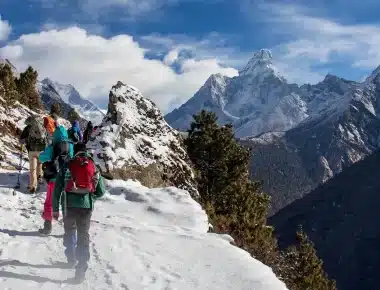
19 Best Short Treks In Nepal (3-6 Days Itinerary)

54 Years Old Kami Rita Sherpa to Summit Mt. Everest for the 29th time
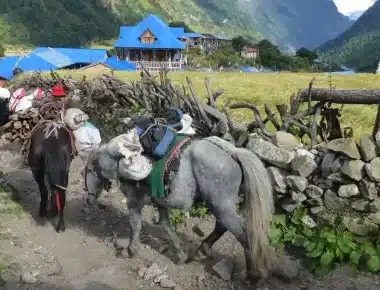
Lho Village: A Popular Accommodation Stop in Manaslu Trek
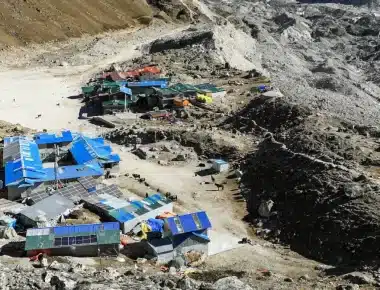
The Ultimate Guide to Everest Base Camp Trek Accommodation
[…] Mustang has a complex and rich history, making it one of the prominent fascinating hiking places around the Himalayas. This mystical land embraces your shadow as for the Himalayas along with less inhabitation loyal […]
Leave a Reply Cancel reply
Your email address will not be published. Required fields are marked *
Save my name, email, and website in this browser for the next time I comment.

The Ultimate Guide to Trekking in the Himalayas
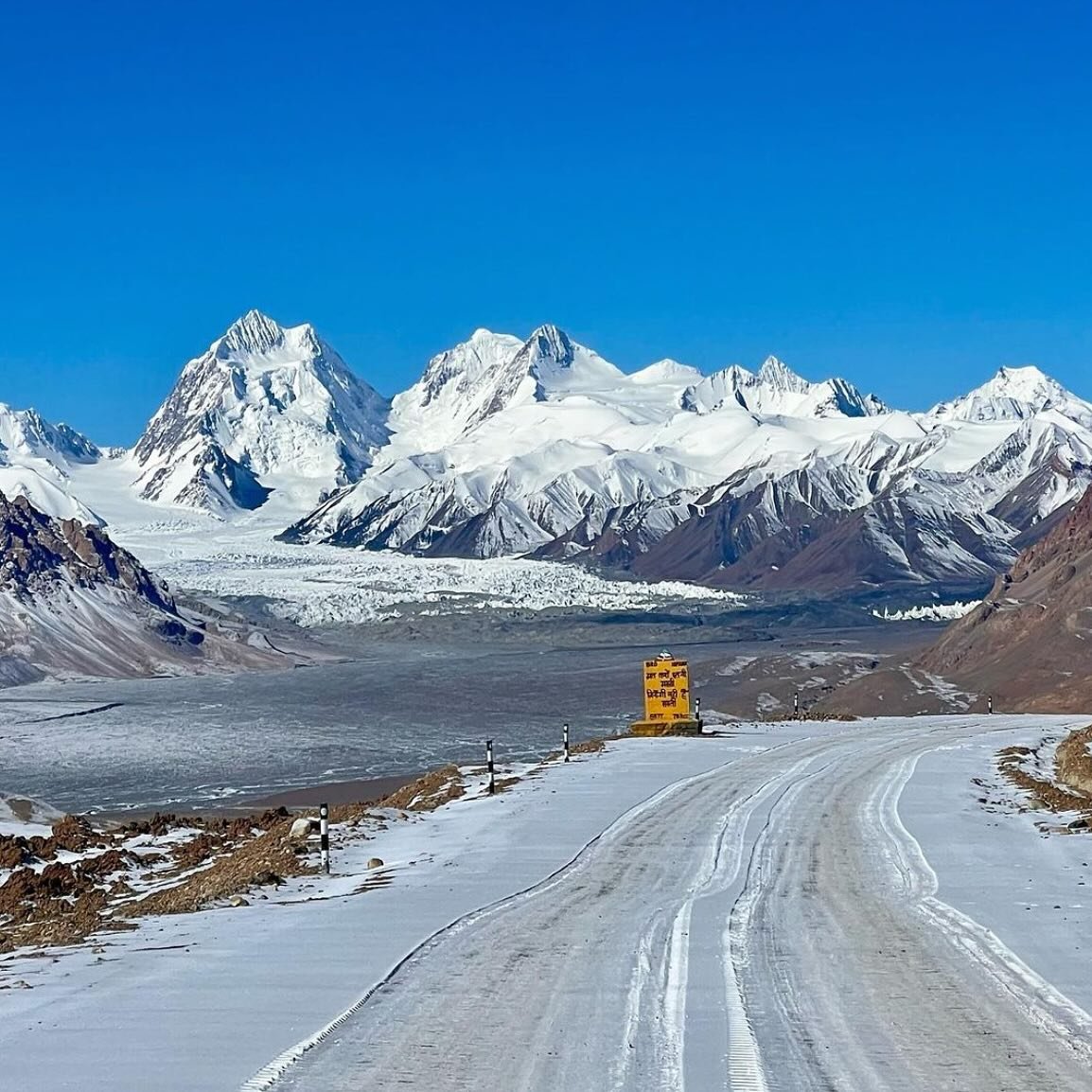
Trekking in the Himalayas is a dream come true for outdoor enthusiasts and adventurers. The towering peaks, breathtaking landscapes, and rich cultural heritage make this region a must-visit for those seeking an unforgettable experience. In this ultimate guide, we will delve into the various aspects of trekking in the Himalayas, from understanding the terrain to preparing for your adventure, choosing the right route, and navigating cultural etiquette.
Understanding the Himalayan Terrain
Before embarking on a Himalayan trek, it is crucial to familiarize yourself with the unique geography of this region. The Himalayas, known as the “Roof of the World,” span several countries, including India, Nepal, Bhutan, and Tibet. These mountains are home to some of the highest peaks in the world, including Mount Everest and Kanchenjunga.
Within the Himalayas, you’ll encounter diverse landscapes, ranging from glaciers and snow-capped mountains to lush valleys and alpine meadows. As you ascend in altitude, the terrain becomes more challenging, with steep slopes, rocky paths, and narrow ridges. It is essential to be physically and mentally prepared for the demanding nature of the trails.
The Unique Geography of the Himalayas
One of the remarkable features of the Himalayas is the presence of deep gorges and high passes. These natural formations pose both challenges and scenic beauty for trekkers. Crossing these passes requires careful planning and an understanding of the potential risks involved, such as altitude sickness and unpredictable weather conditions. The correct equipment is essential. However, the awe-inspiring views from these vantage points make every effort worthwhile.
The Himalayas are also home to numerous rivers and glacial lakes, which add to the enchantment of the trekking experience. The pristine waters of these lakes and rivers not only offer picturesque views but also serve as a source of freshwater for the local communities residing in these remote areas.
Weather Patterns and Climate Zones
One of the critical aspects to consider while trekking in the Himalayas is the weather patterns and climate zones you will encounter along your journey. Due to the immense size of the mountain range, the climate can vary significantly from one region to another. It is essential to research and understand the weather patterns of the specific area you plan to trek in.
The Himalayas have distinct climate zones, including tropical, subtropical, temperate, and alpine. As you ascend in altitude, the temperatures drop, and the air becomes thinner. It is crucial to dress in layers and carry appropriate gear to adapt to the changing weather conditions.
Flora and Fauna of the Himalayas
The Himalayas are not just a visual spectacle; they are also home to a rich biodiversity of flora and fauna. The region boasts a stunning variety of plant species, including colorful rhododendrons, orchids, and junipers. As you trek through different vegetation zones, you’ll witness the transition from dense forests to alpine meadows.
Moreover, the Himalayas house diverse wildlife, such as snow leopards, red pandas, Himalayan tahr, and musk deer. If you’re lucky, you may spot some of these elusive creatures during your trek. It is crucial to respect the natural habitats of these animals and follow established guidelines to minimize your impact on their ecosystems.
Preparing for Your Himalayan Trek
Preparing adequately for your Himalayan trek is essential to ensure a safe and enjoyable experience. Here are some key factors to consider:
Physical Fitness Requirements
Trekking in the Himalayas requires a reasonable level of physical fitness. The steep ascents and descents, coupled with high altitudes, can put strain on your body. It is recommended to engage in regular aerobic exercises, such as jogging or cycling, to build stamina and endurance. Additionally, incorporating strength-training exercises and practicing hiking with a loaded backpack will help simulate the challenges you may face during the trek.
Essential Gear and Equipment
Having the right gear and equipment is crucial for a successful trek in the Himalayas. This includes sturdy and comfortable trekking boots, suitable clothing for various weather conditions, a reliable backpack, a sleeping bag, a trekking pole, and a headlamp. It is also essential to carry a first aid kit, water purification tablets, and high-energy snacks to sustain yourself during the trek.
Health and Safety Considerations
Prioritizing your health and safety should be a top concern during your Himalayan trek. Acclimatization is crucial at higher altitudes to avoid altitude sickness. It is recommended to include rest days in your itinerary to allow your body to adjust to the changing altitude gradually. Staying hydrated, eating nutritious meals, and avoiding excessive alcohol and caffeine consumption are also important for maintaining your well-being.
Additionally, it is essential to obtain comprehensive travel insurance that covers high-altitude trekking and medical emergencies. Familiarize yourself with the emergency evacuation procedures of the region you plan to trek in and carry relevant contact information.
Choosing Your Trekking Route
With numerous trekking routes to choose from, selecting the right one can be overwhelming. Here are some factors to consider:
Popular Himalayan Treks
• everest base camp trek, • annapurna circuit trek, • langtang valley trek, these treks offer a balance of stunning landscapes, cultural immersion, and a moderate level of difficulty. they are well-established and cater to both novice and experienced trekkers., off-the-beaten-path treks, • manaslu circuit trek, • kanchenjunga base camp trek, • dolpo trek.
If you’re looking for a more remote and adventurous experience, these off-the-beaten-path treks are worth considering. They offer a chance to explore lesser-known regions and interact with local communities that have retained their traditional way of life.
Assessing Difficulty Levels
Each trek in the Himalayas has its own set of challenges and difficulty levels. Factors such as altitude, distance, and terrain contribute to the overall difficulty of a trek. It is important to assess your abilities honestly and choose a trek that aligns with your fitness level and experience.
Consider consulting with experienced trekking companies or guides who can provide valuable insights and advice based on your preferences and limitations.
Navigating Cultural Etiquette
While trekking in the Himalayas, it is essential to respect the local customs and traditions. Here are some guidelines:
Respecting Local Customs and Traditions
The Himalayan region is culturally diverse, with each community having its own set of customs and traditions. Educate yourself about the local culture and norms before embarking on your trek. Dress modestly, be mindful of your behavior, and seek permission before taking photographs of people or religious sites. Engaging in cultural exchanges with the locals can enrich your experience and foster mutual understanding.
Interacting with Local Communities
The hospitality of the Himalayan communities is renowned. Interacting with locals can offer valuable insights into their way of life and contribute to a more meaningful trekking experience. Ensure that your interactions are respectful and considerate. Supporting local businesses, such as homestays and locally-owned tea houses, helps sustain the local economy and promotes responsible tourism.
Sustainable Trekking Practices
As a responsible trekker in the Himalayas, it is crucial to minimize your impact on the environment. Follow established trekking trails to reduce erosion and preserve the fragile ecosystems. Dispose of waste properly and avoid single-use plastics. Furthermore, support organizations and initiatives that promote sustainable tourism and conservation efforts in the region.
In conclusion, trekking in the Himalayas is a transformative experience that combines natural beauty, physical challenges, and cultural immersion. By understanding the unique terrain, adequately preparing for your trek, choosing the right route, and navigating cultural etiquette, you can make the most of your Himalayan adventure. Embrace the majesty of the mountains, connect with local communities, and leave a positive impact on this awe-inspiring region.
Related Posts
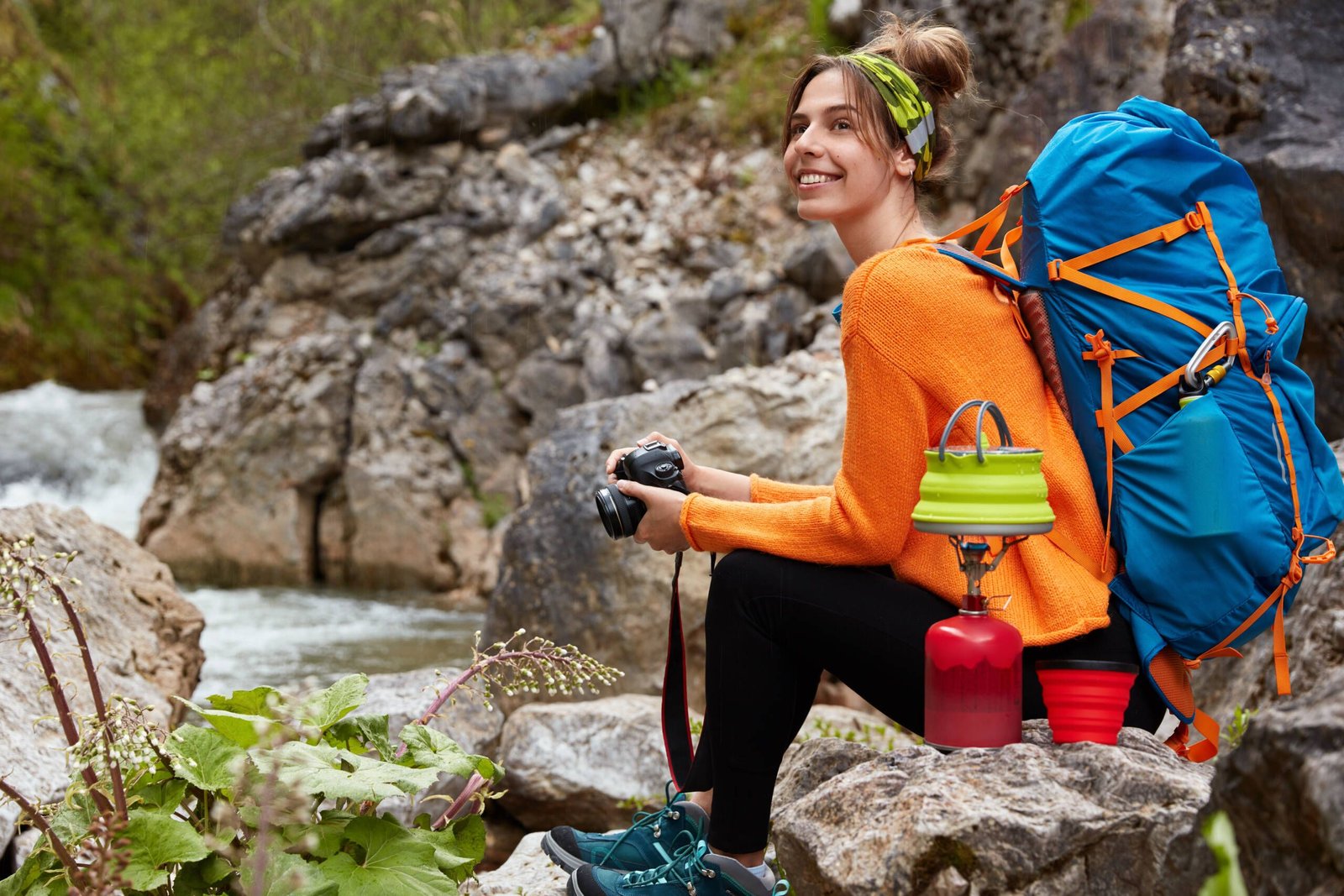
Trekking Safely: for High Altitude in the Himalayas

FISHING TRIPS: A Perfect Blend of Adventure and Tranquility on the Saryu River

Family-Friendly Treks in India: Destinations and Tips for Trekking with Kids
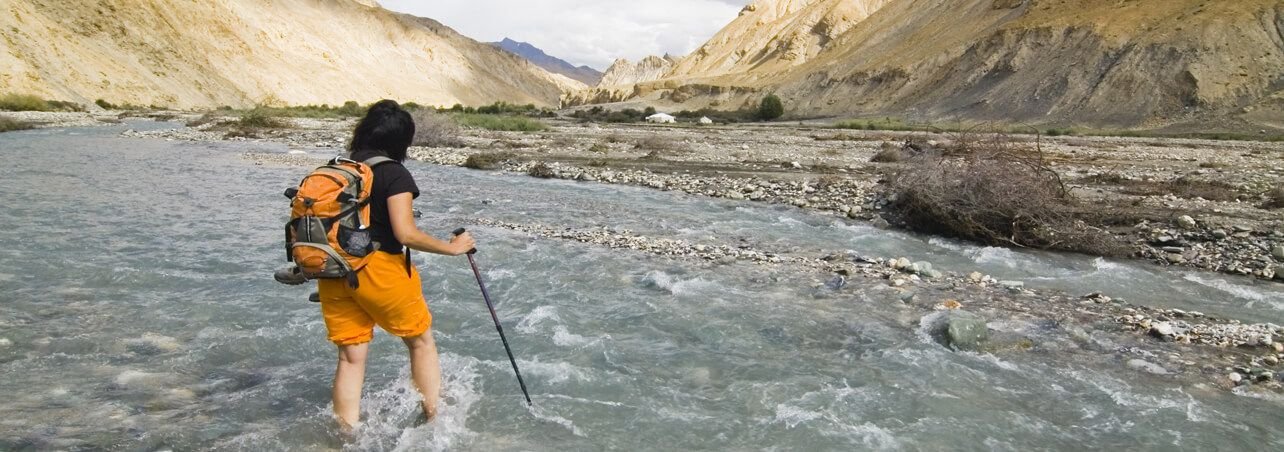
A Guide to Responsible and Sustainable Trekking
- Birdwatching
- Curated Journeys
- +91 9815605847
- [email protected]
- Antler Woods, Main, road, opposite Siswan Dam, Baddi, Siswan, Punjab 140110
The Himalayan Outback was featured in

© Copyright 2023 Himalayan Outback. All rights reserved | Managed By Pinaak Ventures

- Best Hikes In The World
- Appalachian Trail
- European Hikes
- Nepal Hikes
- Patagonia Hikes
- See All Hikes
- Mount Kenya
- Mount Kilimanjaro
- Mount Toubkal
- See All Mountains
- South Africa
- New Zealand
- Switzerland
- United Kingdom
- Packing Lists
Annapurna Circuit – Nepal’s Classic Circuit Trek
Asia , Hikes , Nepal
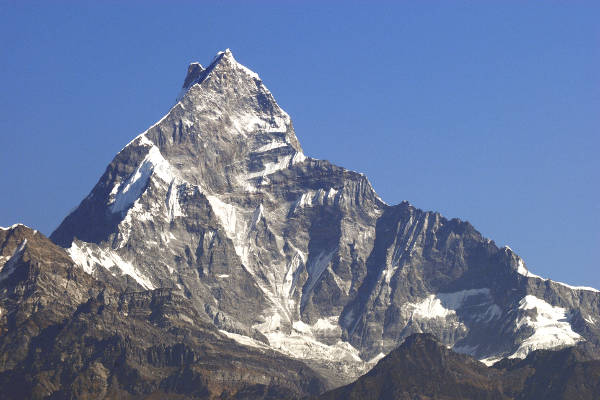
The Annapurna Circuit is one of the most popular and most epic treks in Nepal . This classic trek meanders through Himalayan foothills and over high passes, offering picturesque mountain views along the way.
Annapurna Circuit Trek
Route overview.
The Annapurna Circuit is one of the greatest treks in Nepal, if not the world.
Although road construction over the past two decades has severely impacted the trekking experience (more on this later).
Note: if you are a mountain biker, the road on the western side makes for one of the most exhilarating and scenic mountain biking experiences!
Where Does The Annapurna Circuit Start and End?
The trek begins at Besisahar (which is a 7-8 hour drive from Kathmandu) and concludes in the Kali Gandaki Gorge – the disputed highest gorge in the world that separates Dhaulagiri (8,176 meters) in the West and Annapurna (8,091 meters) in the East.
The circuit is traditionally followed on an anti-clockwise trail – for acclimatization reasons – that circumvents the Annapurna Massif. It takes trekkers through the Annapurna, Manang and Mustang region of central Nepal.
Route Details
At its pinnacle, the trek crosses the Thorung La Pass (5,416 meters) before descending down to the town of Muktinath. From here the road construction activities (2004 -2008/09) have had a measurable impact on the Annapurna Circuit trekking experience.
The Nepalese government have realized that the road on both the Western (Pokhara-Muktinath) and Eastern (Chame-Manang) side of the circuit has had a negative impact on trekking tourism. Thus, they have created a number of New Annapurna Trekking Trails (called NATT-trails).
These NATT-trails, marked blue and white or red and white, take trekkers away from the dusty and unpleasant roads. The alternative routes provide a much more pleasant trekking experience.
How Long Is The Annapurna Circuit?
The Annapurna circuit typically takes between 16-20 days to complete. This is depending if you decide to tack on a diversion to Annapurna Base Camp and the Annapurna Sanctuary ). It covers between 150-240 km depending on when you decide to end the tour or use transportation vehicles.
Scenery and Landscape
The scenery on the Annapurna Circuit is extraordinarily beautiful. Trekkers pass through rice terraced paddy fields, subtropical forests, and glacial environments.
You will see a number of major mountains including the Annapurna Massif (I-IV), three 8,000 metre peaks – Dhaulagiri (8,176 meters), Manaslu (8,156 meters) and Annapurna I (8,091 meters). There are numerous other peaks of 6,000 to 7,000 meters.
Please Note: The Annapurna Circuit is situated in the Annapurna and Mustang regions of central Nepal. It is home to the Annapurna Massif. The schematic below illustrates Nepal’s trekking regions (not to scale).
Annapurna Regional Map
The Annapurna Circuit is situated in the Annapurna and Mustang regions of central Nepal. It is home to the Annapurna Massif. The schematic illustrates Nepal’s trekking regions (not to scale)
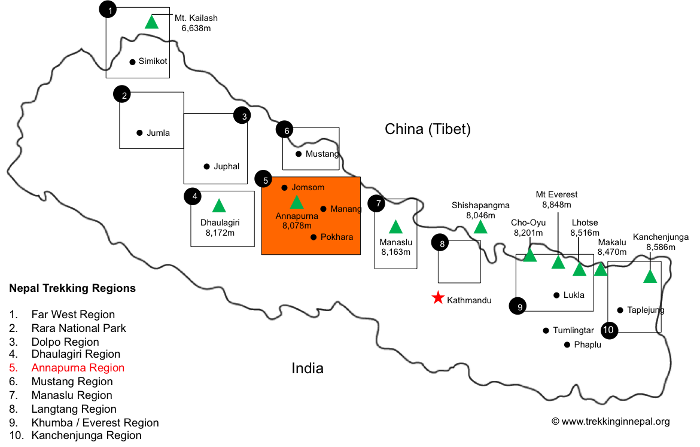
Annapurna Trek Altitude Profile
The schematic diagram below shows the route altitude profile for the Annapurna Circuit.

Annapurna Circuit Itinerary
Below is a detailed Annapurna Circuit itinerary. Where possible we have highlighted the NATT-Trails that can be used to avoid the road. Please note that this is a typical Annapurna Circuit itinerary. Some tour operators offer variations on this route.
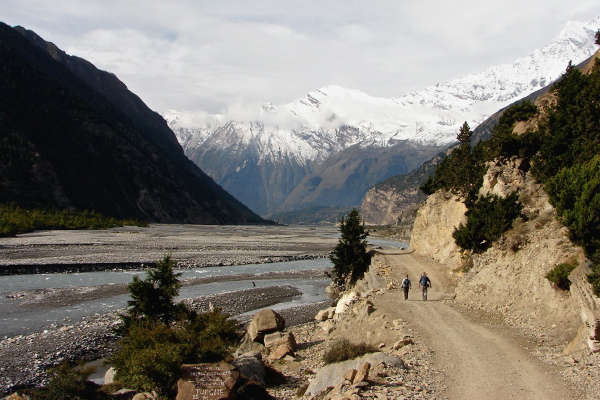
Day 1-2: Arrive Kathmandu (Drive to Besisahar / Fly to Pokhara)
Arrive in Kathmandu, usually spend a day sightseeing in the capital city.
See more in our guide on what to do in Kathmandu .
Drive from Kathmandu (1,300 meters) to Besisahar / Khudi (circa 800 meters) via bus. The trip takes between 7 and 8 hours, meandering through countryside villages.
The Annapurna Circuit typically starts at Besisahar, an hour’s trek from Khudi. Some operators may drive you to Khudi and commence the trek from there.
Day 3: Trek from Besisahar (820 meters) to Khudi and onto Bahundanda (1,310 meters)
Trek from Besisahar (820 meters) to Khudi and onto Bahundanda (1,310 meters). This traditional route has been impacted by the road construction so some operators have started using new trails that bypass the road. Instead, you go to the village of Sikrung (2,200 meters).
The latter is a fairly steep climb to a rather high altitude. But it does offer a more untainted Annapurna trekking experience. Expect to trek between 6-7 hours.
Day 4: Trek from Bahundanda (1,310 meters) / or Sirung (2,200 meters) to Jagat (1,300 meters) or potentially Chamje (1,410 meters)
Trek from Bahundanda (1,310 meters) / or Sirung (2,200 meters) to Jagat (1,300 meters) or potentially Chamje (1,410 meters). If on day 4 you followed the traditional route to Bahundanda, you will trek to Ghermu (1,130 meters) and onto Jagat. You might stay the night here or take a steep hour-long trek up to Chamje (1,410 meters).
We recommend staying the night at Chamje instead of Jagat, which is a dirty and crowded village. If on day 4 you stopped at Sikrung, you will likely follow a route via Syange (1,100 meters) to Jagat and up to Chamje.
Expect to see great rice terraced landscapes and views of the Manaslu Range during early stages of this day’s trekking.
Day 5: Trek from Jagat / Chamje (1,300 / 1,410 meters) to Dharapani (1,960 meters)
Trek from Jagat / Chamje (1,300 / 1,410 meters) to Dharapani (1,960 meters). Continuing north into the Manang region, you will trek through agricultural fields of corn and potatoes and then forests of rhododendrons.
Eventually reach the quaint village of Tal (1,700 meters). From Tal you will trek for another 6 kms (circa 3 hours) via Karte to the village of Dharapani (1,960 meters).
Day 6: Trek from Dharapani (1,960 meters) to Chame (2,710 meters) via Bagarchap and Danakyu, and then either along the lower trail or upper trail to Koto (2,640 meters)
Trek from Dharapani (1,960 meters) to Chame (2,710 meters) via Bagarchap and Danakyu, and then either along the lower trail or upper trail to Koto (2,640 meters).
From Koto you trek a further hour to the busy village of Chame. Some trekkers and operators prefer an overnight stay in the quieter village of Koto. On this rather steep trekking day you will get some great views of Annapurna II and IV, as well as Lamjung Himal.
Day 7: Trek from Chame (2,710 meters) to Pisang via Bhratang (2,850 meters) and Dhukur Pokhari (3,240 meters)
Trek from Chame (2,710 meters) to Pisang via Bhratang (2,850 meters) and Dhukur Pokhari (3,240 meters). From Dhukur Pokhari the trail splits and you may either trek to Upper Pisang (3,310 meters) or to Lower Pisang (3,250 meters) for an overnight stay.
If you take the latter to Lower Pisang we highly recommend re-joining the upper trail on day 8. This provides arguably the best views of the whole Annapurna Circuit.
Day 8: Trek using the upper trail from Pisang (3,310 meters) to Manang (3,450 meters) via Ghyaru (3,730 meters), Ngawal (3,680 meters), Humde (3,330 meters and Bhraga (3,450 meters)
Trek using the upper trail from Pisang (3,310 meters) to Manang (3,450 meters) via Ghyaru (3,730 meters), Ngawal (3,680 meters), Humde (3,330 meters and Bhraga (3,450 meters).
The mountain views on this portion of the Circuit are exceptional, as are the quaint villages along the trail. A visit to Barge monastery is worthwhile before the final stretch to Manang.
Day 9: Acclimatization day in Manang
Manang is one of the main towns on the Circuit. Many trekkers take this opportunity to spend a rest acclimatization day in the town.
Short excursions to the Gangapurna Lake and Bhojo Gompa (a Buddhist ecclesiastical fortification of learning) are common among trekkers. There are also day trips around the town. You might want to consider visiting the offices of the Himalayan Rescue Association for a talk on high altitude risks.
Day 10: Trek from Manang northwest out of the Marshyangdi Valley and up to the small village of Yak Kharka (4,110 meters)
Trek from Manang northwest out of the Marshyangdi Valley and up to the small village of Yak Kharka (4,110 meters). If you haven’t started feeling the effects of altitude yet, you might start doing so from today. Some trekkers continue onto the tiny village of Letdar (4,200 meters). Teahouse accommodation is limited in both these villages.
Day 11: Trek from Yak Kharka (4,110 meters) to High Camp (4,850 meters)
Trek from Yak Kharka (4,110 meters) to High Camp (4,850 meters). This is a fairly tough and steep day. Some tour operators will stop for the night at Thorang Phendi (4,450 meters). This is a good idea if trekkers are struggling with the altitude.
However, continuing on to High Camp is, in our opinion, preferable. This is because it makes the next day’s treks to Muktinath (3,800 meters) a lot shorter and easier. Accommodation facilities and amenities in Thorang Phendi and High Camp are both good. Please note: continuing onto High Camp means sleeping at high altitude, which is not advised if you are suffering from acute mountain sickness (AMS) symptoms .
Day 12: Trek from High Camp (4,850 meters) across the Thorung Pass (the highest point on the trek at 5,416 meters) and then back down to Muktinath (3,800 meters) via Charabu (4,230 meters)
Trek from High Camp (4,850 meters) across the Thorung Pass (the highest point on the trek at 5,416 meters). You then go back down to Muktinath (3,800 meters) via Charabu (4,230 meters). Prepare for a tough, icy-cold day of trekking. The descent from Thorung Pass is steep and trekking poles come in handy. Muktinath, although an important pilgrimage site for both Hindu’s (see the Vishnu Temple) and Buddhists (see the Monastery), is a rather characterless village. Depending on your operator, you will likely stay overnight in Muktinath. For independent trekkers, the Bob Marley Guesthouse in the center of town is a great shout!
Day 13: Trek from Muktinath (3,800 meters) to Marpha (2,665 meters) via the awesome village of Kagbeni (2,800 meters)
Trek from Muktinath (3,800 meters) to Marpha (2,665 meters) via the awesome village of Kagbeni (2,800 meters). From Kagbeni to Jomsom we recommend taking a jeep to avoid the unpleasant dusty roads.
Once you get to Jomsom you can join the ne NATT-trail (which is 2 hours longer than the road option) to Marpha. Marpha is famous for being the centre of the apple region in Nepal. Do try the apple brandy if you get a chance.
Day 14: Trek from Marpha (2,665 meters) to Kalopani (2,530 meters), via Chokhopani, and continue to Kokhethanti to avoid the road
Trek from Marpha (2,665 meters) to Kalopani (2,530 meters), via Chokhopani, and continue to Kokhethanti to avoid the road. Some trekkers grab a jeep from Marpha all the way to Tatapani (see day 15).
Day 15: Trek from Kolapani (2,530 meters) to Tatapani (1,200 meters)
Trek from Kolapani (2,530 meters) to Tatapani (1,200 meters). Using a new NATT-trail (marked in red and white), you can avoid the road and follow a trail that climbs steeply before joining a path that will take you through the towns of Kopochepani, Rupsechhahara, Dana and finally Tatapani.
Day 16: Trek up from Tatapani (1,200 meters) to Ghorepani (2,870 meters)
Trek up from Tatapani (1,200 meters) to Ghorepani (2,870 meters), via the towns of Ghara, Sikha and Chitre. You will most likely stay overnight in Ghorepani in preparation for an early start the next day.
Day 17: Trek from Ghorepani (2,870 meters) up Poon Hill (3,870 meters) and back down to Tadapani (2,710 meters)
Trek from Ghorepani (2,870 meters) up Poon Hill (3,870 meters) and back down to Tadapani (2,710 meters). You will start this days trekking early so as to get up Poon Hill for the impressive sunrise. First light illuminates surrounding rice terraces and Annapurna and Dhaulagiri massifs. The classic Annapurna Circuit trek then descends to Tadapani for an overnight stay.
Note: we have heard that instead of heading up Poon Hill, the hill opposite in the direction of Chomrong provides an equally impressive (if not better view) without any crowding issues.
Day 18: Trek from Tadapani (2,710 meters) to Naya Pul (1,070 meters) via Gandruk and then catch a short bus ride back to Pokhara
Trek from Tadapani (2,710 meters) to Naya Pul (1,070 meters) via Gandruk and then catch a short bus ride back to Pokhara. This is the end of the Annapurna Circuit and an extraordinary 18 days!
Note: It is possible to follow the old Annapurna Circuit from Ghorepani to Phedi via Landruk, although this takes an extra 2 days compared to the direct exit from Ghorepani to Naya Pul.
Please Note: From Muktinath onwards the classic Annapurna Circuit has been severely impacted by the road that joins Jomsom to Muktinath. If you choose to trek this route be prepared for an unpleasant and dusty experience, as jeeps wiz by you. Thankfully there are alternative options via the New Annapurna Trekking Trails (NATT-trails).
Suggested route options from Muktinath
If you are not on a set tour we suggest the following route:
- Trek to the charmingly wonderful town of Kagbeni (2,800 meters) for an overnight stay. We recommend taking the high trail out of Muktinath via Jhong, as this offers better mountain views
- From Kagbeni to Jomsom take a jeep as dust driven from the common winds in this region and the constant flow of vehicles on the road make for unpleasant trekking
- From Jomsom take the new NATT-trail (marked in red and white) to Marpha (2,665 meters) where you can stay overnight and then continue following the route set out from Day 13 below
Also Note: As the road starts in Muktinath, you can cheat and catch a truck all the way to Jomsom. Continue your trek or catch a flight to Kathmandu if you need to shorten your trek (we highly recommend not skipping Kagbeni though). You can also get a bus from Muktinath all the way back to Pokhara if you have run out of time. If you are a mountain biking fanatic you can rent a mountain bike to take one of the most amazing rides down and out of Muktinath – this area of Nepal is fast becoming mountain biking Mecca
Annapurna Route Variations
There are a number of route variations on the Annapurna Circuit. Here are three worth mentioning.
If you don’t have much time in the Annapurna Circuit you may want to consider the Poon Hill Trek , The Royal Trek or the Ghorepani Poon Hill Trek (also called the small Annapurna Circuit). Nepal is heaven for trekkers and has some of the best thru-hikes in the world .
- Annapurna base Camp Trek
- Naar-Pho Valley
- Tilicho Lake
It is possible to include a five day diversion to Annapurna Base Camp onto the Annapurna Circuit trek. This involves continuing north from Tadapani so as to join the old Annapurna Circuit at Landruk.
Read more about the Annapurna Base Camp Trek
A variation to the Annapurna Circuit that has been growing in popularity since opening to foreigners in 2002 is the Naar-Pho Valley.
The route begins near Koto (on day 5/6 of the classic Annapurna Circuit) and follows a trail via two distinctly Tibetan villages – Phugaon and Naar – which are both located at over 4,000 meters. After nine days trekking the route exits via the Kang La Pass (5,300 meters) to Ngawal, where you re-join the Annapurna Circuit on your way to Manang. The detour via the Naar-Pho Valley in effect adds seven days to the traditional Annapurna Circuit as you would have spent two days trekking from Koto to Ngawal and on to Manang had you stayed on the main track.
A special permit, which can only be organised through a trekking agency, is required to enter the Naar-Pho Valley. You will also need to take a guide as tourist infrastructure is poor. Most trekkers opt for the traditional camping style of trekking with porters, tents and cooks.
A 3-4 day trek to Tilicho Lake (4,920 meters), one of the highest lakes in the world, has become a relatively popular diversion on the Annapurna Circuit.
The trek starts in Manang, and follows a path on the northern side of the valley to Khangsar (note: there are maps that show a path on the southern side of the valley but we recommend avoiding this as it is in poor condition and prone to landslides).
From Khangsar there are two paths that leave the town – the lower and upper path. Take the upper path, as it is safer, until you reach Shree Kharka where you can overnight at one of the two teahouses there.
From Shree Kharka walk about 45 miuntes until you reach point where the path splits into a lower and upper trail. Make sure to take the lower trail (the upper trail is marked ‘Danger’). A further 3 hours trekking and you will arrive at Tilicho Base Camp where you can stay overnight at one of the teahouses.
Depart Tilicho Base Camp early the next morning to avoid the high winds and clouds that roll in by mid-morning. The trek up to the lake is steep and tough. It takes about 3 hours and can be very cold due to the altitude, so dress warmly. The descent follows the same path back to Base Camp (approx. an hour) or to Shree Kharka (4 hours from the lake). Overnight at Shree Kharka.
The next day take a trail (which is signposted) directly to Yak Kharka via Old Khangasar, where you re-join the Annapurna Circuit.
Recommended Guidebook

Need an up-to-date guide book with maps that include the NATT-Trails? We recommend either Andrées de Ruiter and Prem Rai’s guide, Trekking the Annapurna Circuit , or Sian Pritchard-Jones and Bob Gibbons guide, Annapurna: A Trekker’s Guide .
Annapurna Circuit FAQ
How much does it cost to hike the annapurna circuit.
The cost of an Annapurna Circuit varies depending on which route variation you take. It also depends when you trek (out of season tends to be a little cheaper) and whether to trek with a local or western trekking agency, or indeed independently.
We have provided a detailed Annapurna Circuit Cost article here but in summary you should budget for the following key expenses:
Visa, Vaccinations, Insurance etc: ~$300-$500
Equipment (buying and hiring): ~$500-$800
Flights to Kathmandu: ~$1,000
Tour Agency: ~$1000 for a cheap local agency to ~$3,000 for a pricey Western trekking agency. You could do an independent trek for ~$700 employing a local guide
check out our list of Nepal trekking companies recommendations .
Tips: ~$200-$300
Misc (additional food, unplanned travel / hotels ect): $200
Total Costs: $2,500 – $5,000
Do I need a permit for the Annapurna Circuit?
Yes. An Annapurna Conservation Area Project permit and Trekker Information Management System registration are required for the Annapurna Circuit trek.
If you are joining an organised tour, these will be arranged for you. If you are looking to go it alone you will have to bring four passport-sized photographs and go to the offices of the Nepal Tourism Board in Kathmandu to apply. We recommend bringing copies of your passport and insurance policy. The offices follow government working hours and days, and are not open on Sunday.
When is the best time to hike the Annapurna Circuit?
The best time to trek the Annapurna Circuit is either in the Spring (March to Mid May) or in the Autumn (mid / late September to December). Unfortunately these also happen to be the busiest times of the year as they are the best time for Nepal trekking ..
Towards December the weather starts getting particularly cold and the routes get distinctly quieter. If you are a hardened trekker a winter Annapurna Circuit (late December through February) can provide a very authentic Nepal trekking experience.
The main challenge of a winter trek, apart from the cold, is the snow and ice that often obstructs the higher trails and the Thorung Pass. During bad winter seasons these trails may be closed.
Unlike the Everest region that gets very wet during the rainy monsoon season, the Annapurna and Mustang regions stay relatively dry, making June through September, a relatively good time to trek as well.
Here’s a detailed article on weather on the Annapurna Circuit .
Is altitude sickness a risk on the Annapurna Circuit?
Yes, some trekkers do suffer from altitude sickness on the Annapurna Circuit as it is a high altitude trek. At its highest point, Thorung Pass, you will reach an altitude of 5,416 meters (17,769 feet).
Fortunately because of the circuits length the opportunities for appropriate acclimatisation are good. Hence, the prevalence of moderate or sever altitude sickness is low.
Nonetheless, it is important to have a detailed understanding of the risks associated with high altitude trekking and how the body acclimatises.
We recommend you read our detailed article on Altitude Sickness and Acclimatisation .
How difficult is the Annapurna Circuit hike?
The Annapurna Circuit trek is challenging. You will be trekking for 4-7 hours a day for over two weeks, so you will need to be peak physical condition. The best way to prepare is to get as many kilometres under foot on hikes in your home country.
What do I need to pack for the Annapurna Circuit trek?
Trekking in the Annapurna region requires a number of essential pieces of trekking clothing and equipment. AC is a long and tough trek. You will be exposed you to a range of altitudes where temperatures fluctuate dramatically between night and day.
Many pieces of equipment can be rented or bought in Kathmandu or Pokhara. Even so, we recommend bringing the most important pieces of gear with you.
We've written a detailed Annapurna hiking packing list .
Insurance Information
Trekking insurance is a must in Nepal. This is particularly the case in the Annapurna Region, which at stages is very remote. If an accident should occur that requires medical assistance and evacuation you will definitely want trekking insurance that can cover the costs of air ambulance and treatment.
Moreover, it is prudent to have insurance that covers you for any travel related risks. insurance should cover stolen, damaged or delayed baggage; flight delays and interruptions; and tour operators default.
This article on travel and trekking insurance in Nepal provides detailed information on what type of insurance you need.
About the author
Mark Whitman
Mark has trekked extensively in Asia, Europe, South America and Africa. He founded Mountain IQ in 2014 with the sole aim to be the best online information portal to some of the most popular mountain destinations around the world. When not writing for Mountain IQ, Mark is out exploring the outdoors with his wife!
Leave a Reply
Your email address will not be published. Required fields are marked
Thanks for the useful information. Really helpful!
Hi Mark, this is a really nice blog with very comprehensive information!!
I'd like to do the trekking on my own, as an independent trekker, but I've heard that there are some new regulations comming for this year (2023) and that a local guide or agency is mandatory to do the central part of the annapurna circuit. Also, that the TIMS can not be got by independent trekkers but only if you hire an agency. Would you have any up to day news about it?
Hi Daniel, thanks for checking in. I’m not aware of the new regulations, but it is definitely possible. Nepal authorities have been talking about this for years. Here’s the latest from the Guardian: https://www.theguardian.com/travel/2023/mar/30/nepal-imposes-ban-on-mountain-trekking-without-a-guide
We work with local guides to offer great value adventures at unbeatable prices
Facts About Mt. Everest
Trek to Everest Base Camp
Best Time to Visit
Weather & Climate
Kathmandu Airport Guide
Top Destinations in Nepal
One Week in Nepal
Tipping Guide
Getting Around
Top Things to Do in Nepal
Complete Guide to Kathmandu
Top Things to Do in Kathmandu
Top Things to Do in Pokhara
Sacred Sites
Amazing Festivals
Top National Parks
Must-Try Food
Annapurna Circuit
Manaslu Circuit
Himalaya Trail
Nepal's Great Himalaya Trail: The Complete Guide
:max_bytes(150000):strip_icc():format(webp)/Profilepic_small-825a61251a60463999e3bdc1e5add2a5.jpg)
Westend61 / Getty Images
More a concept than a tangible trekking trail per se, the Great Himalaya Trail (GHT) is a network of existing trekking trails that run through the low, mid, and high Himalayan mountains. While the majority of the trails are in Nepal, they also reach into India and Bhutan. Together, the GHT is the longest, highest trekking trail in the world, spanning at least 1,000 miles. No single operator "runs" the GHT, but various organizations and companies work on the trails and with trekkers wanting to traverse them.
Nepal is well-known for its trekking trails, and its simple but good infrastructure that supports trekkers. Local residents have been cutting paths through the hills and mountains of the Himalaya for centuries. Since the mid-20th century, when Nepal opened up to outside visitors, trekkers have been following these same paths (and forging new ones), while staying in basic lodges (teahouses) or camping along the way.
Travelers needn't trek the whole GHT in one go. In fact, because of the seasonal conditions, altitude, and the fact that trekking in most parts of Nepal is limited to quite short windows in the spring and fall, it's best not to try to do the whole GHT in one go. But like many other long-distance treks throughout the world (New Zealand's Te Araroa , the Pacific Crest Trail), doing sections that add up to the whole over time is encouraged.
The GHT in Nepal has been divided up into 10 more manageable sections that focus on different regions of the Himalaya. These encompass very popular places, such as the Everest and Annapurna regions, as well as lesser-visited ones. These sections are (from west to east):
- Far West Nepal
- Rara and Jumla
- Annapurna and Mustang
- Manaslu and Ganesh Himal
- Langtang and Helambu
- Everest and Rolwaling
- Makalu Barun
- Kanchenjunga
There are two main options for completing the GHT: taking the "low route" or the "high route." They're also sometimes referred to as the mountain route and the cultural route, as the lower sections tend to have more villages. If you're doing the GHT in stages, you could even mix and match, which can help avoid the summer heat on the low route, and the winter snow on the high route.
The Low Route
As the name suggests, the GHT low route is a lower-altitude option. These trails mainly pass the pahar , the Nepali foothills of the Himalaya, which in themselves can still be quite high! For instance, Nepal's capital Kathmandu sits at an altitude of 4,593 feet, and the "hills" surrounding the valley reach up to 9,156 feet.
The low route is the more inexpensive of the two routes. This is partly because trekkers don't require pricey permits or mandatory guides anywhere on the low route. But it's also because the trails pass through more villages, and are closer to roads, so food and accommodation are easier to access, and therefore cheaper. It's common wisdom when trekking in Nepal that the higher in altitude you go, the more expensive the food and lodging.
Don't be fooled into thinking the low route is the easier of the two routes, though. Although the altitudes are generally lower than on the high route, there is a lot of up and down. Spending several hours slogging your way uphill just to find that your destination village is beneath you, at the altitude you started from, can be mentally and physically taxing! There are also some high passes to traverse. The lower lands of Nepal can also be very hot and humid at certain times of year, and can be very draining to walk through.
The High Route
While the high route is higher and takes more preparation for the conditions, once acclimatized to the altitudes, many trekkers may not find the walking as challenging as on the low route. Or at least, it's challenging in a different way.
The high route requires more permits than the low route, as it passes through more national park land and restricted territory. It's also essential to trek with a guide through parts of the high route, such as Kanchenjuna, Upper Mustang, and Upper Dolpo. Guides aren't required in the Everest and Annapurna areas, but permits are, and the cost of accommodation and food tends to be higher in these very popular places.
There are two possible routes through Upper Dolpo. The northernmost route requires a permit of $500 per week permit and trekking with a guide. The southernmost route, however, avoids this.
Multi-Country Routes
As an international trail, the GHT is more of a concept than a reality. Starting at Nanga Parbat in the western Himalaya in Pakistan and ending at Namche Barwa in the eastern Himalaya in Tibet, it's theoretically possible to traverse this 2,800 miles of mountain terrain.
But despite being close together, traveling between the South Asian countries where the Himalayan mountains lie is not straightforward, on foot or any other way. Due to geopolitical tensions, borders are tightly controlled, with the exception of most of the India-Nepal border. And even though the India-Nepal border is open to its own citizens, there are only several places where non-Indians and non-Nepalis are allowed to cross.
Trekkers on the GHT should not expect to walk right over a border, even (especially!) if that border is an imaginary line through mountainous territory. If you want to do sections of the GHT in different countries, you'll generally need to plan on driving or flying across borders. Some teams have trekked the whole GHT in one continuous go, but these have tended to be high-profile personalities (such as Sir Edmund Hillary's son, Peter Hillary, in 1981), or with international backing and sponsorship.
Practical Tips
- Trekking the full GHT can take anywhere between 90 and 150 days.
- Most parts of the GHT can be trekked independently, without a guide or porters. Unless you're very experienced trekking in the Himalaya and speak Nepali (or other local languages), though, the help of a local guide and/or porter is a good idea, at least on some parts of the trail. They can ensure you have the right permits to enter national parks and restricted areas, secure accommodation in the more popular or more remote parts, and generally keep you safe.
- The greatest dangers trekking in the Himalaya are environmental: high altitude, snowfall, monsoon rains, earthquake risk, landslides, and hazardous road travel to reach the trailheads. Serious crime targeting foreigners in the Himalaya is rare. All reasonable precautions should be taken, and it's never advisable to trek alone, but there's no need to be overly concerned about assault or violent crimes.
- While not impossible, trekking the GHT in one go would require walking in the off-seasons. In Nepal, these are the winter (the higher in altitude, the harsher the conditions), and the wet monsoon, when views are obscured by rainclouds and some trails may be washed out. If you're determined to do the GHT in one go, make proper preparations for off-season trekking, and consult a proper tour operator with experience on the GHT.
- Certain parts of the Himalaya are off-limits to foreigners (and sometimes even locals), and/or require an extra permit to travel to. Border areas tend to be most sensitive, particularly at the India-China and India-Pakistan borders. Heavier police and army presence in these areas is usually a good indication that you're nearing a sensitive area. In Nepal, Upper Mustang and Dolpo require extra permits and fees. Some of these places can only be visited with a guide on an organized tour anyway, but are another reason why consulting tour operators is a good idea when planning a trek on the GHT.
How to Go Teahouse Trekking in Nepal
The Best Time to Visit Nepal
Five Amazing Hiking Routes Among the High Mountains of the Himalayas
Your Trip to Nepal: The Complete Guide
The Best 12 Hikes in Nepal
How to Trek Nepal's Annapurna Circuit
The Weather and Climate in Nepal
How to Trek Nepal's Manaslu Circuit
The Top 20 Things to Do in Nepal
15 of the Most Beautiful Sacred Sites in Nepal
The Top 15 Destinations in Nepal
The Most Beautiful National Parks in Nepal
The Proper Gear for Trekking the Himalaya
The Best Long-Distance Hiking Trails in the World
The Top 15 Hiking Destinations in India
12 Major Mountain Ranges in India
Tel: +977 1 4531610 , 01-4526721
Email: [email protected]

Nepal Sanctuary Treks
Best Trekking Agency in Nepal
- Annapurna Region
- Everest Region
- Langtang Region
- Other Regions
- Teahouse Lodge Trekking
- School Trekking in Nepal
- Customized Solo Trekking
- Customized Family Trekking
- Comfort Lodge Trekking
- Camping Style Treks
- Most Popular
- Expedition at the apex of Mera Peak
- Island Peak Expedition
- Jungle Safari
- White Water Rafting
- Mountain Flight
- Bird Watching
- Nepal SightSeeing Tour
- Authentic Local Experience
- Lumbini Circuit
- Lower Mustang Biking
- Mountain Biking Escapade: The Last Forbidden Kingdom
- Ultimate Off-road Challenge Biking from Kathmandu to Pokhara
- Kathmandu Valley RIM Biking: A cleaner escape from bustling city
- Explore splendid nature and rich culture-Biking Kathmandu-Chitwan-Pokhara
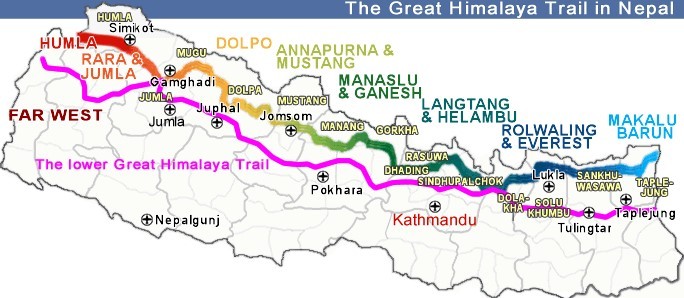
The Great Himalaya Trail: Explore the most exciting hidden corners of Nepal
Table of Contents
About Great Himalaya Trail (GHT)
One of the great trekking “holy grails” is the route through the far-flung peaks of the entire Himalaya range, which links all the established trekking regions in Nepal.
Great Himalaya Trail is reflected as one of the highest and longest trails on the globe, and likely the most dramatic, traversing the totality of Nepal from east to west in the shades of the world’s highest mountains.
The GHT is an opportunity to experience some of the less explored, most exciting hidden corners of Nepal where you will be bump into with awe and marvel at the scale and magnificence of the land, plus the cordiality and humbleness of locals.
If you are an adventure devotee and want to discover the Himalaya and immerse into the authentic culture of local people, the Great Himalaya Trail Trekking is the perfect one. To complete this, it requires a high level of commitment and willing power.

Great Himalaya Trail meanders beneath the world’s highest peaks and visits some of the most isolated communities on the globe, it passes through lush green valleys, arid high plateaus, and fantastic landscapes.
Nepal covers the 1,700 km of the Great Himalayan Trail and begins from the east border of Nepal near Kanchenjunga and goes through the northern part of Nepal comprising Kanchenjunga, Makalu, Everest Region, Langtang Region, Ganesh Himal, and Manaslu Region, Annapurna, Mustang, and Dhaulagiri and goes to the west of Nepal through Upper Dolpo and end at Darchula.
Trekking in Nepal is a key attraction for tourists, however, popular destinations have been limited to the regions of Solukhumbu, Everest , Annapurna , and Langtang . Since the trails here are well maintained and provide the opportunity to explore the Himalayas to both beginner and experienced trekkers. While the other two-thirds of Nepal’s mountain topography, generally reflected ‘off the beaten track receives less attention.
“Today trekking in the Himalayas has become very popular however almost all the trekkers go to just a handful of famous regions-to see Mt. Everest or to go on pilgrimage to Gangotri-and that leaves the other 95% of the wide Himal relatively untouched by trekkers and mountaineers, and it means that the local people in those unfrequented areas do not benefit from the flows of tourism” – Peter Hillary; The Great Himalayan Trail –Pictorial Guide Second Edition
The Great Himalaya Trail hence created a trekking route that crosses both famous areas and other lesser-known places (relatively poor but with huge tourism potential). The trail also links all the less explored destinations together to increase awareness of these trails and bring tourism to the more isolated and less trodden parts of Nepal. The trail was proposed in an effort to boost tourism in some of the relatively unknown and off-the-beaten areas of Nepal.
As an active partner and member of Great Himalaya Trail (GHT) and T ravelife Certified Company , Nepal Sanctuary Treks offers varied itineraries based on GHT the off-the-beaten trails to promote sustainable tourism.
Let’s Explore the Himalayas and immerse ourselves in the authentic culture of local people
Nepal’s Great Himalayan Trail (GHT) officially opened in 2011 and the trail is divided into 10 sections comprising a linkage of upper and lower routes. Each offers different challenges and opportunities and has its own unique combination of remarkable Himalayas scenery and authentic cultural experience. Each GHT section provides a separately marketable trek along the main and cultural path of the GHT of 2-3 weeks in length. Furthermore, there are numerous side treks; some short, some long, some teahouse-style, some camping treks
With such an extensive range of interlinking routes, there are numerous choices for trekkers – either the ‘High Route’ (also known as the Extreme Route) or the ‘Low Route’ (also known as the Cultural Route). The upper route and lower route consume 150 and 99 days respectively.
Locals often state to them as the mountain route and cultural route. Whilst the trekkers might choose to do one or the other, or a combination of both.
The high route and low route are more like guidelines than official routes. There are hundreds of routes throughout the Himalayas. As the maps state, “Every trail is the trail.”
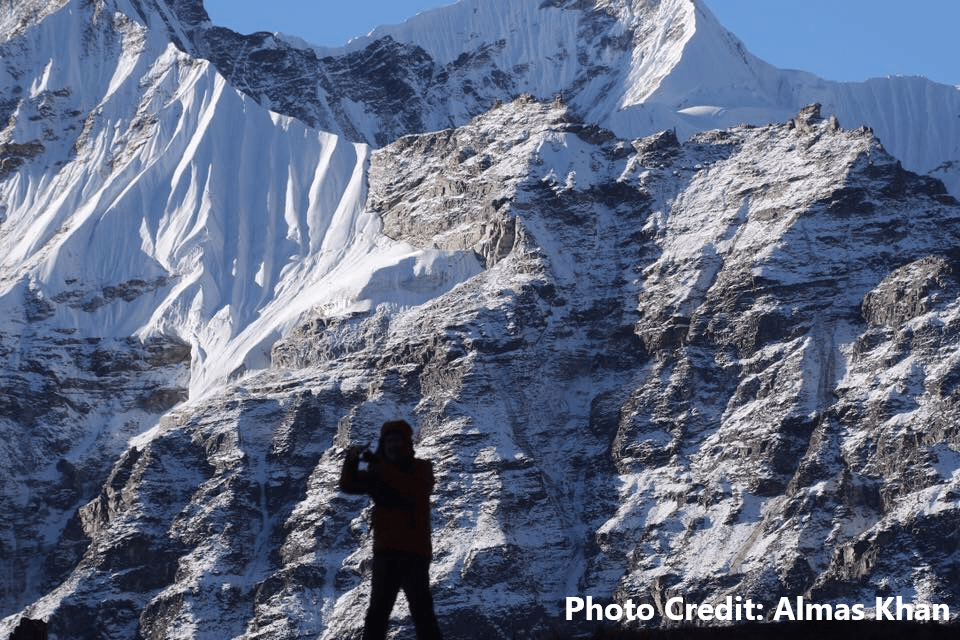
The high route meandering through High Mountain ranges stretches over a distance of about 1,700 km (1,056 miles). The route is on an average altitude of 3,000 to 5,000 meters.
The trail leads in the shadows of the world’s highest peaks, traversing its way over High Mountain passes, windswept plateaus, lush valleys, and incredible landscapes while visiting some of the most far-flung hamlets on the globe, where the life of people have not been touched by modern civilization. Untouched by modernity, people still adhere to their traditional life and culture.
Thus, incredible views, adventure trekking, unspoiled culture, trans-Himalayan backdrop, and alpine valleys are the main highlights of the GHT route. It may take up to 150 days on average to complete high-route treks.
The trekkers who want to embark on the high route trekker must be physically fit with sound health and, ideally, possess some trekking experience; since the trekking involves crossing several high passes and trekking through remote trails. Additionally, the trekkers must prepare proper trekking gear and mountaineering equipment.
Several areas of GHT particularly high routes traverse through the restricted areas where you require permits.
The low route is regarded as easy and is generally well-known as a cultural trek, hence it is shorter than the high route. The low route expands the distance to about 1,500 km (952 miles) and takes about 100 days to complete the whole trek. And the route winds through Nepal’s mid-hills, with an average elevation of 2,000 m.
The route usually comprises stunning lush forests, green rice terraces, and several authentic Nepalese villages of diverse cultures. Additionally, it is often deliberated as the cultural route, hereafter trekkers get an opportunity to visit small hamlets and get insight into the culture and traditions of Nepal’s various ethnic groups.
The Low Route on the Great Himalaya Trail is far easier, as the average elevation is 2,000 meters. The temperatures are usually warmer and there are not any issues of altitude sickness.
The Great Himalaya Trail A Pictorial Guide II Edition
Robin Boustead, an Australian who has been trekking the Himalaya for over two decades, is a modern GHT pioneer. He walked the Great Himalaya route for the first time in 2008 and 2009 with his team (Pema Tsering Sherpa, Lakpa Sherpa, and Karma Sherpa) and successfully completed in 157 days.
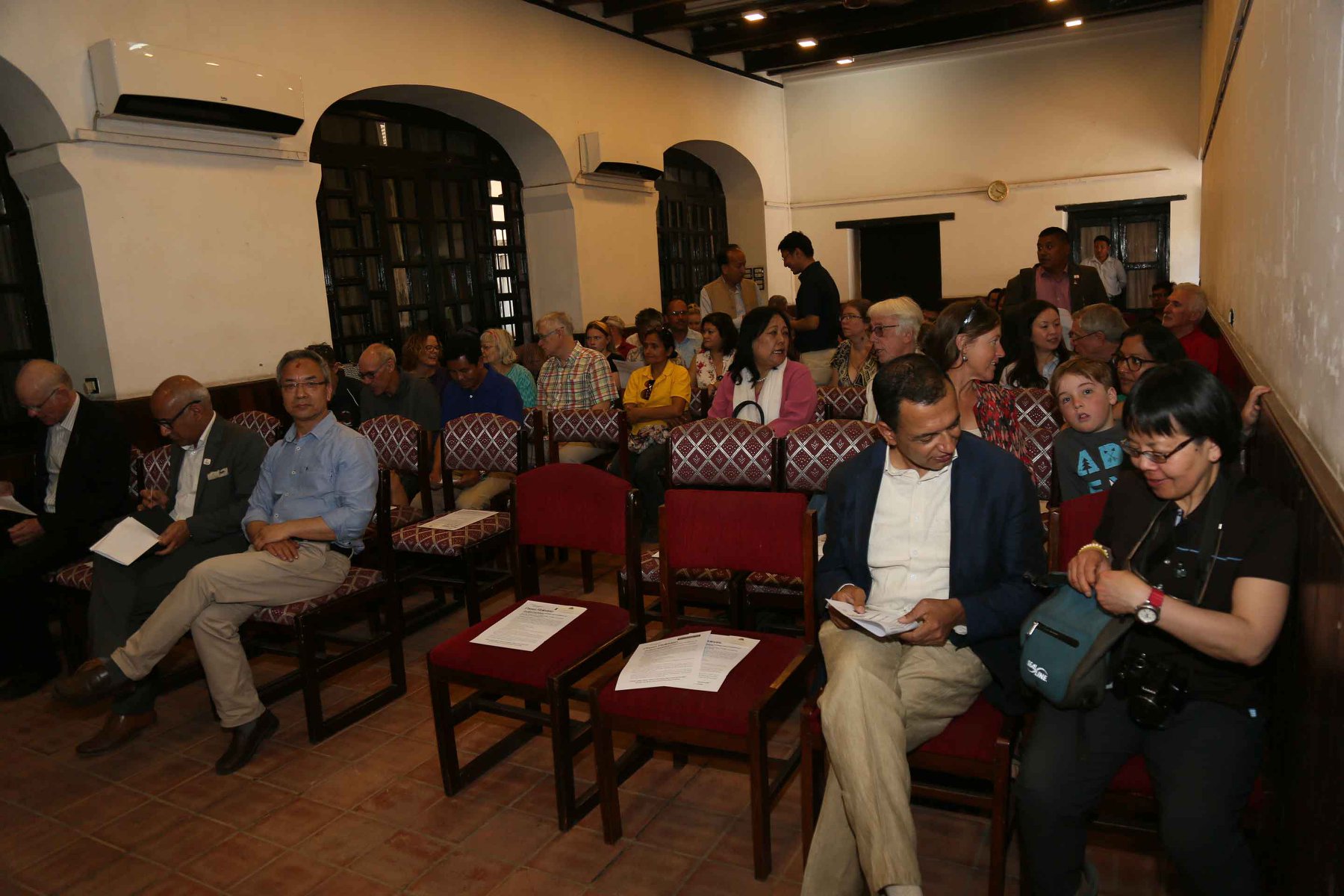
After the successful publication of his first edition of “ The Great Himalaya Trail : A Pictorial Guide ”, his second edition launched on April 17, 2019. This pictorial guide encompasses the most well-known routes along with the Nepal Himalaya ranges and some less explored locations. The book is expected to update visitors about Nepal’s geographical and environmental conditions, targeting Visit Nepal 2020.

He uses stunning pictures, the first interlinked sequence of trekking maps for every mountain region, showing the GHT and connecting major trails. This book has a foreword by Peter Edmund Hillary , son of the legendary Sir Edmund Hillary.
Peter’s first summit of Everest in 1990 meant Hillary became the “first family” of Himalayan mountaineering, with two generations of Everest climbers to conquer the feat. He ascent it again in 2002 to celebrate his father’s first ascent.
Peter Hillary has followed in his father’s footsteps beyond just mountaineering. Edmund and the Hillary family have built and run 42 schools, hospitals, and medical clinics for the mountain people of the Solu Khumbu district. At present, there are Himalayan Foundations in six countries to support this work, and Peter Hillary is a board member, fund-raiser, and regular Nepal visitor to carry on this commitment to support the people of rural communities.
He has recently undertaken the trek with his family called “ In Hillary’s Footsteps trek to Everest Base Camp” in April 2019.
Promoting Sustainability
Responsible tourism concerns in Nepal are determined by poverty, a lack of education, and simple inefficiency when it comes to infrastructure
The Government of Nepal is now taking consideration in promoting the trail and its sections as a way to bring socio-economic benefits to the people of rural communities. To make this happen, the Great Himalayan Trail focused on promoting “responsible tourism” best practices. This would definitely help to improve local employment and boost demand for locally-produced goods and services at the destinations.
According to Robin Boustead in his book “The Great Himalayan Trail: Pictorial Guide Second Edition
“The long-term goal for the GHT is to see sustainable tourism development along the trail to benefit communities that are too remote for major infrastructure development. Further, by creating value in regions that were thought to have little to offer, he hopes that government will cooperate to create a transboundary corridor for animal migration. This would reduce illegal hunting and help save many endangered species”
Nepal Sanctuary Treks is listed on GHT site and is committed to supporting responsible and sustainable tourism.
Want to know more about Great Himalayan Trail?
Thus, undertaking one of the GHT treks will help to improve the socio-economic condition of isolated communities and employ porters and guides from various regions. In addition, purchasing local food, and handicrafts and staying at local teahouses would help in poverty alleviation and the resilience of local communities.
Related Blog
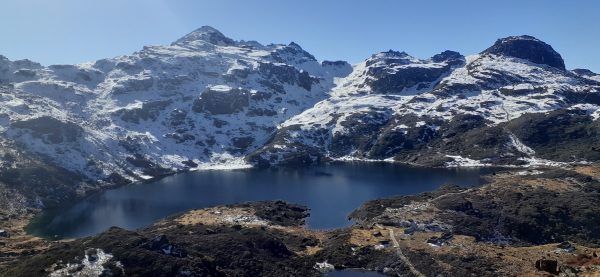
Makalu Base Camp – Trek into the heart of the wildest Himalayas
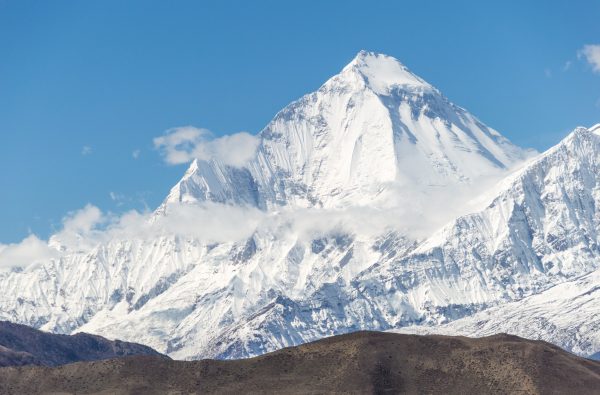
Dhaulagiri Circuit Trek: a Demanding Trek to the Stunning Mountain
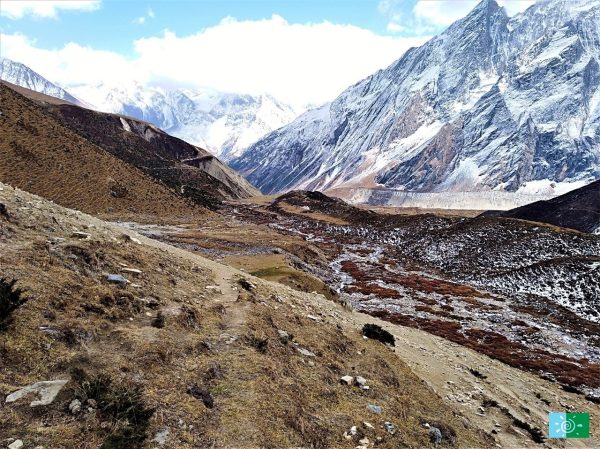
TSUM VALLEY TREKS: Towards the Valley of Secret
Affiliations & recommendations.

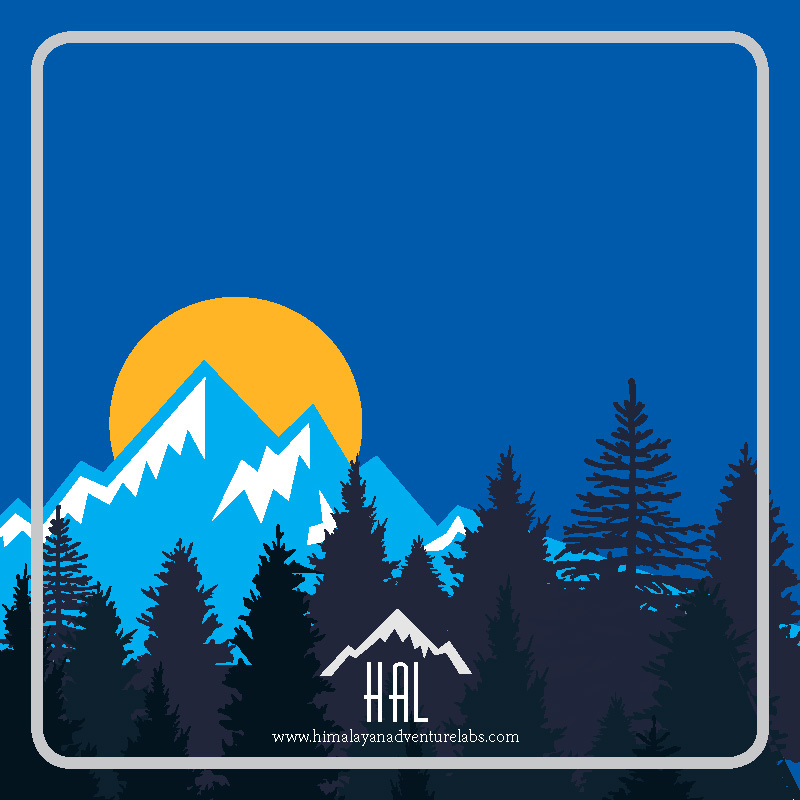
Interactive Map for Great Himalayan Trail
Please see the ‘Route Information and GPX Notes’ below for more information on these tracks and way points. We are always looking for more, please contact us ! All of the GPX files can be freely downloaded from this map. Note that some tracks (especially alternative shortcuts) may be hidden by default. To turn these on, use the symbol on the left side that looks like discs stacked atop one another.
See full screen
Route Information and GPX Notes
GPS tracks are often from 10 minute increments created by a satellite transponder used by Seth Wolpin during a 2014 crossing. In some cases we have more detailed tracks, and alternative routes. We recommend you download them from our file repository (new window) as the embedded maps will lead you to a GPS file limited to 25 way points and you will miss out on possible alternative tracks.
Please use files at your own risk and do not redistribute without permission. Note that many of the files cannot be used to approximate distance as you rarely walk in a straight line for 10 minutes in the Himalaya. Most locals will also refer to distance in hours walking. We found it helpful to ask them for two estimates – a fast walk and a slow walk. In a few cases we do substitute much more precise GPS measures/tracks because we either had plentiful battery power to run a GPS full time, or else we recorded tracks on another trip or someone passed them on to us. (We encourage readers to send their GPS tracks so we can add this info, we will thank you).
Many of the way points were collected by Robin Boustead from his explorations and he also collected many from different people (Shawn Forrey, Bob Rosenbaum, Jamie McGuinness , Richard Bull, and others). These are usually suffixed ‘RB’ in our files. Our tracks, and waypoints themselves are often suffixed ‘RFB’ for ‘Run for the Border’ which was our team name. Seth integrated these and removed duplicates, sometimes translated names from German, and otherwise cleaned things up and integrated into our tracks. For distance estimations, trail narrative and more precise planning, we refer you to Robin Boustead’s book .
If any of this is helpful, we ask that you make a small donation to www.wideopenvistas.org , or to your favorite Nepal focused charity and/or consider contracting with HAL for a basic support package if you are planning a thru-hike on the GHT.
GPS Baselayers
We recommend using Backcountry Navigator with OSM layers. This site looks interesting for commercial base layers for certain areas: http://www.nepalgpsmap.com/en/shop/garmin/
We recommend carrying maps from the Himalayan Map House. Unfortunately, these are often 1:100,000 which makes them very difficult to use for fine navigating. We would appreciate notes from others on higher resolution maps they have been able to find.
We owe a big debt to Doc McKerr who thru hiked in 2013 and was kind enough to give our 2014 team a GPX track automatically recorded by his satellite transponder every two hours of walking.
.webp)
Everest Base Camp Trek
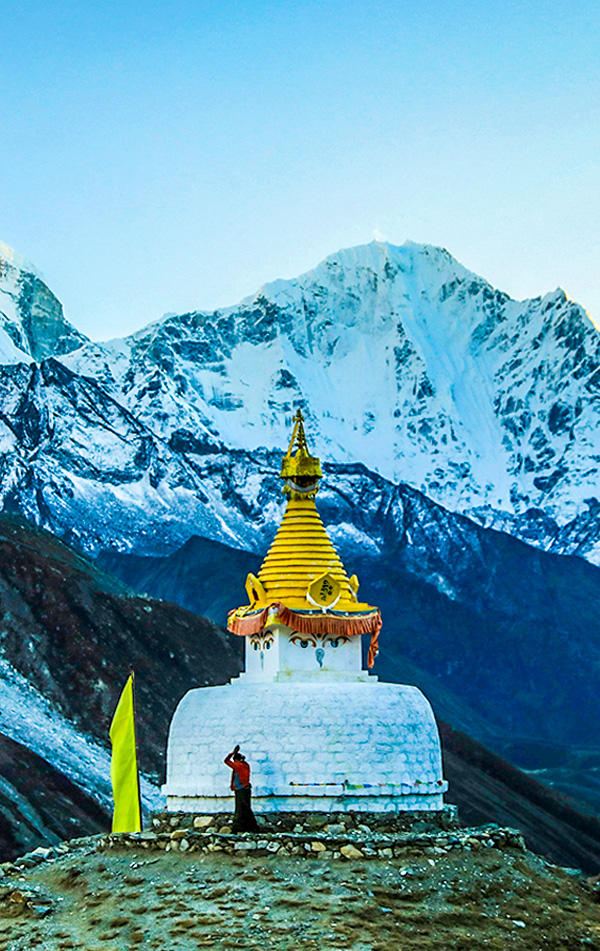
Kathmandu |
Kathmandu | Nepal
Max Altitude
Trekking Km
Help & Support
67000 /person $ /person.
- October-2024
- November-2024
- USD 1500 +5% GST for Non-Indians
- +5% GST (Goods and Services Tax)
- Services from Kathmandu to Kathmandu.
- Lukla flight, Food & Stay in Kathmandu included.
Offload 5300
Backpack offload is optional
Choose add-ons during booking. If missed, log in and add them later.
Book off-load at least 10 days before the trek.
For offline bookings at the base camp, a convenience fee of Rs. 6500 applies.
Cancellations made before the trip date will receive a full refund.
For more information. Please complete this form.
Help & Support
Trek Name: Everest Base Camp Trek
Adventure Type: Trekking
Base Camp: Kathmandu
Season: Summer | Autumn |
Month: March | April | May | September | October | November |
Country: Nepal
Altitude: 18200 Ft.
Grade: Difficult
Rail Head: Kathmandu is not connected to any Railways
Stay: Hotel and teahouse
Food: Meals while on trek & at Hotel/Guesthouse (Veg & Eggs)
Location: Kathmandu
Distance: 108 Km.
Trail Type: Circle trail | Camping in various locations, starting and ending at the same point.
AirPort: Kathmandu (Tribhuvan International Airport)
Why Everest Base Camp Is A Must-Do Trek
When it comes to trekking in the Himalayas, Mt. Everest is the most celebrated peak and not just in our country but all across the globe. For avid trekkers and mountaineers, getting up close to the highest mountain peak in the world is a once-in-a-lifetime experience. This classic trek takes place in the Bagmati Zone of Nepal and allows you to experience the immense beauty of the surroundings. Along your trek, you will get to witness 4 of the 6 highest mountain peaks in the world — Cho Oyu (8,201 m), Mt. Makalu (8,470 m), Mt. Lhotse (8,516 m), and Mt. Everest (8,848 m).
Everest Base Camp is a teahouse trek, which means you will stay at some of the highest villages in the world and get a close look at their cultures and traditions, and life in the remote corners of the Himalayas. Staying at the Sherpa villages you will get to learn a lot about the mountain lifestyle and how inextricably the people are connected to the mountains. There are many notable junctures throughout the trek and Kala Patthar is one such point. Standing at an altitude of 5,500 m it offers an astonishing view of Mt. Everest . EBC trek presents a wonderful opportunity to experience the grandeur of the Himalayas, the imposing challenge and thrill of the climb, and the charming culture of Nepal.
Trekking in Nepal is all about trekking amidst the biggest mountain ranges and on this trek, you will see mountains surrounding you. All along the way, you can feel the sense of legacy left behind by the greatest mountaineers. Crossing the route beyond Namche Bazaar, you will come across, Tenzing Norgay Stupa, a tribute to the great mountaineer, who was the first to scale Mt. Everest along with fellow mountaineer Edmund Hillary. Also, just near Dughla on Everest highway, there are memorials for distinguished mountaineers who dedicated their lives on the slopes.
Reaching Everest Base Camp means trekking through the traditional Sherpa villages, with warm and friendly villagers, hidden Gompas, picturesque mountain views, and exceptional natural beauty. Those who take part in such a trek will never forget the amazing experience.
About The Trek
Your journey will start at Kathmandu from where you will take a short flight to Lukla. The iconic trek starts at Lukla in the southern part and the trail weaves towards Namche Bazaar in the north. We will stay a day here, acclimatizing to the higher altitudes. It then diverges in the northeast direction towards Pheriche and Dingboche. Once we reach Dingboche, we will spend a day at Dingboche as a rest day. From Dingboche, the route continues to Lobuche. Everest Base Camp is a little further east from here and the Kala Patthar viewpoint can be seen towards the west.
There are other variations to the trek route as well, where the trek bifurcates towards Gyoko Ri early on at Namche Bazaar. The route then follows the left side to arrive at the Base Camp. Sometimes people also prefer trekking from Jiri village instead of Lukla, Jiri is a short bus ride away from Kathmandu. However, trekking from Jiri adds a couple of days to the trek as Jiri is considerably further away from Lukla. The EBC trek follows a gradual ascent up to the base camp, following which there is a steep descent. The entire journey lasts for 13 days and in between, we also have acclimatization days as well.
What Can You Expect At The Trek
It is a difficult grade trek. Trekking to the Everest Base Camp requires exceptionally high physical fitness and while the trek is not dangerous, you need to prepare well for it. A variety of factors add to the difficulty of the trek like the terrain, the duration of the trek, the distance covered every day, and the number of days spent at high altitude and a difficult exit in case of emergencies. While all trek is not especially tricky but it is surely an endurance test.
It is a high altitude trek and as such chances of AMS are quite high but with adequate hydration, proper rest, and a well-planned itinerary taking into consideration the acclimatization criteria will help counter such issues. Our trek leaders are mountaineering-certified individuals with a keen understanding of AMS and other high-altitude issues. They can detect the signs of AMS early on and adopt necessary measures for the prevention of the same. Our Trek Leaders are also all Wilderness First Aid Responders, who are diligent in handling emergencies.
The trek from Lukla to Everest Base Camp is 50 km and it takes 13 days to complete the trek starting from Kathmandu. To mitigate the risks of being at a higher altitude for such a long time, we have incorporated acclimatization and rest days in the itinerary. Mt. Everest can be spotted multiple times on the trek even in the initial part of the trial.
In cold conditions, batteries drain pretty quickly be it phones, cameras, or Kindles. Make sure to bring spare batteries with you. Some teahouses allow you to charge your phone and other electronics but they will charge you for it.
Be prepared for extreme weather conditions as the weather at high altitudes is unpredictable. Layer properly to regulate your body temperature and stay comfortable while trekking. When its sunny, the weather can get quite warm and you may even have to discard a couple of layers in the first few days of trekking, however, the temperature at night drops pretty quickly. Make sure to drink a lot of water to stay hydrated and avoid altitude sickness. Also, remember that sunburn happens much quicker at higher altitudes so always wear sunscreen and keep your sunglasses ready.
Accommodations at Everest Base Camp will be in teahouses in Sherpa villages or mountain lodges. Also, keep enough cash with you as there are no ATMs in Lukla. Also, if you want to do some last-minute shopping for trekking gear and equipment, Kathmandu is a good place to do so.
- Who can Participate
- Important Links
- How to Reach
- Trek Essential
Who Can Participate
- Age; 15 years.
- Experience of any high altitude trek, at least 1 treks of 4,000m/13,100ft.
- The climber must be fit and have sufficient stamina to cover 6 km of distance in 35 minutes without stress.
- The climber should be able to carry a 12-16 kg backpack.
Arrive At Kathmandu
- Altitude: 1,400 m/ 4.600 ft.
- Spend the day exploring Kathmandu.
- A short briefing session in the evening.
- Stay in a hotel (included in cost).
Welcome to trekkers’ paradise, Nepal. Nepal is characterized by beautiful Himalayan summits, rich natural biodiversity, and beautiful culture and history. Once you arrive at Kathmandu airport, you can take a taxi to the booked hotel in Kathmandu. There are loads of taxis available at the airport and you can easily find one to drop you off at the hotel. Once you check in to the hotel, you can freshen up, and in the evening, you will receive a briefing session where you will learn about the trek and your schedule for the upcoming days. If you have any questions about the trek, then you can clear them at the time of the briefing session. Post the briefing session, you can explore Kathmandu and do some last-minute gear and equipment shopping if you want.
Note that, from April 2019 most flights have been diverted to Ramechhap airport due to construction and crowding at Kathmandu Airport. Ramechhap is a small Airport Ramecchap in Manthali and 4 hrs drive away from Kathmandu. In this case, your flight will be booked for the next day. So take an early night flight to Kathmandu and get ready to leave Kathmandu City by 1 o’clock so that you can take an early morning flight from Ramechhap airport.
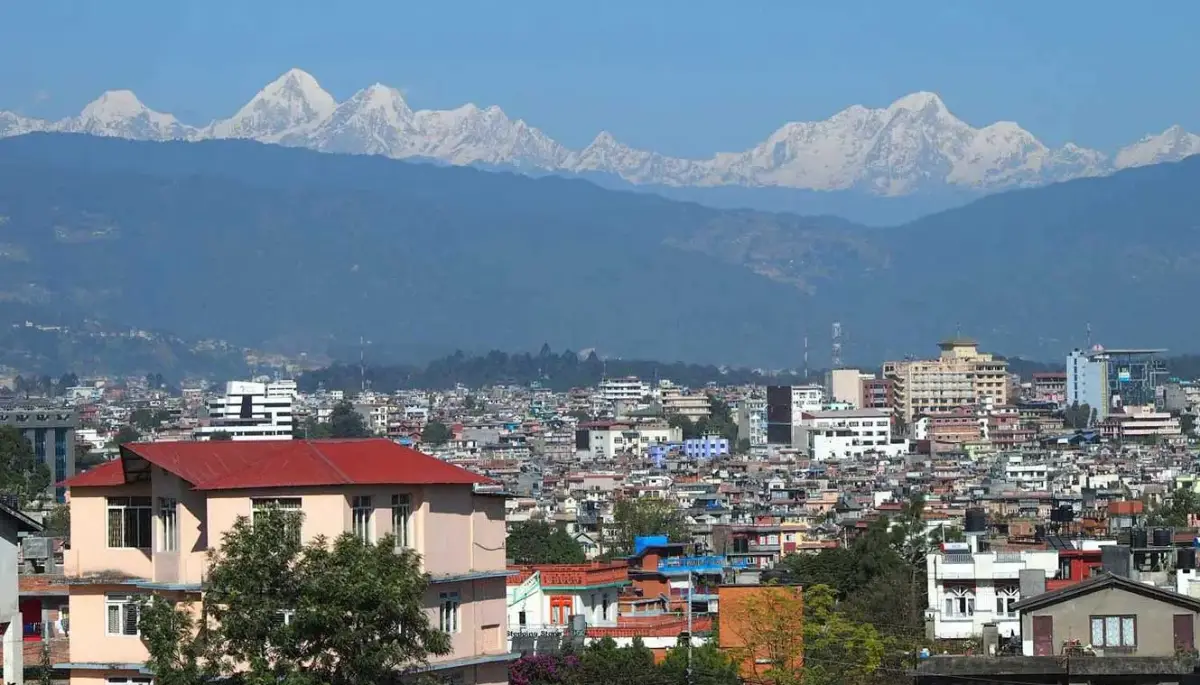
Fly to Lukla, Trek To Phakding | Enjoy A Scenic Flight Journey
- Altitude: Lukla - 2,850 m/ 9,350 ft | Phakding - 2,600 m/ 8,500 ft.
- Trek Distance: 9 km | 4-5 hrs.
- Altitude Gain: 1200 m/ 3,900 ft.
- Early morning flight to Lukla (30 minutes).
- Easy and gradual descent.
- Cheplung village lies en route from where you can see Mt. Khumbila.
- You can buy or refill your water bottles from teahouses on the way.
Get ready for a beautiful flight from kathmandu or ramechap to Lukla. Its a short flight of about 35 minutes that will take you over a panoramic landscape. On these flights, the planes are quite small but the journey is quite scenic. Our representatives will meet you at Lukla airport and this is where your trek towards Everest Base Camp starts.
After arriving at Lukla, we will start our trek towards Phakding after some refreshments. The trail is 9 km long and passes through Nepali mountain villages, green mountains, suspension bridges, and forests to Phakding. It takes about 4 to 5 hrs to complete the trek. From Lukla, the trek begins with a gradual ascent, with a few ups and downs along the way. Along the route, you will witness amazing views of Kusum-Kanguru as you cross a suspension bridge on your way. After a short climb, you will arrive at Ghat Village and after another one and a half hours of gradual walking, you will arrive at Phkading. En route, you will also spot boulders that are carved with Buddhist Prayers. We will stay overnight in Phakding.
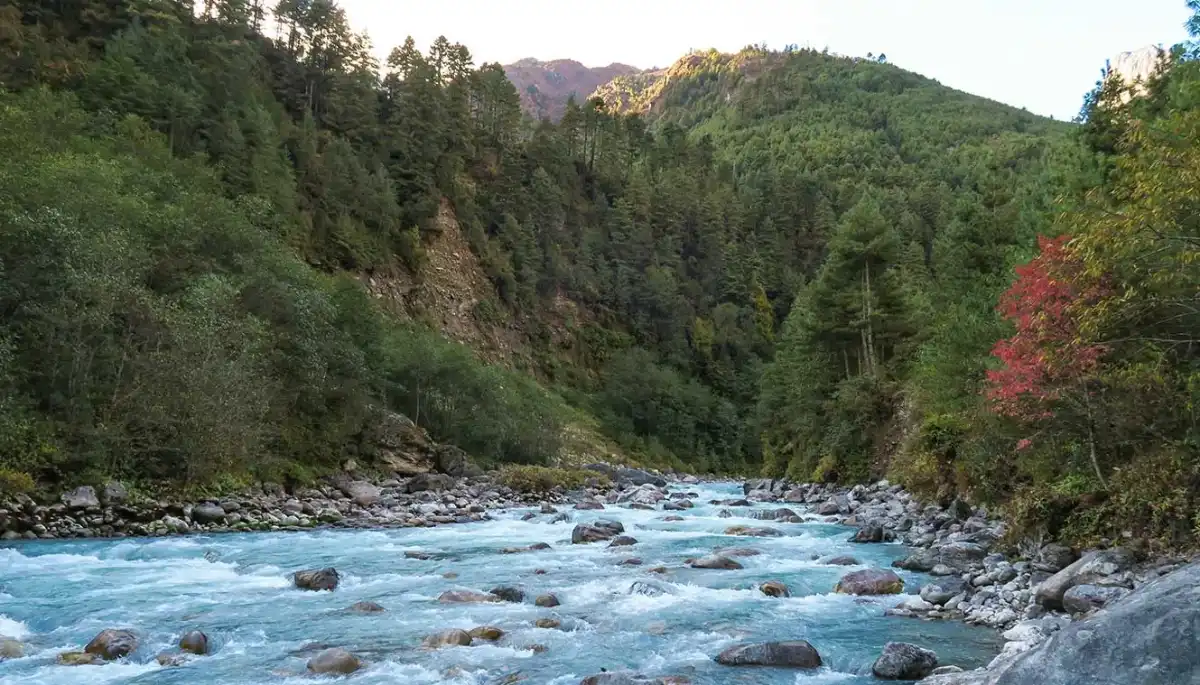
Phakding To Namche Bazaar | A Major Trading Hub In Khumbu
- Altitude: 3,450 m/ 11,300 ft
- Trek Distance: 10 km | 7 hrs.
- Altitude Gain: 850 m/ 2,800 ft.
- Moderate level of climb and steep climb before Namche Bazaar.
- Namche Bazaar is the capital of the Khumbu region.
- You will get the first views of Mt. Everest today.
- You will spot Kongderei and Thamserku Peak.
- Monjo village is the mid-point of the trek.
- A Swiss suspension bridge on the Dudhkosi River. It is one of the major attractions.
- Dudhkosi River is considered the lifeline of the Khumbu Region.
- Today you will enter the Sagarmatha National Park (a UNESCO World Heritage Site).
Post breakfast, we will start our trek toward Namche Bazaar. The route today is surrounded by green mountains and will take you through suspension bridges over the Dudh Koshi and Bhote Koshi rivers. Before entering the Sagarmatha National Park, you will have to obtain permits and then the trail follows a steep ascent before arriving at Namche Bazaar. Namche Bazaar is an important trading hub of the Khumbu region.
We will start our trek early in the morning from Phakding and soon you will cross a suspension bridge over the Dudh Koshi River, the walk from here is easy and pleasant with short uphill and downhill climbs. You will cross another suspension bridge over the Bhote-Koshi River. It is a busy area and you may notice a multitude of trekkers and porters here. After a 20-minute climb from this area, you will arrive at Monjo. Monjo is a pit stop for many trekkers and many people also camp here. At Monjo, you will see interesting watermills that are used to grind barley, a staple diet of the Sherpas. Monjo is situated right below the majestic Thermasarkhu peak (6,608 m) and quite close to this village is the entrance to the Sagarmatha National Park.
Treading along the Dudh Koshi River, you will arrive at the Sagarmatha National Park. At this point, your trekking permit will be checked and the officials will keep a record of all the trekkers going ahead. Sagarmatha is a UNESCO World Heritage Site that showcases stunning mountain views and rich biodiversity. Here, you may spot rare Himalayan species like snow leopards and the lesser panda. The presence of Sherpa settlements with their unique culture makes the trek even more interesting. A gradual walk from Sagarmatha National Park will lead you to Namche Bazaar. From Namche Bazaar, you will catch the first glimpses of Mt. Everest. Namche Bazaar is a historic trading center of the Khumbu area and you can stock up on essentials from this point. At night we will stay here at a guesthouse.
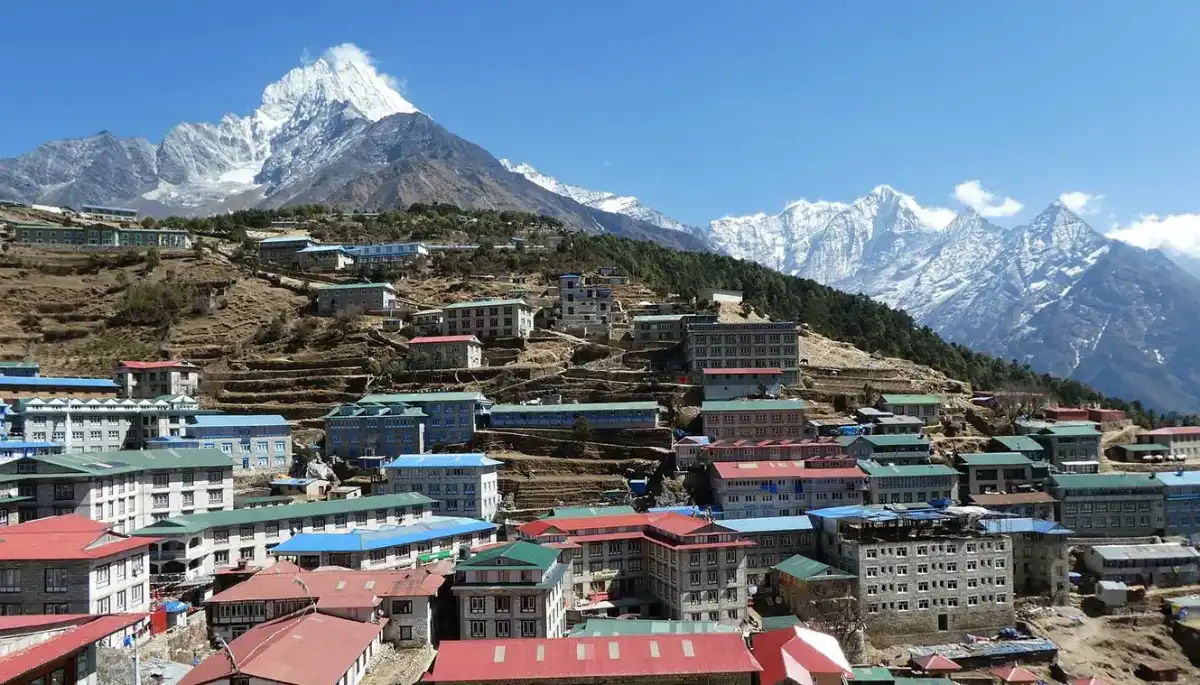
Acclimatization Day | Explore Namche Bazaar
Wake up to the beautiful views of the highest Himalayan peaks and enjoy a delicious breakfast. Today we will stay in Namche Bazaar allowing our bodies to acclimatize to high altitudes. You can spend the day exploring the surroundings and enjoy the culture and hospitality of Nepal. Namche Bazaar is a commercial hub so you can do any last-minute trek shopping from here. The market has a vibrant atmosphere and there are a couple of restaurants and coffee shops as well.
You can do a short hike to Sagarmatha National Park headquarters. From here, you can get a good view of Ama Dablam, Mt. Everest, and other Khumbu peaks. Sherpa Cultural Museum is close by and lies just above Namche Bazaar. The museum gives you a fair amount of details about the history of the Himalayas, the geographic and cultural aspects, mountaineering history, and information about the various flora and fauna in the region. You will see many pictures of Tenzing Norgay and Edmund Hillary from their climb and maps detailing their trails as well. In the evening, take acclimatization walks around the market, preparing your body for higher altitudes. Soak in the Nepalese Buddhist culture, food, and traditions. Namche Bazaar gained popularity during the time when Tibetan salt was traded for grains from Nepal\\s lowlands. Nowadays, you can see a roaring trade of rugs, clothing, dried meat, and salt in the village center. There are many shops that also offer locally made handicraft items, you can buy them as souvenirs or gifts for your friends and families. You will stay the night at a guesthouse in Namche Bazaar.
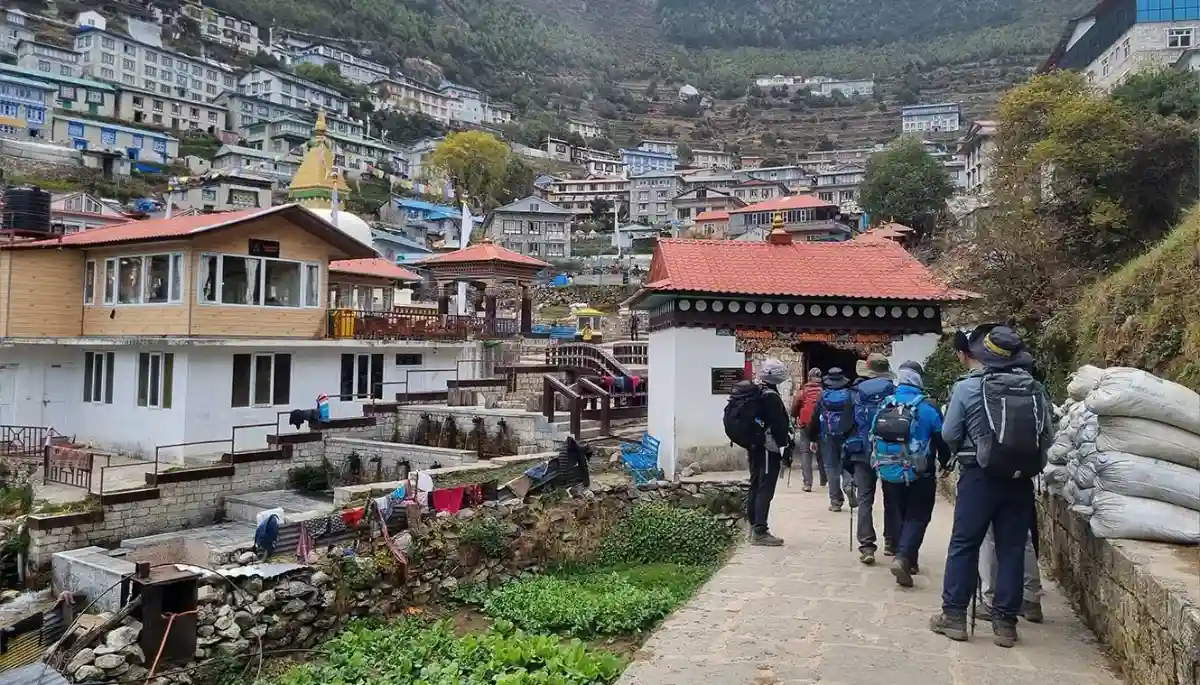
Namche Bazaar To Tengboche | Visit The Largest Buddhist Monastery Of Khumbu
- Altitude: 3,850 m/ 12,650 ft.
- Altitude Gain: 400 m/ 1,350 ft.
- Trek Distance: 8 km | 5 - 6 hrs.
- Mixed ascent till Phunki Tenga.
- Steep ascent after Phunki Tenga to Tengboche.
- Tengboche has the biggest monastery in the area.
- You can attend a prayer ceremony held by the monks to invoke protection on your expedition.
- Cross another high bridge at the village of Phunki Tenga.
Start your day with a delicious breakfast and get ready for your trek to Tengboche from Namche Bazaar. It’s an 8 km long trail and is a fairly easy trek accompanied by the views of the majestic Himalayas. You will also spot Himalayan Wildlife on the way as well.
Tengboche is a small alpine valley that is situated at an altitude of 3860 m and the trek starts with an easy walk. The trek from Namche Bazaar to Tengboche is extremely beautiful and along your trek, you will get a bird’s eye view of Dudh Koshi River down below and the epic mountain views as Thamserku (6,608 m), Kantega (6,782 m), Ama Dablam (6,812 m), Lhotse (8,516 m) and Everest (8,849 m) comes into view.
A 20-minute walk from Namche Bazaar will take you to the top of Namche Bazaar. From here the trek descends to Khumjung, a Sherpa village and then climbs up the sides of the mountains through some stairs and then diverges from the Everest Highway at Sanasa. You will be able to catch glimpses of Lhotse, Nuptse, and Mt. Everest from here. This is probably the best view of Mt. Everest you will get until you reach Gorakshep when climbing to Kala Patthar. Two hours of pleasant walking will bring you to Sanasa. Up to Sanasa, it is a walk-through forest covered with Oak and Rhododendrons. It is a great location for bird watching and you may spot the Danphe Pheasant, the national bird of Nepal. Musk-deer and Himalayan Tahr, a Himalayan goat that looks like an antelope are commonly spotted in these areas. You will also spot the Tengboche monastery from here which you will reach in the later part of your trek.
Next, following a gradual descent, you will reach the Imajtse River at Phungitenga at an altitude of 3,250 meters. Phunki Tenga is a small Himalayan settlement with teahouses and army posts. The climb down can be a little tougher as the terrain is rocky and uneven. You will reach a suspension bridge over the river and after you make the crossing, you will need to get permits at a checkpoint to proceed further in your trek. From here it is a strenuous climb of about an hour that will take you to a Buddhist monastery just before Tengboche and finally to Tengboche village. This is the last part of today’s trek and you can expect the trail to be rocky with a couple of switchbacks. Don’t push yourself too hard, take it slow and steady as you make your trek uphill.
Tengboche Monastery, locally known as Dawa Choling Gompa is the largest monastery in the Khumbu region. It overlooks the beautiful region and the mountain landscapes around it. There are daily prayers that occur around 7:00 am and once around 3:30 pm. You can take part in the prayers if you truly want a cultural experience. It is one of the important cultural aspects of the EBC Trek. Enjoy the serenity at this revered place of worship and night your stay will be in the guesthouses at Tengboche.
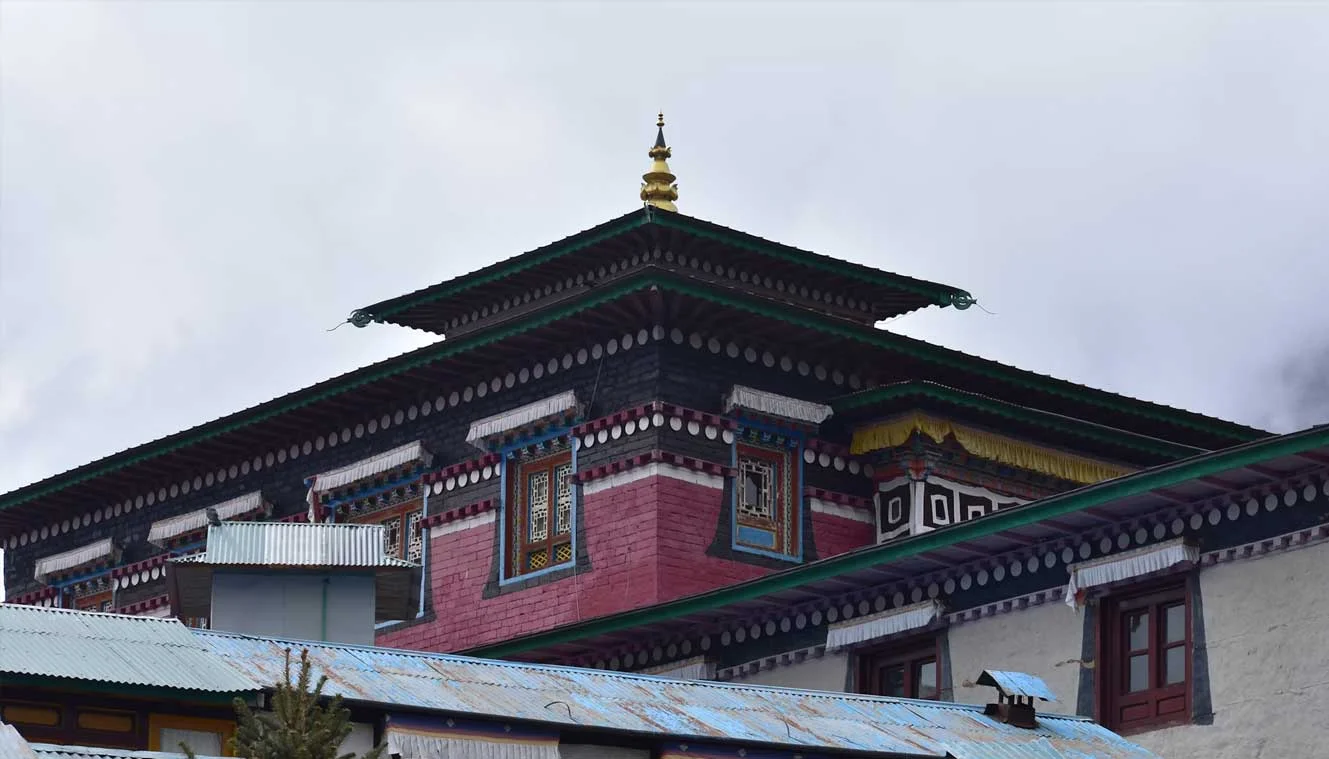
Tengboche To Dingboche | Stunning Views Of Ama Dablam
- Altitude: 4,350 m/ 14,250 ft.
- Altitude Gain: 500 m/ 1,600 ft.
- Trek Distance: 9 km | 6-7 hrs.
- Gradual descent and a little bit of ascent after Lobuche River to Dingboche.
- The trail passes through lush forests of birch, conifer, and Rhododendron trees.
- The route offers amazing views of Ama Dablam standing over you.
- The trail crosses the Imja River to reach Pangboche.
- Continue along the Imja Valley and Lobuche River before ascending to Dingboche.
Today, we will begin our trek towards Dingboche. From Tengboche, cross bridges and rivers accompanied by beautiful mountain views to Dingboche. Stone steps will lead you through forests of Rhododendrons, conifers, and birches, and at the bottom of the forest lies the Deboche village. From here, the trail rises and enters into the alpine meadows and Dingboche. Dingboche is the only place in the entire Khumbu region where barley is grown. The views of the Himalayas are amazing from Dingboche. Start your trek from Tengboche and walk towards Pangboche Village, you will get to see some beautiful views of Mt. Ama Dablam and from Pangboche we will trek towards Pheriche and to Imja Valley. The beautiful Lobuche River passes through Imja Valley and from here a steep hike will take you to Dingboche. The trek takes about 6 to 7 hrs and for the most part, the difficulty is moderate.
At the beginning of the trail, you will first descend into a forest trail passing the small settlement of Deboche. As you trek from Tengboche to Dingboche, the scenery changes as you gain altitude, greenery slowly giving way to barren landscapes, and the trails gradually becoming more rugged and it will also start getting cold and windy. In the initial part of the trek, you will pass by a wall with stone inscriptions and a small stream will keep you company along the trail. You will have to cross the stream to the left-hand side of the valley. The majestic Ama Dablam dominates the skyline ahead of you. About two hours into the trek, you will arrive at Pangboche, a mountain village, where you get beautiful views of Mt. Everest. From Pangboche, you will hike upwards towards the valley, and throughout the trek, you will slowly gain elevation. Although the trek is mostly uphill, the slope is relatively easy without extremely steep inclines. Ama Dablam continues to stay in view, however, you will only get to see a tiny sliver of the top of Mt. Everest. Lhotse and Nuptse become quite prominent now.
Soon you will arrive at the village of Shomare, your last village before Dingboche. Ama Dablam remains in view but now you will get to see a different angle of the mountain from what you have seen before. The trail continues winding to the valley side and you will cross another river before entering Dingboche village. Dingboche is a lovely Himalayan hamlet and you will see agricultural fields protected by stone walls. Once at the village, we will check into a guesthouse and we will stay the night in the guesthouse.
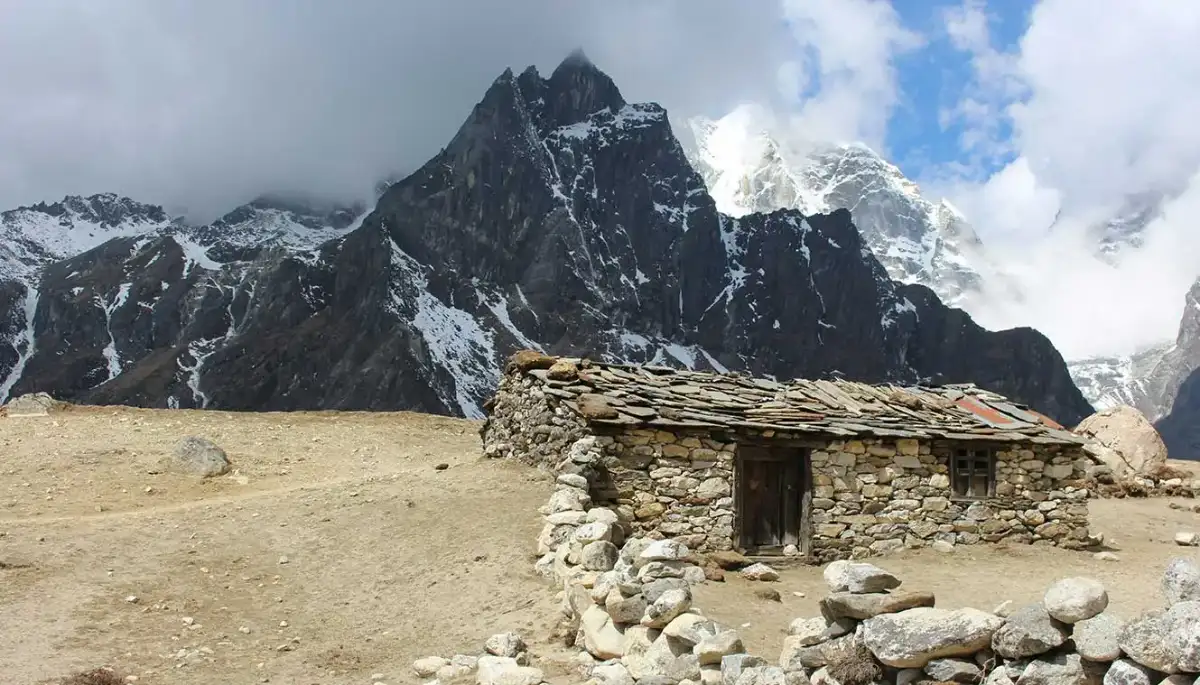
Dingboche (Rest Day) | Acclimatize To Higher Altitudes
Today is a rest day at Dingboche, which will help us acclimatize to the high altitude. As we exert a good deal of energy on the trek, our body needs to get accustomed to less oxygen at higher elevations. So instead of taking a rest day, if continue to gain elevation it can result in altitude sicknesses like dizziness, nausea, and headache or potentially even more dangerous conditions like cerebral or pulmonary edema. To prevent these issues, we start our acclimatization process at the 11,500 ft mark. Since Namche Bazaar is quite near that elevation, we start our acclimatization process from Namche Bazaar itself.
For acclimatization, you can walk around the village. Dingboche village has many farms and crop fields sparse across the village, native crops include barley, potatoes, and buckwheat. You can also do a short hike around the village to Chukung. Its a 3 - 5 hrs trek that takes you to an altitude of 4,730 m. Chukung lies in the Imjatse Valley towards the east. Although the trek is gradual you can feel the effects of thinning air. Chukung has a couple of teahouses as well and you get a superb view of the surrounding areas from here. Some of the views are exceptionally beautiful as you continue to climb higher and higher. Explore the valley and the surrounding areas, return back to the guesthouse. This hike will prepare your body for the next few days at higher altitudes.
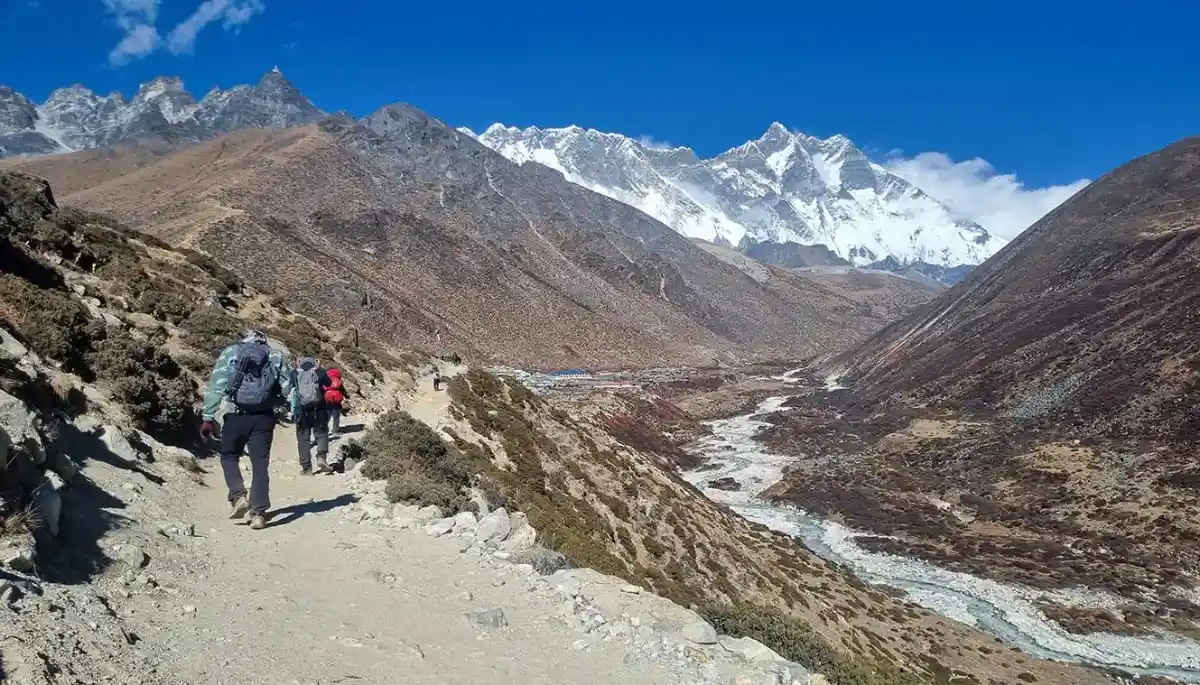
Dingboche To Lobuche | Pay Your Respects In Everest Memorial
- Altitude: 4,950 m/ 16,200 ft.
- Trek Distance: 7 km | Duration: 6 hrs.
- Altitude Gain: 600 m/ 1,950 ft.
- Tricky climb on moraine and rocky terrain.
- You can visit the memorial shrine.
- The top of the ridge is filled with prayer flags and stones which are memorial shrines for climbers who lost their lives on Mt. Everest.
- As you cross Khumbu Glacier, you will see Mt. Nuptse (7,861 m).
Today’s walk will take you from Dingboche to Lobuche through alpine pastures and in the summertime, you can see Yaks grazing in these pastures. You will trek towards the end of the moraine of the Khumbu Glacier offering spectacular views of Mt. Nuptse. At the moraine, you will see stone monuments, these are dedicated to six Sherpas who died in an avalanche along with monuments dedicated to other mountaineers. From here, it’s a steep climb towards Lobuche where you will get a magnificent view of Mt. Nuptse and the sunset over this mountain peak is even more spectacular. From Dingboche, you will have to ascend a small ridge behind the village, towards the north you can see Lobuche Peak (6119 m) and the snowfields of Cho La. Later you will cross Khumbu Khola, the huge glacier moraines of the Khumbu Glacier flowing from Everest. Crossing the memorial cairns, and following the valley stream, you will arrive at Lobuche in the early afternoon. The 6 hrs trek covers 7 km and brings us much closer to the Everest Base Camp.
Start the hike from Dingboche along the inclined path running alongside the mountain’s wall and go further into the valley. As you make your turn along the path and inside the valley, you arrive at the village of Pheriche, we will be staying here on our way back from the base camp. For the next 2 to 2.5 hrs, you will follow into the valley, while the incline is not very difficult but you are at a high altitude, so take it slow and steady and avoid using too much energy too quickly. A river lies in front of you and crossing the river, you will arrive at the village of Thukla. This is a great spot to rest for a couple of minutes, refuel yourself and continue on the trek.
The next part is going to be the toughest part of the trek today as you climb to Lobuche. The climb takes you along a zig-zag path all the way to the Thukla Pass and it becomes steeper and steeper as you climb until you reach the edge of the Khumbu Glacier and the Everest Memorial. The oxygen gets less and less from here and the temperature also starts to get lower. The remaining part of the trek follows the left side of the glacier as you reach the village of Lobuche and you will also gain a little elevation from the glacier as you arrive at Lobuche. In front of you, you get to see a beautiful view of Nuptse in front of you. Lobuche is a small Himalayan village with only a handful of teahouses. We will stay the night here before we head out to the last village on the trek tomorrow.
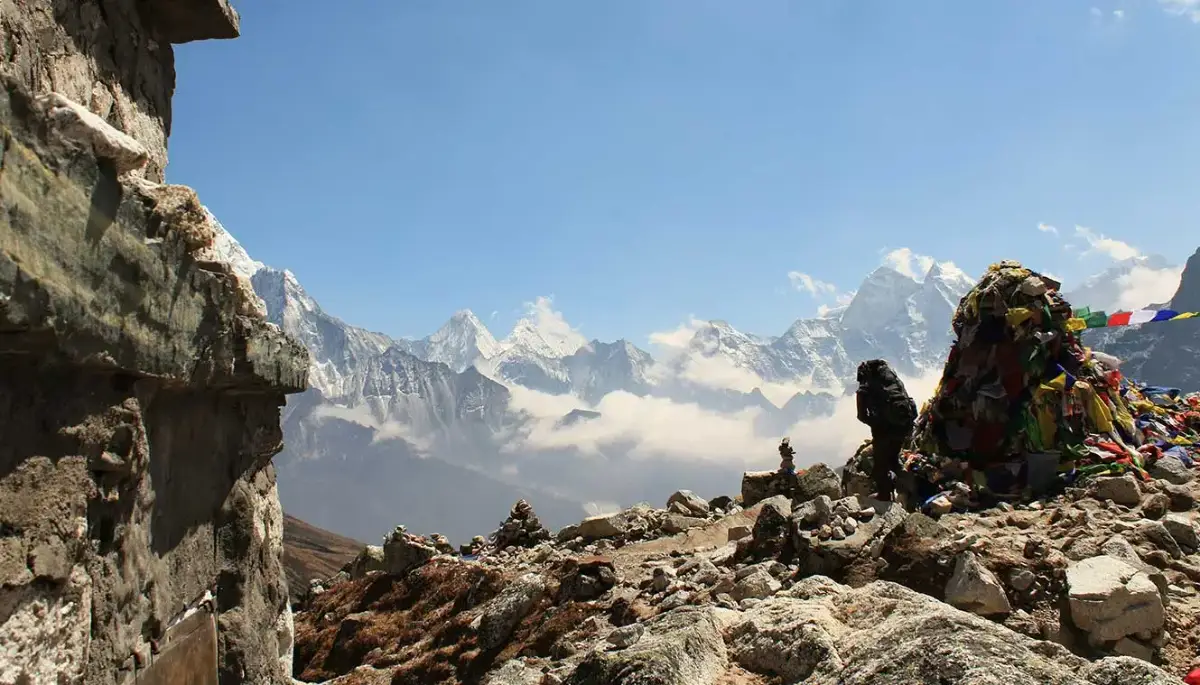
Lobuche To Gorkhashep | Excursion To Everest Base Camp
- Altitude: Gorakshep - 5,150 m/ 16,900 ft | Everest Base camp - 5,350 m/ 17,700 ft.
- Altitude Gain: 200 m/ 800 ft.
- Lobuche To Gorakshep : 6 km | 3-4 hrs.
- Gorakshep To EBC : 3 km away each | 3hrs.
- It’s Everest Base Camp Day Today.
- Good steep climb to Gorakshep.
- It takes about 3 to 4 hrs to reach Gorakshep.
- Lunch is at Gorak Shep.
- A steeper climb to Everest Base Camp.
- The trek to Everest Base Camp is not very difficult.
- Trekker's stop point is just below the actual base camp.
- Most tour groups are not allowed to enter or stay in EBC.
- Make sure you carry your day pack since you will need water.
- You can enjoy amazing views of Nuptse, Khumbutse, and Pumori mountains from the base camp.
- Overnight stay in Gorakshep.
Note: Drinking water in Gorakshep is chargeable. We don’t include drinking water on the trek which you can buy from a number of places between $1 to $3 a bottle (it gets more expensive towards the base camp). The better alternative is to buy water tablets in Kathmandu/Pokhara for around $2 and treat the water.
Today is the most exciting day of the trek as you make an excursion to the Everest Base Camp. An adventurous journey and a great trekking experience await you. Waking up early, have your breakfast, and gear yourself up. We will follow the trail from Lobuche through narrow gaps in the mountains and glacial moraines along the Khumbu glacier to Gorak Shep, the last village on the trek. Post lunch in Gorak Shep, we begin our trek to the Everest Base Camp, the ultimate adventure of this entire journey. We follow the lead of Sherpas as the trail changes every season as the glaciers move. It takes about 7 hrs of walking to reach Everest Base Camp. Spend some time at the base camp, celebrate your victory, capture some stills, and descend back to Gorakshep. Overnight stay will be at Gorakshep.
The trek today can be broken down into two parts, the first part is the trek from Lobuche to Gorakshep and the second part is an excursion to EBC and back to Gorakshep. After breakfast at Lobuche campsite, we begin our trek towards Gorakshep. It is a 6 km hike that takes about 4 hrs. Walking along the sandy and rocky parts, you will gradually gain elevation as you walk alongside the Khumbu Glacier. Mt. Nuptse looms on the horizon in front of you. Some sections of the trail are a little steeper than others. On the way, you will pass Sherpa flag monuments indicating that you are getting closer to the Everest Base Camp.
The last section of the trail directs into a glacier before you reach Gorak Shep. the terrain is rocky and uneven with inclines and declines. Be cautious and watch your step in this part and always pay heed to the trek leader's advice to complete the patch safely. You can see a sliver of the top of Mt. Everest from here, right behind Nuptse. Soon the village of Gorak Shep comes into view guarded by Kala Patthar and Pumori in the back. Make your way into the guest house have some lunch, reenergize yourself and get ready for the next part of the trek.
From Gorak Shep, you will walk right along the Khumbu Glacier, the Everest Range lies right behind it. It is a vast glacier and as you continue walking along the side of the glacier, you will constantly gain elevation until you reach the base camp. The incline is not very steep and is slightly moderate. A technical terrain lays ahead of you with a mixture of sand and rocks and it can get pretty slippery at some points as well. As long as you watch your steps, you will be good. Continue on and you will reach a point where the Khumbu icefall comes into better view as it winds down from the mountain to the valley. More Sherpa prayer flags mark the way to the base camp. In the final stretch of the trail, you will see numerous prayer flags flowing in the wind and the popular Everest Base Camp Rock. You have made it to the Base Camp, congratulations! While this is not the actual base camp, it is a trekker’s base camp. Most tour groups are not allowed to enter or stay in EBC. Once you have had enough time to enjoy the area around EBC, it is time to head back to Gorakshep. Follow the rocky trail back to Gorak Shep. We will stay the night in Gorak Shep.
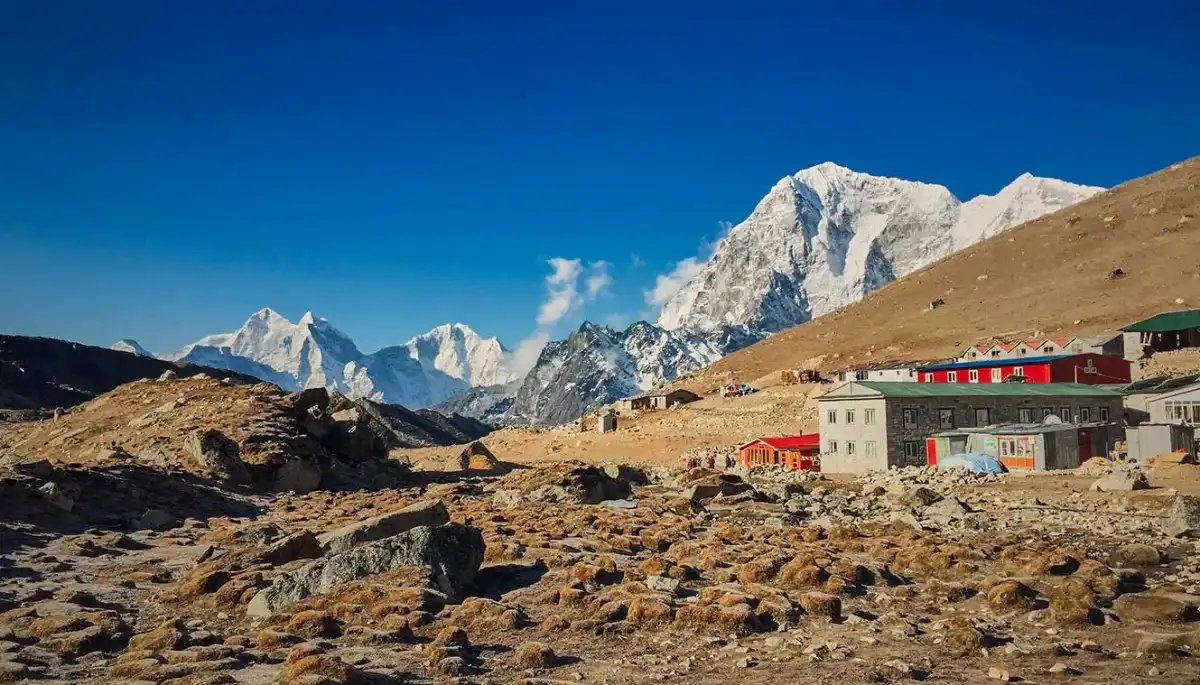
Hike To Kalapatthar And Retreat Trek To Pangboche | Enjoy Arresting Views Of Mt. Everest
- Altitude: Kalapatthar - 5,550 m/ 18,200 ft | Pangboche - 4,000 m/ 13,100 ft.
- Gorakshep To Kalapatthar: 2 km each way | 3 - 4 hrs.
- Gorakshep To Pangboche: 18 km | 6-7 hrs.
- Altitude Loss: 1,150 m/ 3,800 ft
- Steep climb to Kalapatthar (difficult).
- Gradual descent to Pangboche.
- Start early in the morning to avoid early morning clouds.
- Kala Patthar is the rocky hilltop below Pumori.
- Views from the summit: Everest, South Col, Lhotse, Makalu, Khumbu Glacier & icefall, Pumori & Everest Base Camp.
- Breakfast at Gorakshep after the Kalapatthar hike.
After your trek to EBC and back to Gorakshep, you are now ready to climb Kala Patthar. Gorakshep is also a good place to roam around, it has a couple of teahouses and it also used to be the base camp for climbing Mt. Everest in the 1950s. The trek starts with an easy walk from Gorakshep and you will be walking on sandy fields. After this, there is a steep climb of 45 minutes. After the strenuous climb, you will come to level fields and the walk is easy and gradual. You will have the comfort of walking for the next one hour, post which there is another steep climb to Kalapatthar for about half an hour. Mt. Everest from this point looks closer than you can imagine. From here, you will trek down to Pangboche.
Start your day early and leave your stuff at Gorakshep, only carry a daypack with the essentials as you will return to Gorakshep. As you cross the sandy trail and begin ascending, you will notice the Gorakshep village and Khumbu Glacier behind you including Ama Dablam. The top of Mt. Everest begins to peek out above the surrounding mountain ranges. The more you gain altitude the more Mt. Everest will come into view. The best part of today’s trek is that all along the trek you can enjoy the landscape of the surroundings and not just on the summit. The higher you get, the rockier and trickier the trail gets. Be mindful and watch your steps. The last patch is especially rocky.
The summit is a little difficult to navigate as well. You will know you are near the summit when the Sherpa prayer flags and weather reading device come into view. Take your time and dont rush to the summit to avoid any accidents. Once you reach the summit, you will get to see the breathtaking views of the entire Sagarmatha National Park but the main attraction is of course Mt. Everest itself. You will get the best view of Mt. Everest from here. Below Everest lies the Khumbu icefall that feeds into the Khumbu Glacier and to the right is the face of Mt. Nuptse. On the opposite side of the lake, you will see even more glaciers, lakes, and mountains, as far as your eyes can see. After spending some time at the top, descend the same path that you came in. When you are back in Gorakshep have a nice meal and refuel yourself as we will descend to Pangboche.
On the trek down, the first village will be Lobuche and throughout the trek, you will again be alongside the Khumbu Glacier. You have already completed this section while ascending up so you now have an idea of what to expect. The trek is a little tricky till Sagarmatha National Park sprawls out in front of you and the rest of the part is manageable. You can have some snacks at Lobuche before heading down to Pangboche.
As you descend, you will come to the intersection where one path diverges towards Dzonghla village, Cho la pass, and Gyoko Ri, and the one on the left heads towards Pangboche. Stay on the left side of the trail and you will come across another difficult patch of the trek. You will head down from the moraine wall of the Khumbu Glacier and descend to the Thukla Pass. Crossing the Everest Memorial, begin a tricky hike down to the river below and soon you will arrive at Pangboche.
Pheriche lies just below Dingboche so after crossing Thukla, you can take the lower path towards Pheriche instead of taking the higher path towards Dingboche. Once we arrive at Pangboche, you will check into a teahouse, have your dinner, and rest for the night before heading down to Namche Bazaar the next day.
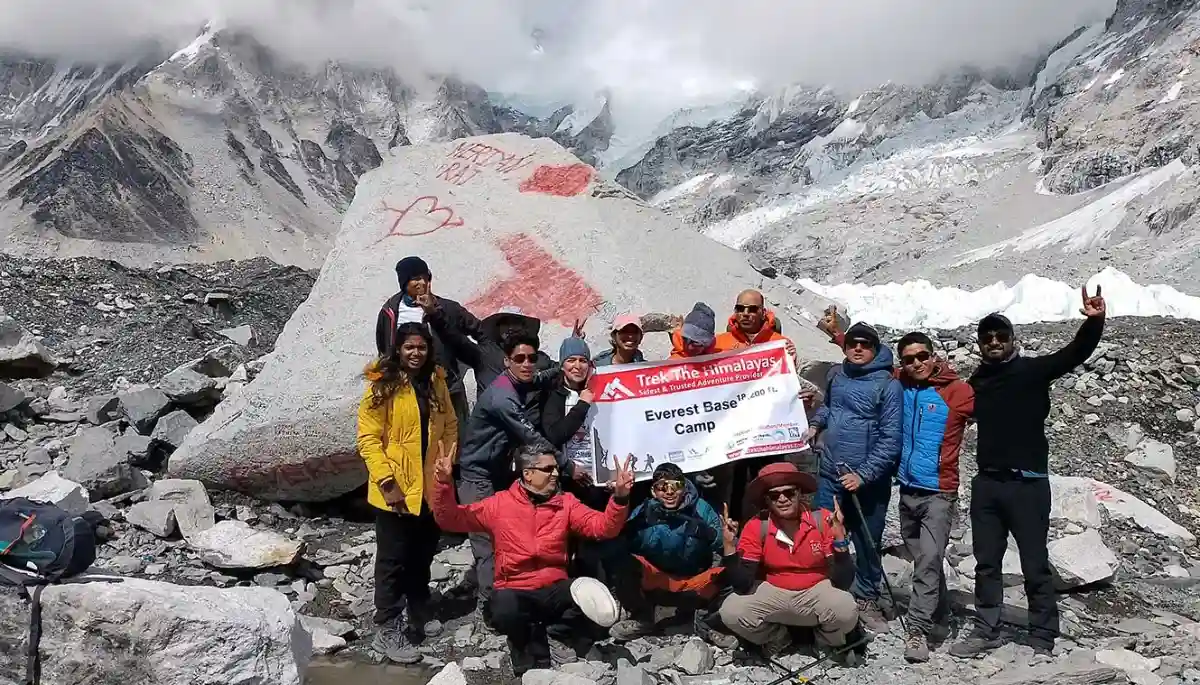
Pangboche To Namche Bazaar | Buy Some Souvenirs
- Altitude: 3,450 m/ 11,300 ft.
- Trek Distance: 12 km | 6 - 7 hrs.
- Altitude Loss: 550 m/ 1,800 ft.
- Moderately, continuous descent and short ascent just before Namche Bazaar.
After your descent to Namche Bazaar, the cumbersome part of the trekking is almost over. From here on the descent will be easy after having the Everest Base Camp trek. But we recommend starting early as it is a long walk. Start the journey by heading down to the village, across the river, and again climbing back up the valley wall. You can rest here for some time, and catch your breath before resuming your decline down the valley.
Once you have declined the path, you will cross a suspension bridge followed by a 2 km incline along the valley wall. As you zig-zag up towards the trail, it becomes forested and once you have completed the uphill ascent, it is a fairly smooth walk for the remaining 5 km to Namche Bazaar. The path to Namche Bazaar is etched on a valley wall and there’s the river below. Soon the path bends inwards and you are welcomed with views of Namche Bazaar. Descend down to the village below and check into a teahouse. Rest well. Tomorrow will be the last day of your trek.
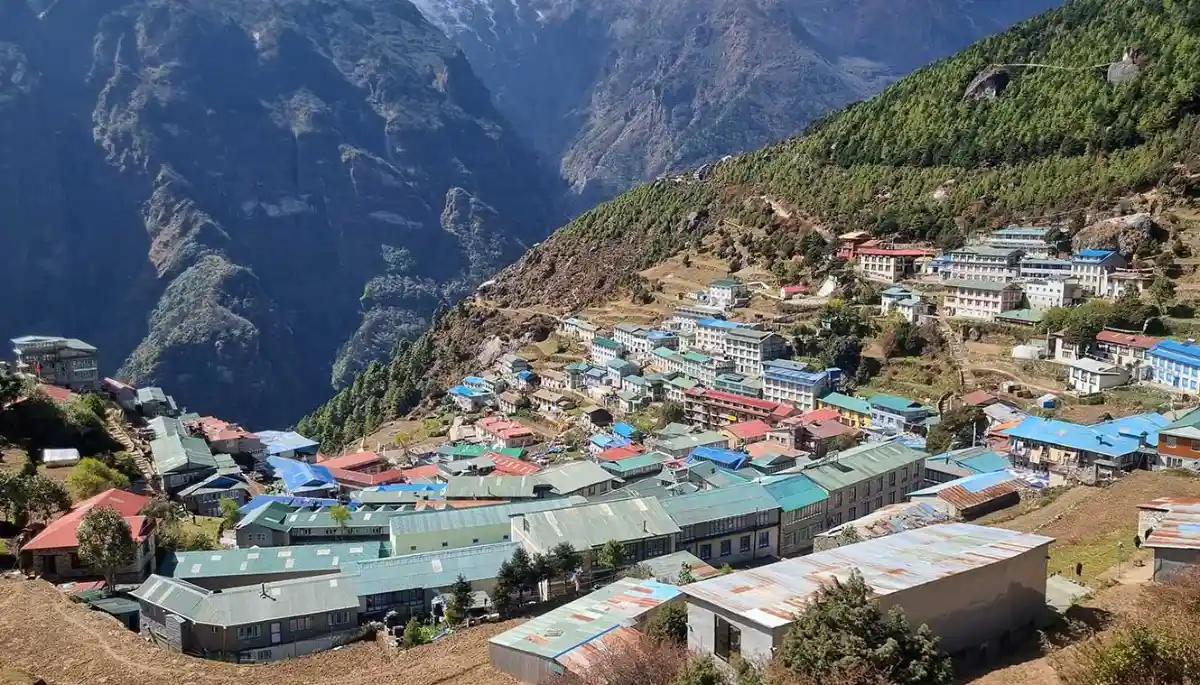
Namche Bazaar To Phakding To Lukla | Last Day Of Trekking
- Altitude: Phakding - 2,600 m/ 8,500 ft, Lukla - 2,850 m/ 9,350 ft.
- Altitude Loss: 600 m/ 1,950 ft.
- Trek Distance: 19 km | 7 - 8 hrs.
- Moderate, continuous descent till Phkading and gradual ascent to Lukla.
- Start your trek early in the morning as it is a long day trek.
- Stop at Phakding for lunch.
- Stay in Lukla.
Waking up to the lovely weather at Namche Bazaar, you can visit the place and roam around a little bit. You can explore the market and buy souvenirs from your trip to the Everest Base Camp and buy gifts for your friends and family. There are several local handicraft stores in Namche Bazaar as it is the biggest trade hub in the Khumbu region. You can also take a small walk-in around the Sagarmatha National Park and enjoy the local cuisine as well. Post which treks down to Phakding, it is an easy trek down to the village. The beauty of the distant mountains with several waterfalls adds to the beauty of your journey. This is the beauty of Nepal trekking, there will be a few uphill climbs but you will manage it very easily. The lush green beauty and forests will take your pain away. After this easy walk, you will reach Lukla. This will be your last day with the Sherpas and other crew members, so you would like to enjoy the day with a delicious dinner and a few drinks.
Right at the beginning of the trek, you will begin to lose elevation, after about 45 minutes of walking, you will arrive at a rest stop, the same that you came in on when ascending towards the basecamp. This is where you will get the last glimpses of Mt. Everest. After this point, there are no mountain views anymore only little peeks from behind the forest covers. You will cross a few suspension bridges and continue alongside the river as the initial steep decline eases into a more moderate decline. While most of the trek is downhill, there are a few uphill climbs as well. Pass by Sherpa stones into the village of Phakding. You are more than halfway to Lukla by now. We will stop at Phakding for lunch before descending further down the valley with river views, mountain ridges, and suspension bridges. You will also have several stair sections and an incline path all the way through. Passing by a few more villages, you will arrive at Lukla, your final stop for the day.
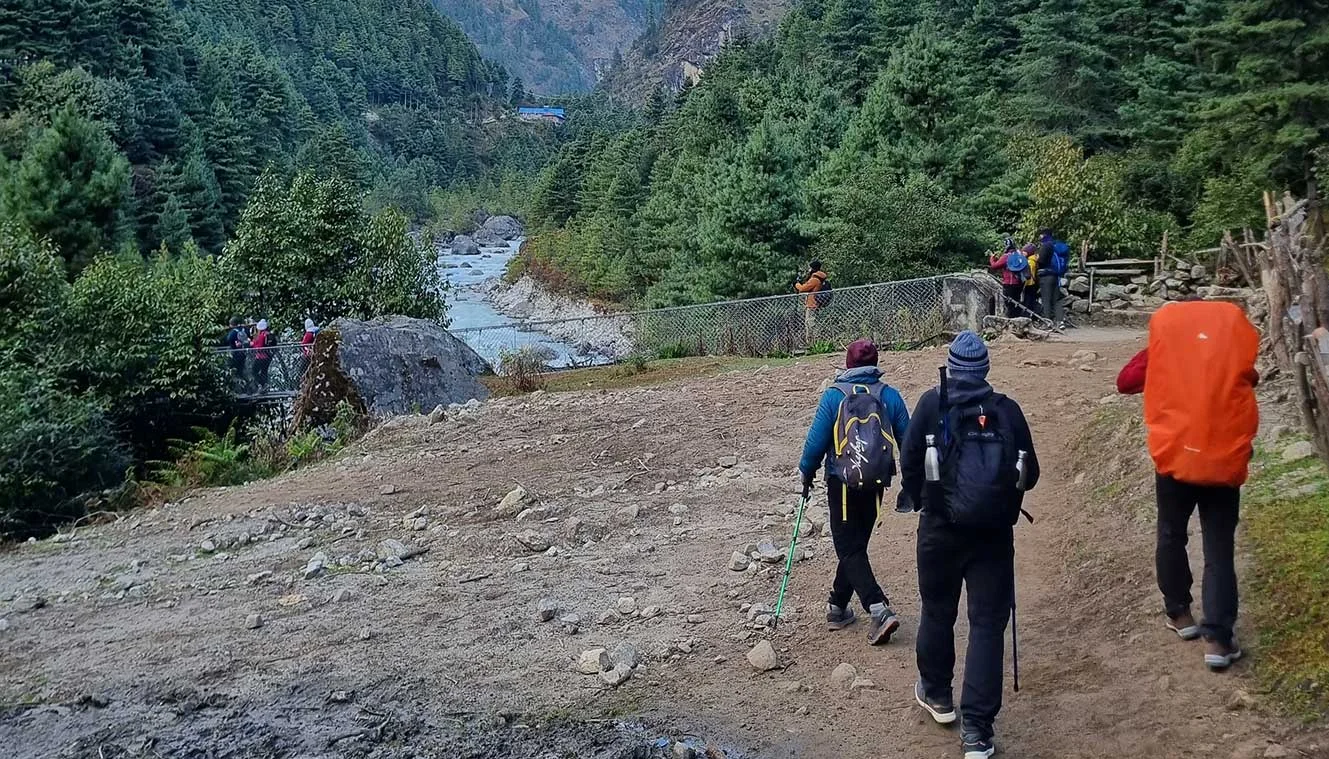
Fly Back To Kathmandu | Bid Adieu To The Mountains
- Morning flight to Kathmandu.
- Your trek to Everest Base Camp is over.
- Spend the day in Kathmandu or fly back to your onwards destination.
- Hotel accommodation in Kathmandu is included in the cost.
Note: Weather conditions may cause flight cancellations. Delays are possible any time of the year but are more typical on summer departures. Keep one or two buffer days.
Today you will have to wake up early as flights to Kathmandu are generally scheduled in the morning. This is because during the daytime, the weather is generally windy and there might be a delay in the flight timings. However, you can expect a slight delay in your early morning flight as well if the weather is not suitable. As you make your way through the security checks and your flight takes off from Lukla airport, you will have a magnanimous view of the surroundings. Drive back to Kathmandu from Ramechhap Airport and overnight stay in a hotel. You can book your further journey from here. We wish you a great journey towards your home with lots of memories.
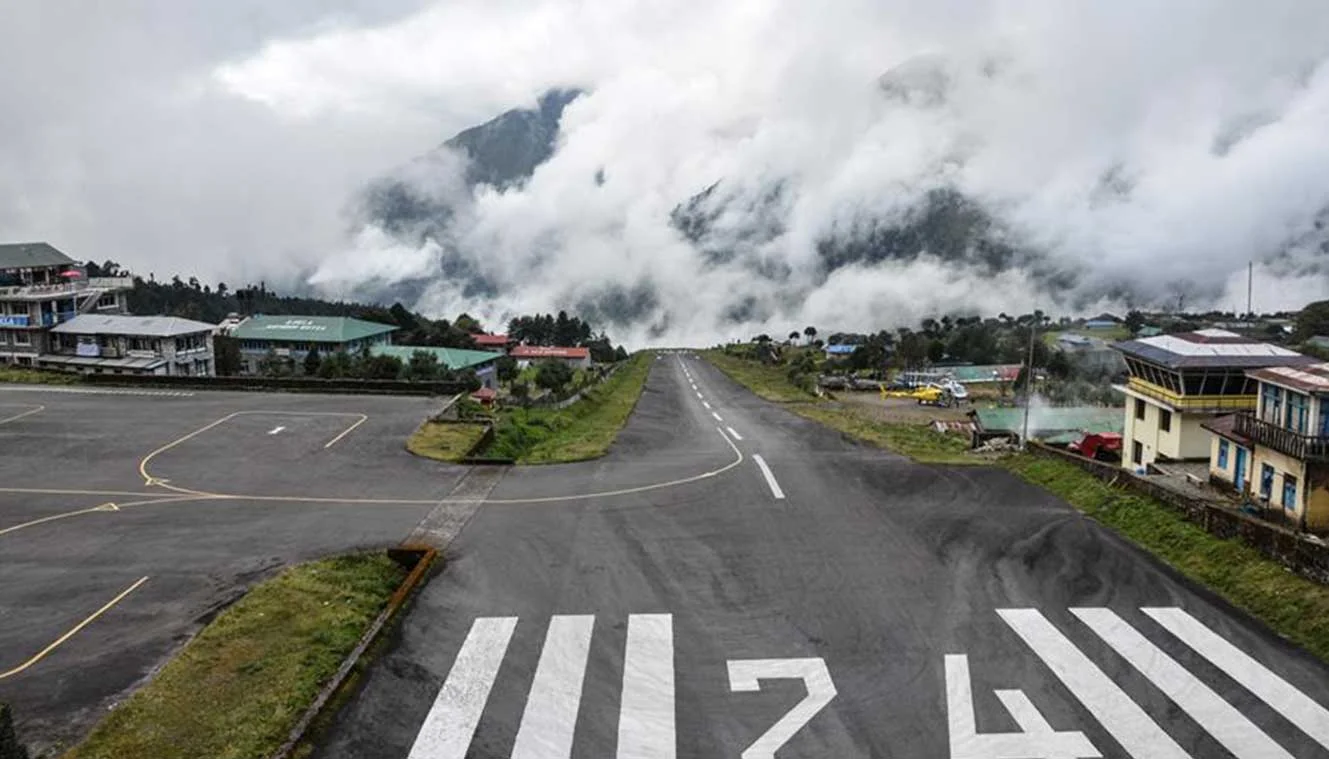
Day-1: Arrive At Kathmandu
Day-2: fly to lukla, trek to phakding | enjoy a scenic flight journey.
- Altitude: Lukla - 2,850 m/ 9,350 ft | Phakding: - 2,600 m/ 8,500 ft.
Note: Flights to Lukla are prone to delay due to weather, keep one or two buffer days in your plan.
Day-3: Phakding To Namche Bazaar | A Major Trading Hub In Khumbu
- Trek Distance: 10 km | 7 hrs.
Day-4: Acclimatization Day | Explore Namche Bazaar
- Today is acclimatization day.
- You can hike up to Sherpa Cultural Museum to get a view of Everest and Ama Dablam.
- It’s worth exploring the town, a good place to buy trekking gear.
- ATMs, internet cafes, shops, and restaurants are available at extra cost.
- Stay in the guesthouse.
Day-5: Namche Bazaar To Tengboche | Visit The Largest Buddhist Monastery Of Khumbu
Day-6: tengboche to dingboche | stunning views of ama dablam, day-7: dingboche (rest day) | acclimatize to higher altitudes.
- Rest Day helps you acclimatize well to high altitudes.
- A small hike today will show you the world’s six tallest peaks including Lhotse (8,516 m), Makalu (8,463 m), and Cho Oyu (8,188 m).
- From another location, you can see the Imja Khola Valley and Dingboche Valley.
Day-8: Dingboche To Lobuche | Pay Your Respects In Everest Memorial
- Trek Distance: 7 km | 6 hrs.
Day-9: Lobuche To Gorkhashep | Excursion To Everest Base Camp
- Gorakshep To EBC : 3 km each way | 3hrs.
Day-10: Hike To Kalapatthar And Retreat Trek To Pangboche | Enjoy Arresting Views Of Mt. Everest
Day-11: pangboche to namche bazaar | buy some souvenirs, day-12: namche bazaar to phakding to lukla | last day of trekking.
- Altitude: Phakding - 2,600 m/ 8,500 ft | Lukla - 2,850 m/ 9,350 ft.
Day-13: Fly Back To Kathmandu | Bid Adieu To The Mountains
Note: Weather conditions may cause flight cancellations. Delays are possible any time of the year but are more typical on summer departures. Keep one or two buffer days.
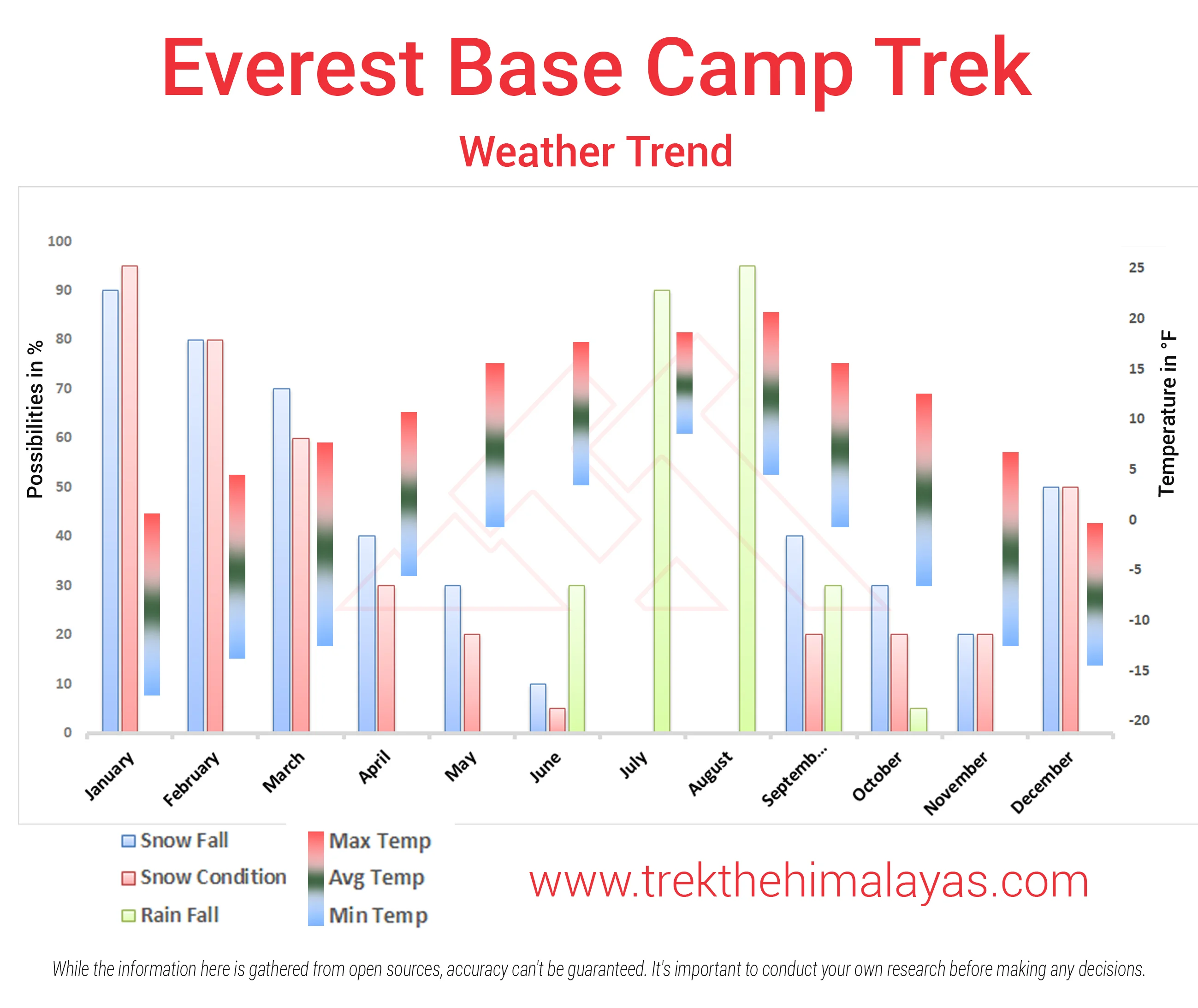
Pulse rate at rest must be in between (60 to 90 beats per minute).
Blood Pressure Reading must be in between (DIASTOLIC 70 – 90, SYSTOLIC 100 - 140 mm Hg).
Respiratory rate at rest must be in between (12 to 20 breaths per minute).
Should not have Liver and kidney issues.
Should not have Diabetes Mellitus, Bronchial Asthma, Heart problems, Hypertension, etc.
No pacemaker implant.
People with Sinus issues, Epilepsy please contact to trek coordinator before booking the trek.
If your BMI is not normal, Please contact our Trek coordinator before Trek booking.
Medical & Disclaimer Form (Mandatory Documents) Click here to download Medical & Disclaimer Form
- Government Employees can avail the benefit of Special Casual Leave (SCL) when they join us for a trekking expedition. As per the rules of the Pay Commission, Special Casual Leave can be availed for up to 30 days in a calendar year for trekking/mountaineering expeditions through a registered organization. Trek The Himalayas is a registered adventure tour operator by the Indian Mountaineering Foundation (IMF) and the Ministry Of Tourism (MOT).
- Trekkers have to apply for leave at least 20 days before the trek departure date.
- This service is exclusive to Indian government employees and is applicable only for treks within India.
- Do mail at info@trekthehimalayas to apply and mention your booked trek date and trek name.
Junior trekkers (below 15 years) should have a company of parents/guardians.
Trekkers between 15 to 18 years can come solo with the disclaimer form signed by parent/guardian.
- Medical & Disclaimer Form (Mandatory Documents) Click here to download Medical & Disclaimer Form
Exercise For Difficult
Fitness Regime For:
Calculate Your Bmi
Your BMI value is
Congratulations, your body is in good conditions!
Medical & Disclaimer Form (Mandatory Documents) Click Here.
How To Reach
It is essential for everyone to arrive at Kathmandu (1:00 pm).
Upon booking the trek, you are required to come to our hotel. Your trek coordinator will provide you with details such as the name of the Kathmandu hotel, its location, and the contact person's number.
Options to reach Kathmandu.
The best way is to fly to Kathmandu Tribhuvan International Airport, which receives airlines mostly from South-east Asia and Europe. A number of direct flights fly from Delhi, Mumbai, Kolkata, Bangalore and Varanasi to Kathmandu. Popular airlines that operate regularly are Jet Airways, Air India, IndiGo and Nepal Airlines.
Delhi to Kathmandu by train + bus :-
Day 1: Take a train from Delhi to Gorakhpur. The Vaishali Express leaves Delhi at around 19:45 and arrives at Gorakhpur Junction at 09:10 next morning, or there's another train from New Delhi at 17:20 arriving Gorakhpur at 06:35 next morning. The fare is around Rs. 2440 (£35 or $54) in AC1, Rs. 1240 (£18 or $27) in AC2, Rs. 785 (£12 or $18) in AC3 or Rs. 315 in Sleeper Class - check current times and fares at www.indianrail.gov.in or www.irctc.co.in.
Day 2: Take a bus or jeep from Gorakhpur to the Nepalese frontier at Sunauli (Indian side) and Bhairawa (Nepalese side, often also called Sunauli). Journey time about 3 hours, Rs. 55 (£1 or $2).
Walk across the frontier, it's then a few minutes’ walk to the Bhairawa bus station. Take a bus or jeep on to Kathmandu. Buses take 9 to 12 hours, cost about 120 Nepalese Rupees or 230 Indian Rupees (£1 or $2). There are many buses daily, either daytime buses leaving regularly until about 11:00 or overnight buses leaving regularly from about 16:00 until 19:00. Indian rupees may be accepted here in Bhairawa, but not further into Nepal.
It's also possible to travel via Varanasi An overnight train links Delhi & Varanasi. Buses link Varanasi with the Nepalese border.
For your return journey from Kathmandu, you have the flexibility to choose between road or air transport options. Please note that our services extend only to the hotel, and the standard hotel check-out time is 11:00 am.

1. Accommodation (as per the itinerary):
- Day 1 and Day 13 Hotel Accommodation in 3 Star Hotel in Kathmandu with Bed & Breakfast.
- Day 2 to Day 12 Accommodation in Teahouse.
2. Meals (Veg + Egg):
- All meals Lukla to Lukla from Day 2 Lunch to Day 13 Breakfast
- Fresh fruit after dinner every day.
3. Support:
- 1 Versatile base camp manager handles communication and deploys extra manpower in emergencies.
- 1 Mountaineering & First aid qualified professional trek Leader.
- Local experienced guides (Number of guides depending on the group size).
- Enough support staff.
4. Trek equipment:
- Sleeping bag.
- Gaiters & Crampon (if required).
5. First aid:
- Medical kit, Stretcher, Oxygen cylinder, Blood pressure monitor, Oximeter, Stethoscope.
6. Transportation (as per the itinerary):
- Arrival Departure Airport Transfer as per itinerary.
- Domestic airport transfers for Lukla.
- Kathmandu to Ramecchap /Lukla, and back.
7. Mules/porters to carry the central luggage.
8. Clock room facility available at the base camp for additional luggage.
9. All necessary permits and entry fees, up to the amount charged for Indian.
10. Services from Kathmandu to Kathmandu .
11. TIMS card.
12. EBC Map.
13. Farewell Dinner in Kathmandu.
14. Trek Completion Certificate
15. Complementary Trekking Kit Bag (Duffle bag if opted for Porter facility).
1. Insurance (Mandatory).
2. Food during the transit.
3. Any kind of personal expenses.
4. Mule or porter to carry personal luggage.
5. Emergency evacuation, hospitalization charge, etc.
6. Anything not specifically mentioned under the head Inclusion.
7. Extra Expenses.
- Porters for the personal bag*.
- Wifi, charging batteries, and hot showers.
- Customary gratuities for guides & porters.
8. Nepal entry visa (approximately USD 40, Bring Two Passport Size photos) only for foreigners (Not for Indians).
9. Unforeseen costs due to flight cancellation, weather conditions, etc.
10. Extra night accommodation in Kathmandu.
Things can be provided on demand and availability (participant has to pay extra for these things).
1- Satellite phone/set phone - a type of mobile phone that connects via radio links via satellites orbiting the Earth instead of terrestrial cell sites like cell phones. Therefore, they can operate in most geographic locations on the Earth's surface.
2- Gamow/PAC HAPO Bag (Portable Hyperbaric Bag) - is a unique, portable hyperbaric chamber for the treatment of acute mountain sickness (AMS), also known as altitude sickness.
3- AEDs (Automated External Defibrillators) - are portable life-saving devices designed to treat people experiencing sudden cardiac arrest, a medical condition in which the heart stops beating suddenly and unexpectedly.
Cancellation terms:
Cancellations prior to 25 days from the start of the Trip
Refund options
- 5% deduction of trek fee
- 100% cash voucher for any trip till one year
- Transfer your trek (any trek, any date) to your friend
Cancellation between 24 days and 15 days to the start of the Trip
- 30% deduction of trek fee
- 100% cash voucher for same trip till one year
- 85% cash voucher for any trip till one year
- Transfer your trek (same trek, any date) to your friend
Cancellation between 14 days and 10 days to the start of the Trip
- 50% deduction of trek fee
- 80% cash voucher for same trip till one year
- 70% cash voucher for any trip till one year
- Book the same trek, in the same season, with any other batch
Cancellation less than 9 days to the start of the trek
- No cash refund
- 20% cash voucher for the same trip till one year
- 10% cash voucher for any trip till one year
- Transfer your trek (same trek, same date) to your friend
Note- If a booking is made using a voucher or discount code, the policies related to vouchers and discounts cannot be modified.
In the unlikely event that TTH cancels a trek prior to the scheduled departure date:
While it is extremely rare for TTH to cancel a trek, we understand that unforeseen circumstances or natural disasters may occasionally require us to do so before the scheduled departure. These circumstances could include continuous rain or snow, thunderstorms, snowstorms, landslides, floods, earthquakes, or any other natural calamity that poses a risk to the safety of our trekkers. Additionally, unforeseeable events such as local riots, curfews, pandemics, lockdowns, government orders, or any similar situations that compromise the safety of the trekking experience may also necessitate a cancellation.
In the event of such a cancellation, TTH will provide you with a voucher equivalent to the amount you paid for the trek. This voucher can be redeemed for any of our treks within the next year, allowing you to still enjoy an adventure with us at a later date.
The issuance of a voucher is not applicable in situations where you are required to descend from the trek for any reason. The trek leader may make the decision to send you down from the trek due to factors such as insufficient fitness level, symptoms of Acute Mountain Sickness (AMS), high blood pressure, exceeding the designated turn-around-time, health concerns, or if you are found smoking, drinking, or violating the rules set for the trek. In such cases, the provision of a voucher does not apply.
In the rare event that TTH shifts a trek:
We would like to emphasize that weather conditions in high-altitude areas are highly unpredictable and can undergo sudden changes at any time, irrespective of the day. Additionally, circumstances beyond our control, such as natural disasters, political unrest, pandemics, and lockdowns, may impact the feasibility of conducting a trek. In cases where we are unable to proceed with an event due to such circumstances that are beyond our direct control, we will make every effort to provide you with an alternative trek that is safer and more suitable.
In such situations, we will issue a voucher to offset the cost difference between the originally scheduled trek and the alternative trek. This voucher can be redeemed at any time within one year from the date of issue. Please note that a refund fee or reimbursement of the cost difference is not applicable in these cases.
- Change of trek batch is dependent on the availability of seats in the batch
- In case of transferring a trek to a friend, he/she should satisfy all the mandatory requirements put forward by TTH
- TTH holds the right to change/cancel the policies, without prior notice
- Cash refund is applicable only in case of bookings made without using any promotional offer code or vouchers
Cash Voucher Terms:
- This is a non-transferable voucher
- The voucher cannot be merged with any other offer of Trek The Himalayas
- The voucher is valid for Trek booked directly with Trek The Himalayas in India
- To avail the voucher please use your register phone number or e-mail id
- All the other Terms of booking a trek with Trek The Himalayas are applicable to the voucher
- Trek The Himalayas holds rights to add/remove any of the Terms and Conditions without prior notice
Itineraries are based on information available at the time of planning and are subject to change. "Trek The Himalayas" reserves the right to change expedition dates, people or itineraries as conditions warrant. If a trip must be delayed or the itinerary changed due to bad weather, road conditions, transportation delays, government intervention, airline schedules, sickness, or other contingency for which TTH or its agents cannot make provision, the cost of delays and/or other changes are the responsibility of the participant. TTH reserves the right to decline, or accept, any individual as a trip member for any reason whatsoever.
Trek Essentials
PDF Of Trek Essential Download
Frequently Asked Questions(FAQ)
How to register/create an account with tth.
To register with TTH, visit our website - www.trekthehimalayas.com and create your account. To create your account you will need to use your email address and fill in all the details, set your unique password and your account is ready to use.
How to book a trek?
- To book a trek with TTH, you first need to register with us and create an account.
- Choose the trek that you want to do and click on available dates.
- You will land at the login page, fill in the required details.
- Add Participants, choose add-on services click on the Pay now button, choose your preferred payment method, and make the payment. TTH accepts multiple payment options, including credit/debit cards, net banking, and UPI.
- You will receive a confirmation email from TTH with all the necessary details about the trek, including the meeting point, transportation, accommodation, and other important instructions.
Made a payment but did not receive any confirmation.
please send an email to us at [email protected] or reach out to the numbers provided in the Help and Support section of your Trek Page. We will ensure that your issue is promptly resolved.
How to book off-load luggage and transportation?
To book services such as off-load luggage and transportation, you can find them listed as add-ons. These additional services can be booked at the time of your initial booking. If you miss booking add-ons during the initial reservation, you can log in anytime and easily book 4 days before the departure date add-ons through the platform.
If I have booked the wrong trek or date, how can I make changes?
In such a situation, please log in to your account and transfer your trek or date to the desired one within 12 hours or drop us an email at [email protected] 10 days before the departure date of the trek. After the initial 12-hour period, any changes will be processed according to the cancellation policy.
I am a beginner and confused which trek to book.
We recommend visiting our "Suggest Me a Trek" page. By filling out the form, our experts will contact you with the best possible trek options based on your preferences and experience level. Alternatively, you can reach out to us via email at [email protected] or give us a call using the numbers provided on our website for personalized assistance and recommendations.
How is family trek different from regular trek?
Family treks differ from regular treks by focusing on ease of difficulty, offering shorter durations for younger participants, Kid-friendly and easily digestible foods, child-friendly activities, maintaining a higher guide ratio for diverse age groups, and implementing additional safety measures for families.
Ideal treks for children.
Family Trek with Kids recommendation Only Dayara Bugyal and Chopta Chandrashila Trek.
Minimum age for children to trek with TTH.
Minimum age for TTH treks is typically 7 years, though this may vary depending on the specific trek.
Can we take children to high altitudes with their guardian?
Yes, you can take a kids to a high-altitude trek with a parent. Discuss with a trek expert before booking a trek.
Can we send kids without Parents/guardian?
Medical & Disclaimer Form (Mandatory Documents) Click here to download medical and disclaimer form
How to prepare a child for a high altitude trek?
Physical Fitness: Ensure your child is physically fit. Engage them in regular exercise, outdoor activities, and hikes to build stamina and endurance. Hydration: Emphasize the importance of staying hydrated at high altitudes. Encourage your child to drink water regularly, even if they don't feel thirsty. Proper Nutrition: Provide a well-balanced diet with sufficient carbohydrates for energy and foods rich in iron to prevent altitude sickness. Adequate Sleep: Ensure your child gets enough sleep in the days leading up to the trek. Quality rest is crucial for altitude adaptation. Educate on Altitude Sickness: Teach your child about the symptoms of altitude sickness, such as headache, nausea, and dizziness. Encourage them to communicate any discomfort immediately. Appropriate Clothing and Gear: Dress your child in layers to adjust to changing temperatures. Ensure they have appropriate trekking gear, including sturdy footwear. Positive Mindset: Foster a positive mindset. Encourage your child, and let them know it's okay to take breaks when needed. Medical Check-Up: Schedule a medical check-up before the trek to ensure your child is fit for high-altitude activities. Consult with a healthcare professional about any potential health concerns.
Kind of food will be served during the trek for children.
TTH takes special care to provide wholesome and nutritious food for children on treks. Here are some of the foods that are typically served for children: Breakfast: For breakfast, TTH serves a variety of options like porridge, cornflakes, bread, butter, jam, honey, boiled eggs, omelettes, and pancakes. Children can choose from these options to fuel themselves for the day's trek. Lunch: For lunch, TTH serves lunch which includes rotis, vegetables, rice, dal, and salad. The rotis are usually made fresh on the trek and are a good source of carbohydrates. The dal and vegetables provide protein and other essential nutrients. Snacks: TTH provides healthy snacks like fresh fruits, dry fruits, energy bars, cookies, and biscuits to keep the children energized throughout the day. Dinner: For dinner, TTH serves a hot and wholesome meal which includes soup, rice, dal, vegetables, and a non-vegetarian dish (if requested in advance). Children can also choose from a variety of desserts like custard, jelly, and fruit salad. Dietary requirements: If a child has any special dietary requirements, TTH can cater to those needs as well. For example, if a child is lactose intolerant or allergic to nuts, the kitchen staff can make arrangements to accommodate those requirements.
How to choose the right trek?
Choosing the right trek for a beginner can be a bit overwhelming as there are many factors to consider such as distance, elevation gain, terrain difficulty, weather, and time of year. Here are some tips that can help you choose the right trek for a beginner:
1. Determine fitness level: Assess the fitness level of the beginner to understand their physical capabilities. This will help you select a trek that is challenging but not too difficult.
2. Choose a well-traveled trail: A well-traveled trail will have more amenities such as signposts, water stations, and shelter. It is also safer as there will be other hikers on the trail.
3. Consider the length of the trek: For beginners, it is recommended to start with a shorter trek that can be completed in a day or two. This will help them get acclimatized to trekking and build their confidence.
4. Look for gradual elevation gain: Choose a trek with a gradual elevation gain rather than steep ascents. This will make the trek easier and more enjoyable.
5. Check the weather: Check the weather forecast before selecting a trek. Avoid treks during the monsoon season or winter when the trails can be slippery or dangerous.
6. Research the trail: Read about the trail to get an idea of the terrain, altitude, and difficulty level. This will help you select a trek that is suitable for the beginner.
7. Consult with an expert: If you are unsure about which trek to choose, consult our trek expert Mr. Nitin (+91 70600 59773) between 10 AM to 6 PM (Tuesday - Friday). Mr. Nitin will provide you valuable advice and guidance.
Overall, it is important to choose a trek that is enjoyable, challenging but not too difficult, and suitable for the beginner's fitness level and experience.
Can a beginner choose a tough trek?
It is not recommended for a beginner to choose a difficult Himalayan trek. Trekking in the Himalayas can be physically and mentally challenging, especially if you are not used to the high altitude, steep slopes, and rugged terrain. Choosing a difficult trek without the proper experience, fitness level, and preparation can be dangerous and put you at risk of altitude sickness, injury, and other hazards.
If you are a beginner, it is recommended to start with an easier trek and gradually build up your skills and experience. This will help you understand the challenges of trekking in the Himalayas, and also prepare you physically and mentally for a more difficult trek in the future. It is also important to choose a trek that matches your fitness level, experience, and interest.
What is the age limit for a beginner trekker?
There is no specific age limit for a beginner trekker. However, it is important to consider your physical fitness, health condition, and personal interests before embarking on a trek. Trekking in the Himalayas can be physically and mentally demanding, and requires a certain level of physical fitness and endurance.
If you have any pre-existing medical conditions or are above a certain age, it is recommended to consult with a doctor before embarking on a trek. It is also important to listen to your body and take breaks as needed during the trek to prevent exhaustion or injury.
If I am solo, can I join the trek in a group?
Yes, you can join the trek. We have fixed departure groups where you can simply book your trek and we will take care of curating a group.
How does my family get updated about my Trek?
Before you start the trek, it is recommended that you make all the necessary phone calls as during the trek you may or may not receive network coverage, once you come back to the Base Camp, you can reconnect with your family via phone once again. You can share your trek coordinator contact detail with your family members to get the latest updates about your trek batch.
What food can I expect?
At TTH, we provide wholesome and nutritious meals during the trek. The food is vegetarian and includes a variety of dishes such as rice, dal, vegetables, chapati, paratha, pasta, noodles, and soup. We also offer snacks such as biscuits, and salty, and dry fruits during the trek. Special dietary requirements such as vegan, gluten-free, or Jain food can also be arranged if informed in advance.

I am allergic to some foods.
If you are allergic to some foods, you need to let us know in advance so that we can make arrangements accordingly.
How safe is trekking with TTH?
TTH is a trekking company that prioritizes the safety of all its participants, including women trekkers. They have a comprehensive safety system in place, which includes a dedicated team of experienced and trained trek leaders and support staff who are equipped to handle emergency situations and provide first aid.
TTH also takes specific measures to ensure the safety and comfort of women trekkers. They have a separate tent accommodation for women trekkers, female trek leaders, and support staff. They also provide separate toilet facilities for women and encourage a safe and respectful environment for all trekkers.
Moreover, TTH has a strict policy against any kind of harassment and has a zero-tolerance policy towards such incidents. They have a designated Internal Complaints Committee (ICC) to investigate and address any complaints related to harassment or misconduct. Overall, TTH has a good reputation for safety and responsible trekking practices, and women can feel comfortable and safe while trekking with them.
How TTH will manage if I am the only woman in the group?
In case you are the only women in the group, we provide a single sleeping arrangement. Also, during the trek, the trek leader will always remain by your side to provide optimum safety and reassurance.
How can I know that other women are in the batch?
You can reach out to the trek coordinator to inquire about the number of female trekkers and their respective states who have booked the trek. Please note that the trek coordinator cannot disclose personal details of any trekker. Once you've confirmed your booking, a WhatsApp Group will be created for all the trekkers in your batch. This allows you to connect with fellow trekkers before the trek begins.
Can I know in advance, which trek is led by a women Trek Leader?
While many of our treks are led by female trek leaders, however, it is not possible to know which trek leader is assigned to which group. But nonetheless, whether the trek leader is male or female you can be completely assured of your safety and security with us.
Can I trek with periods? If yes, then where can I dispose of the sanitary pad?
Yes, it is possible to trek with periods. However, it is important to take some extra precautions and preparations to ensure a comfortable and safe trekking experience.
Here are some tips that can help you trek during your period:
1. Use menstrual hygiene products that you are comfortable with, such as tampons, pads, or menstrual cups. It is recommended to carry enough supplies for the entire duration of the trek.
2. Pack wet wipes, hand sanitizer, and plastic bags to dispose of used hygiene products.
3. Wear comfortable and breathable clothing that allows for easy movement and reduces friction. Avoid wearing tight or restrictive clothing that can cause discomfort.
4. Carry pain relief medication, such as ibuprofen or acetaminophen, in case of menstrual cramps.
5. Stay hydrated and maintain a balanced diet to support your energy levels and overall health.
6. Take breaks as needed and listen to your body. If you feel uncomfortable or experience any unusual symptoms, seek medical attention immediately.
It is also recommended to consult with a doctor before going on a trek during your period, especially if you have a pre-existing medical condition or are taking medication. By taking necessary precautions and being prepared, you can have a safe and comfortable trekking experience even during your period.
We provide proper disposal facilities for sanitary pad disposal during the trek.
How will the accommodation be during the trek?
We offer three person tents with twin-sharing for optimum comfort. A woman trekker will share a tent with another woman trekker and if you are the only woman in the group, you will be given a single accommodation for your comfort and privacy.
Are trek poles, Jackets and other equipment available for rent from Trek The Himalayas?
Yes, we do provide gears on rent. You can book it using you TTH account directly.
Who will be with us on the trek from Trek The Himalayas?
Mountaineering qualified Experienced and first aid certified Trek Leader, First Aid Certify local guide, Cook, helpers and supporting staff.
Who can not join the trek?
People suffering from Bronchitis, Asthma, High blood pressure, Epilepsy (got faints), TB , Heart problem or on higher BMI side are strictly not allowed to go on any Himalayan trek. Apart from this if you had any medical history, please let us know.
When it gets really cold can I consume alcohol?
No. Alcohol and smocking isn’t allowed while on trek. It is totally misconception that it will keep you warm. Your body need to acclimatize properly and for that eat properly and drink enough water; these things will keep you warm.
What type of toilet facility is TTH providing at the trek?
Toilet tents provide a convenient solution for answering nature's call in the great outdoors. Dry toilets, in particular, offer a highly sanitary approach. By digging a pit and utilizing mud and a shovel, you can easily cover up your waste. This method ensures cleanliness and hygiene while camping or exploring in the forest.
Remember to pack essential toiletries to complete your outdoor bathroom kit and maintain proper personal hygiene during your adventures. With these practices in place, you can enjoy nature while also respecting it.
How do I manage the negative temperatures on the trek at higher camps? Do I need special jackets?
Layer Up From Head To Toe Eat Full Meals, never sleep empty stomach You can keep warmee (if you’re more susceptible to cold). Use sleeping bag in right way and don’t leave free space in sleeping bag.
For upper body – Thermal layer – T-shirt (full-sleeves) – Fleece T-shirt (for extreme colds) – Fleece layer – Thick Jacket/Down Jacket – Waterproof or Windproof layer (outermost layer, when it is snowing or raining) - For Lower Body – Thermal layer – Hiking pants (normal) or Winter hiking pants
Based on how warm you feel you can skip any of the above layers. Your outer later should be windproof since it is windy at high altitude. The idea behind layering is that the more insulation you have the less cold you feel, and instead of wearing a very thick jacket if you wear multiple layers, your body will be better insulated against the cold.
Do you provide crampon/micro spikes and gaiters?
Yes, we provide micro spikes and gaiters, if required.
What documents need to carry on trek?
Mandatory documents: 2 xerox of ID having address (addhar card/driving license), 2 Passport size photographs, hard copy Medical form signed & sealed by doctor, disclaimer form sign by trekker and high altitude insurance.
If we come prior the trek date, Do you provide accommodation?
No. We don’t but we can suggest you good hotel/Stay nearby pick up location.
Do we get enough water for drinking?
Yes, trekker must carry 2 water bottles 1 litre each so they can refill it at campsite for drinking and keep themselves hydrate.
What kind of shoes we should buy for the trek?
You should buy shoes which has these three features –Good grip, Ankle Support and additional water resistant layers. Generally, we advise Quechua Trek 100, MH 500 and MH 100.
What happens if some members of the team need to turn back before the summit?
No one is forced to go on. There is always enough staff to split the party according to need and regroup later at the camp. Most people have no trouble reaching the highest campsite. If some members decide not to climb the final distance they can wait for the climbers to come back down the same way or take a lateral path to the descent route.
Where is Everest Base Camp located?
Everest Base Camp is located in the Khumbu region of Nepal, at an altitude of approximately 18,200 ft above sea level.
What is the altitude of Everest Base Camp?
The altitude of Everest Base Camp is approximately 18,200 ft above sea level.
How do I get to Everest Base Camp?
To get to Everest Base Camp , you need to first fly to Lukla from Kathmandu and then trek for around 8-12 days through the Khumbu region of Nepal.
Do I need a permit to trek to Everest Base Camp?
Yes, you need to obtain a Sagarmatha National Park Permit and a TIMS (Trekkers' Information Management System) card to trek to Everest Base Camp.
How long does it take to trek to Everest Base Camp?
It takes 13 days to complete Everest Base Camp, depending on your fitness level and the route you take.
What is the best time to trek to Everest Base Camp?
The best time to trek to Everest Base Camp is during the spring (March-May) and autumn (September-November) seasons when the weather is dry and stable.
What is the weather like at Everest Base Camp?
The weather at Everest Base Camp can be unpredictable and harsh, with temperatures ranging from -20°C to 15°C (-4°F to 59°F) and strong winds.
What type of accommodations are available at Everest Base Camp?
There are teahouses and lodges available at Everest Base Camp that offer basic accommodations and food.
What kind of food is available at Everest Base Camp?
The food at Everest Base Camp mostly consists of Nepali and Tibetan cuisine, including dal bhat (rice and lentils), momos (dumplings), and noodle soup.
Is it safe to trek to Everest Base Camp?
Trekking to Everest Base Camp can be challenging and there are risks associated with high-altitude trekking, but with proper preparation and guidance from experienced guides, it can be a safe and rewarding experience.
What are the risks associated with trekking to Everest Base Camp?
The risks associated with trekking to Everest Base Camp include altitude sickness, hypothermia, falls, and avalanches.
Do I need any special gear to trek to Everest Base Camp?
Yes, you need to bring proper trekking gear, including warm clothing, trekking boots, a sleeping bag, and a backpack.
What physical fitness level is required for trekking to Everest Base Camp?
Trekking to Everest Base Camp requires a moderate to high level of physical fitness, as you will be trekking 8 for several days at a high altitude.
What are some other popular trekking destinations near Everest Base Camp?
Other popular trekking destinations near Everest Base Camp include Gokyo Lakes, Cho La Pass, and Island Peak.
- Date and Price
Rent A Gear
Trek Articles
Quick Links
Trekking & Hiking
Mountaineering
Multi Sports
Himalayan Pilgrimage
Website Privacy
Terms & Condition
Contact Info
Get in touch with us. E-mail us Monday-Saturday (10 AM to 6 PM)
Address: Trek The Himalayas, Kaintura Plaza, Badrinath Road Tapovan, Rishikesh - 249201 Uttarakhand
Phone: 8191004846
Email: [email protected]
2010 Trek The Himalayas. All rights reserved
7 best Himalayan trekking treks in the world
- Post author By Dennis Piper
- Post date August 14, 2022
People have been drawn to the mountains for centuries. There is something about their soaring heights and pristine beauty that calls to us, lures us up their slopes to experience a little of what paradise must be like. If you’re looking for your next great adventure, consider trekking in the Himalayas. With so many stunning trails to choose from, it can be tough to know where to start. Here are seven of the best Himalayan treks around the world.
Ready for an epic journey? Let’s explore some of the best Himalayan treks out there!
The Himalayas are home to some of the most beautiful and varied landscapes in the world. From the snow-capped peaks of the Everest Base Camp to the tropical forests of the Annapurna Circuit, trekkers of all levels can find a trail to suit their needs. Here are seven of the best Himalayan treks that every adventure seeker should add to their bucket list.
1. The Everest Base Camp Trek
There is no doubt that the Everest Base Camp Trek is the most popular trekking in Nepal . Every year, thousands of people from all over the world come to Nepal to trek to Everest Base Camp. The trail takes you through some of the most beautiful scenery in Nepal, including the Sagarmatha National Park, home to Everest and many other Himalayan peaks.
Along the way, you will also get to experience the culture and hospitality of the Sherpa people, who have long been associated with mountaineering in Nepal. While the Everest Base Camp Trek is certainly challenging, it is an incredibly rewarding experience that should not be missed.
2. The Annapurna Circuit
Annapurna Circuit trekking is one of Nepal’s most popular trekking routes. The Circuit takes hikers through a diverse range of landscapes, from dense jungle to high-altitude mountain passes. The route is approximately 200 kilometers long and typically takes between 10 and 21 days to complete.
The Annapurna Circuit is challenging, but the rewards are more than worth it. hikers are treated to breathtaking views of some of Nepal’s most iconic peaks, including Mount Annapurna and Mount Dhaulagiri. In addition, the Circuit provides an opportunity to experience Nepali culture firsthand, as it passes through several traditional villages. Whether you’re an experienced hiker or a relative novice, the Annapurna Circuit is sure to offer an unforgettable adventure.
3. The Manaslu Circuit
The Manaslu Circuit is one of the most challenging treks in Nepal, but it is also one of the most rewarding. The trail takes hikers through remote villages and stunning landscapes, with incredible views of Mount Manaslu along the way. The trek can be completed in as little as 10 days, but most people take between two and three weeks to complete the circuit.
The best time to trek is between September and November, when the weather is dry and the days are clear. However, hikers should be prepared for all weather conditions, as conditions can change rapidly in the mountains.
4. The Markha Valley Trek
The Markha Valley Trek is a popular trekking route in India’s Ladakh region. The trail takes hikers through picturesque valleys and sandy deserts, with beautiful views of the Himalayas along the way.
The trek can be completed in anywhere from four to seven days, and there are a number of campsites and guesthouses along the route. The best time to trek is from June to September, when the weather is relatively mild and there is less snow on the ground.
5. The Snowman Trek
The Snowman Trek is a challenging but rewarding hike that takes place in the remote mountains of Bhutan. The trail is dotted with glaciers, alpine meadows, and forests, and offers stunning views of the Himalayas. The trek itself is not for the faint of heart, as it reaches elevations of up to 17,000 feet.
However, those who make the journey are rewarded with an unforgettable experience. For many, the highlight of the trek is the chance to see rare wildlife, including snow leopards and red pandas. Additionally, the Snowman Trek provides hikers with a unique opportunity to experience the culture and traditions of Bhutan.
6. The Rupin Pass Trek
The Rupin Pass Trek is one of the most popular trekking routes in India. The trail takes hikers through lush green valleys and alpine meadows, with stunning views of the Himalayas along the way. The trek can be completed in 10-12 days, and is typically done from late May to early October.
The best time to go is between June and September, when the weather is warm and the flowers are in bloom. The Rupin Pass Trek is an amazing experience for any nature lover, and is sure to leave you with memories that will last a lifetime.
7. The Pin Parvati Pass Trek
The Pin Parvati Pass Trek is a popular trekking route in India’s Himachal Pradesh region. The trail takes hikers through dense forests and scenic meadows, with beautiful views of the Himalayas along the way. The trek can be challenging at times, but it is well worth the effort for those who want to experience the beauty of the Himalayas up close.
The best time to trek the Pin Parvati Pass is from mid-June to mid-September when the weather is cooler and the trails are less crowded. However, those who are looking for a morechallenging hike can attempt the trek during the winter months when snow blanketsthe landscape. Regardless of when you choose to go, the Pin Parvati Pass Trekis sure to be an unforgettable experience.


Har Ki Dun Trek
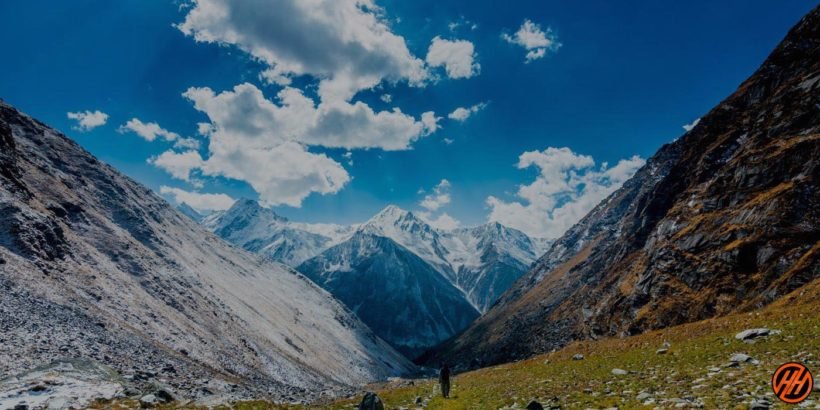
Description
Reviews (24), things to take, available dates, include / exclude.
Har Ki Dun is a popular trekking destination in the Indian state of Uttarakhand. It is known for its natural beauty and is often referred to as the “Valley of Gods.” Har Ki Dun Trek takes you through dense forests, and quaint villages, and offers stunning views of the Himalayan peaks.
Har Ki Dun Trek comes under Govind Wildlife Sanctuary National Park . No doubt, the Himalayas have enchanting beauty, a bracing climate, and desirable useful green meadows. So, what else can be better than spending some days here in the serenity?
Reasons why you should do Har Ki Dun Trek with Himalayan Hikers
Local expertise: Himalayan Hikers is a local trekking company based in Uttarakhand, India. They have extensive knowledge and experience of the Har Ki Dun trek, including the terrain, weather, and culture of the region. This can be helpful in ensuring a safe and enjoyable trekking experience.
Experienced Guides: The guides at Himalayan Hikers are experienced and certified. They have a good understanding of the Har Ki Dun trek route and can provide valuable insights into the culture and traditions of the local communities.
Good reviews: Himalayan Hikers has received positive reviews from previous clients who have completed the Har Ki Dun trek. They are known for their professionalism, excellent service, and commitment to safety.
Sustainable tourism: Himalayan Hikers is committed to promoting sustainable tourism practices on the Har Ki Dun trek. They follow Leave No Trace principles, use eco-friendly trekking equipment, and support local communities by hiring local staff and using locally sourced food.
Customized itineraries: Himalayan Hikers offers customized itineraries for the Har Ki Dun trek to suit the needs and preferences of their clients. They can tailor the trekking experience to your fitness level, time constraints, and interests.
Affordable Prices: Himalayan Hikers offers competitive prices for their Har Ki Dun trek packages. They provide a range of packages that cater to different budgets and requirements.
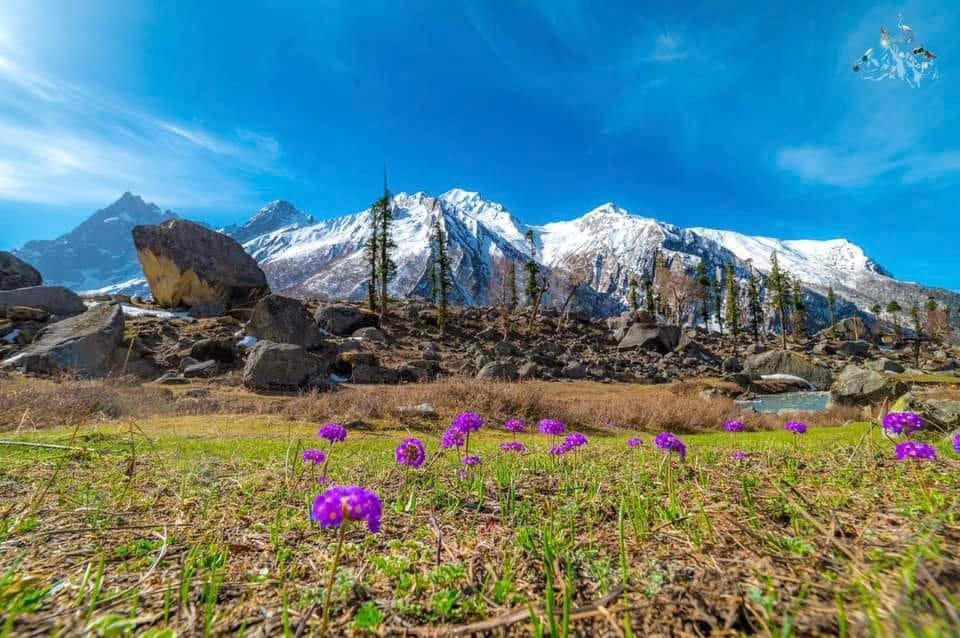
Here are some of the highlights of Har Ki Dun Trek:
Jaundhar Glacier: This is a beautiful glacier located near the Har Ki Dun Valley. The glacier is surrounded by snow-capped peaks and offers stunning views of the surrounding landscape.
Morinda Tal: This is a beautiful high-altitude lake located on the Har Ki Dun Trek. The lake is surrounded by lush meadows and offers a serene and peaceful atmosphere.
Har Ki Dun Valley: The Har Ki Dun Valley is one of the main highlights of the trek. The valley is home to a variety of flora and fauna and offers breathtaking views of the surrounding mountains.
Osla Village: Osla is a small and picturesque village located on the Har Ki Dun trek. The village is home to a number of traditional houses and offers a glimpse into the local way of life.
The term “Har ki Dun” translates to “Valley of Gods” or “Valley of Lord Shiva” in Hindi. It is derived from the combination of two words:
“Har” or “Hara”: This word refers to Lord Shiva, who is considered one of the principal deities in Hindu mythology. Lord Shiva is often associated with the Himalayan region and is regarded as the supreme deity who resides in the mountains.
“Doon”: This word refers to a valley or fertile, flat land nestled between mountains. The term “Doon” is commonly used in the Indian subcontinent to describe such valley regions
Har Ki Dun Trek Day by Day Short Itinerary, Altitude, and Trek Distance
DAY 01- Pickup Dehradun Railway Station Morning 07:00 Am | Drive to Sankri Market , Via Mussoorie, Kamptifall, Damta, Purola, Mori Sankri,
Drive Distance: 190 km | Duration: 08-09 hours | Altitude 6,309 ft | Overnight Stay The Grand Shiva Home stay at Sankri – Twin Sharing
DAY 2 – Drive from Sankri to Dharkot via Taluka 21 km 01/2 hours- Same Day Trek to Cheludgad Near Seema | Trek Distance: 06 km | Trek Time : 4/5 hours | Altitude 8,158 ft | Overnight Stay Camp – Twin Sharing
DAY 3 – Trek from Cheludgad Camp to Bhosla Camp| Trek Distance: 12 km | Trek Time: 7/8 hours | Altitude 9,795 ft | Overnight Stay Camp – Twin Sharing
DAY 4 – Trek from Exploration Day Har Ki Dun Valley or Manida Tal- Jamadar Glacier | Trek Distance: 08 km | Trek Time: 6/7 hours | Altitude 12,720 ft | Overnight Stay Camp – Twin Sharing
DAY 5 – Trek from Har Ki Dun to Cheludgad Camp | Trek Distance: 13 km | Trek Time: 6/7 hours | Via OSLA Village or Devsu Bugyal -Altitude 9795 ft | Overnight Stay Camp – Twin Sharing
DAY 6 – Trek from Cheludgad to Dharkot -Taluka | Trek Distance: 06 km | Trek Time: 5/6 hours | Same Day Drive to Sankri Market | Drive Distance: 21 km | Time: 1/2 hours – The Grand Shiva Home stay -Altitude 6309 ft | Overnight Stay Camp – Twin Sharing
DAY 7 – Drive Back from Sankri Market to Dehradun City Drive Distance: 190 km | Drive Duration:08-09 hours | Drop point for Himalayan Hikers trekkers: Dehradun Railway Station
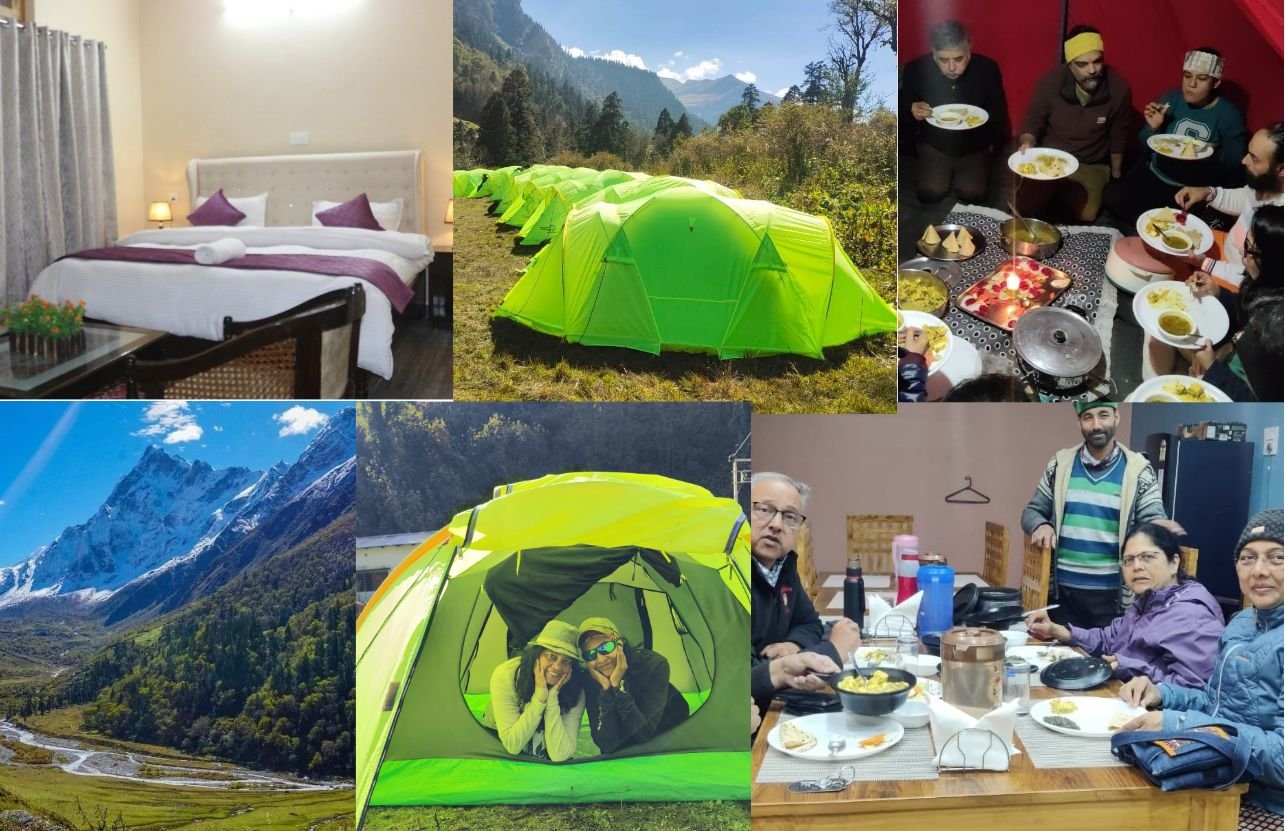
About Har Ki Dun Trek
Har Ki Dun trek, which is the most popular trek in the Garhwal Himalayas. The height of the Har Ki Dun trek is 3600 meters. It starts from Sankri – A Small Paradise and Taluka which are the last road point of this trek. Har ki Dun trek comes along this route in 4 Himalayan Villages , the first Dhatmir, Gangad, Panwani, and Osla village are the last villages of this area which Are called marginal villages, Har ki dun trek is a very popular trek not only in India but also in the world.
My grandfather used to say, at some time, foreign tourists used to come here a lot, and then people in India did not know much about trekking. That’s why Har Ki Doon treks are the oldest and special.
People go for other treks by this route, like, Bali Pass , Borasu Pass, Dhumdhar Kandi Pass , Maldaru Lake, Bainya Top , Black Peak Expedition, Swargarohini Peak Expedition, Ruinsara Ta l, there are more so people come here all year round Live on.
The temperature of the Har Ki Dun Trek always varies with time. The summer temperature of this is Day – (5°C to 15°C), Night – (2° C to 8° C) and the winter temperature is Day (-2°C to -5° C) Night (-5°C to -12°C).
Many people also called this trek is Har Ki Doon or Har Ki Doon Valley because they may not know the exact name of this trek. Many People search for this trek on Google in different names like Harkidun, Har Ki Doon, Har Ki Doon Valley, and etc.
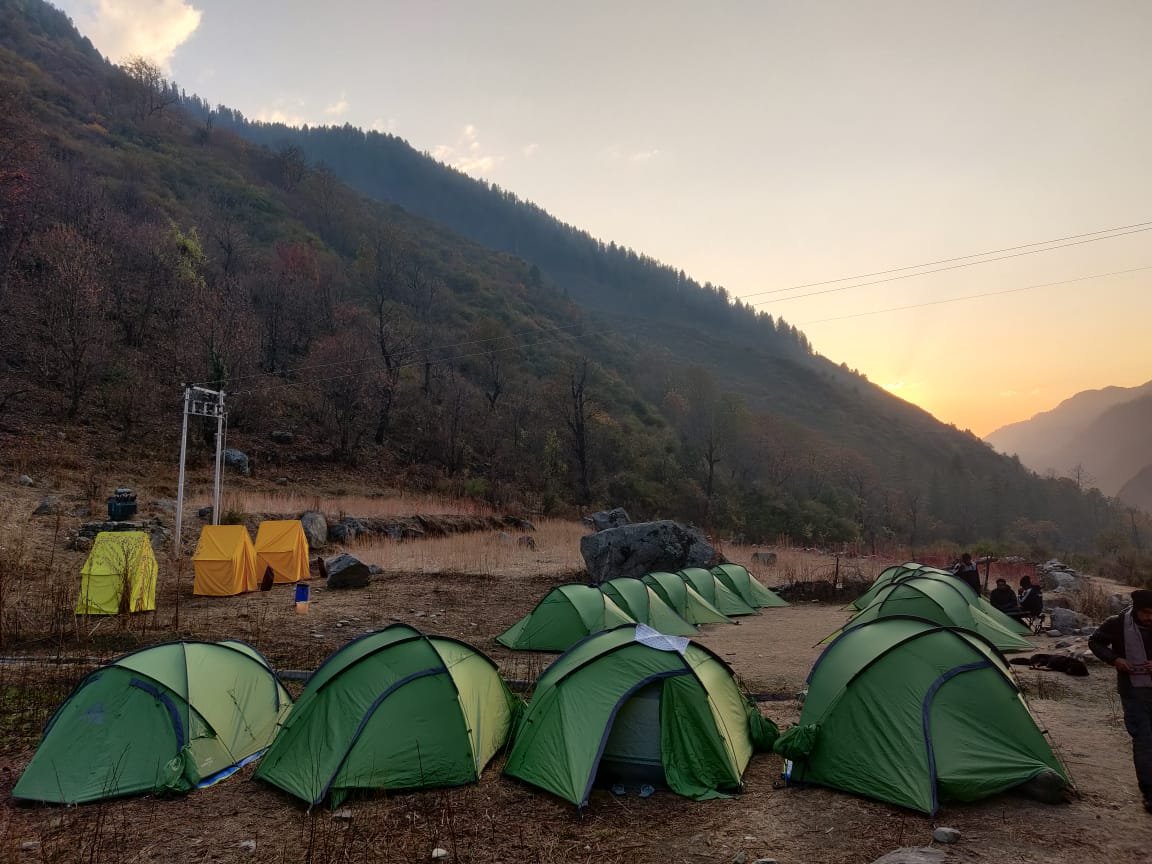
Trekking to this enthralling valley can be a divine experience for a lifetime.
Har Ki Dun Trek or Har Ki Doon Trek comes in the category of epic historic adventure treks. There you can find the essence of mythologies. You can find lavish meadows, and grasslands, You will go through a thick dense forest covered with Rhododendron trees, and many others trees, the trail is beautiful you can see flowers blooming all around and in winter it gets covered by snow, there is the number of species of birds in the woods, you can spot a variety of birds there. mountain ridges, pine forests, glacial ranges, and jaw-dropping views of the Great Himalayas.
Har Ki Doon (The Valley of Gods) or Har Ki Dun is the only valley from where you can have a glimpse of elevated peaks. Like Bandarpoonch , Black Peak, Kalanag, Bali Pass , Ruinsara Lake, and Swargarohini – I, II , and III. And many other peaks!
During the trek, you will come across the ancient villages. It’s about 300 decades old and will surely take you back in time. On the trail, you will encounter the local lifestyle and communities with lavish vegetation grown in the fields.
Today also, the local people there still worship Duryodhana As their deity. Thus, the Har Ki Dun trek is filled with solemn surroundings and legendary culture. It is a must-go for all the travel lovers and nature seekers out there.
Har Ki Dun Trek the Majestic valley in Garhwal Himalayas
Har Ki Dun is Situated in the charming Garhwal region of the Great Himalayas in Uttarakhand. It’s a large valley that follows in the footsteps of Indian mythology and, till today, is known to be “ Har Ki Dun.”
It has been present for more than 500 decades, no doubt famous as the “Valley of the Gods”. Har Ki Dun has the essence of history and mythology along with natural beauty. There is a lush climate surrounded by the soothing greenery desired. So that’s the reason why Har Ki Dun is known as the “Valley of Gods”.
Truth Behind The Myths
Many fables and tales of the era of Mahabharata are admired here. However, it is essential aware of the readers and trekkers about the real facts and myths.
Many trekking companies claim myths about the worship of Duryodhana in the temple of Yudhishthira. Local people believe that they reach heaven via the Har Ki Dun Trek. The truth is none of this exists here as per accurate facts and research. On the contrary, the chronicle of Yudhishthir reaching heaven through the Har ki Dun trail never exists here.
Instead, the saga of reaching heaven was through the path of Badrinath towards Swargarohini peak at Narayan Parvat (mountain).
The locations elapsed are Laxmi van, Chakaratir, Sahastradhara, and Satopanth Lake .
Furthermore, there is no existence of any Duryodhana temple in the Mori district of Uttarkashi. Instead, the temple, which is claimed as Duryodhana Temple, is the Someshwar Mahadev temple, a chapel of Lord Shiva .
Thus, Har Ki Dun is also known as “The Valley of Shiva.”
Why Choose Har Ki Dun Trek?
Before heading towards the itinerary, it is essential to perceive the reason behind choosing the Har Ki Dun trek.
- Scenic Beauty: The trek provides breathtaking views of the Himalayan peaks, lush green meadows, dense forests, and serene landscapes. The natural beauty of the region is sure to captivate people of all ages.
- Moderate Difficulty: Har Ki Dun is considered a moderately challenging trek, making it suitable for families with older children, as well as adults of varying fitness levels. The trekking distance is manageable, and the terrain is not too steep.
- Cultural Experience: The trail takes you through several picturesque villages like Sankri and Osla. This offers a unique opportunity for families and students to interact with the local communities, learn about their culture, and gain insights into the traditional way of life in the Himalayan region.
- Wildlife and Flora: The Govind Wildlife Sanctuary, through which the trek passes, is home to diverse flora and fauna. It’s a great educational opportunity for students and nature enthusiasts to observe and learn about the local ecosystems and wildlife.
- Educational Value: For school groups, the trek can be a valuable educational experience, providing lessons in geography, biology, and ecology. It’s a chance to learn about Himalayan geology, wildlife, and the impact of climate change on the region.
- Physical Activity: The trek encourages physical activity, helping families and adults stay active and healthy. It’s a great way to enjoy the outdoors and bond with family members or friends.
- Adventure and Exploration: For those seeking a taste of adventure, the trek offers a sense of exploration and adventure in a relatively safe and controlled environment.
- Peace and Tranquility: The serene and tranquil surroundings of Har Ki Dun make it an ideal place for relaxation and rejuvenation. It’s an opportunity to disconnect from the hustle and bustle of everyday life.
- Accessibility: The trek starts from Sankri, which is accessible by road from Dehradun, making it relatively easy to reach for families and groups.
- Safety: Har Ki Dun is generally a safe trek, and the local trekking community is well-versed in guiding and assisting trekkers. However, it’s important to follow safety guidelines and be prepared for changing weather conditions.
Best Time to Visit Har Ki Dun Trek?
The best time to visit Har Ki Dun Trek in Uttarakhand, India, depends on your preferences and what you want to experience during your trek. Here are the two primary trekking seasons, each with its own advantages:
- Blooming Meadows: The alpine meadows along the trail come alive with colorful flowers, making it a sight to behold.
- Mild Weather: Daytime temperatures are comfortable, ranging from 15°C to 20°C, making it ideal for trekking.
- Clear Skies: You’ll have clear views of the surrounding peaks and landscapes.
- Fall Colors: The deciduous forests turn vibrant shades of red, orange, and yellow, creating a picturesque environment.
- Cooler Weather: While it can get chilly at night, the daytime temperatures are still pleasant, ranging from 10°C to 15°C.
- Fewer Crowds: This period is less crowded compared to the peak summer season.
Keep in mind that the winter season (December to Feb end ) is not recommended for trekking in Har Ki Dun. The region experiences heavy snowfall, and the temperatures drop significantly, making it challenging and dangerous for trekkers. Additionally, some of the trekking trails might be inaccessible during the winter months.
How Difficult Is Har Ki Dun trek
The Har ki Dun trek is generally considered to be a moderate trek, suitable for beginners and experienced trekkers alike. It offers a beautiful and relatively accessible trail through the western Garhwal Himalayas in Uttarakhand, India.
The trek usually takes around 06 nights and 07 days to complete, covering a distance of approximately 47 kilometers round trip. The trail involves moderate ascents and descents, with some steep sections, rocky paths, and occasional river crossings. However, compared to other high-altitude treks in the region, the Har ki Dun trek has a relatively gradual ascent, making it more manageable for beginners.
The highest point on the trek is the Jaundhar Glacier, which is situated at an altitude of around 4,200 meters (13,780 feet). Altitude sickness is generally not a major concern on this trek unless you have a pre-existing condition or are particularly sensitive to altitude.
While physical fitness and stamina are important for any trek, including Har ki Dun, it is advisable to prepare yourself with regular exercise and some pre-trek training to enhance your endurance and strength. It’s also recommended to acclimatize properly by taking rest days and staying hydrated during the trek.
Har Ki Dun Trek Safe or Best Treks For Beginners ?
Yes, the Har ki Dun trek is generally considered safe and suitable for beginners. While it is always important to be prepared and take necessary precautions when embarking on any trek, Har ki Dun offers a relatively moderate level of difficulty that can be managed by beginners who are physically fit and prepared.
Here are a few reasons why the Har ki Dun trek is often recommended for beginners:
Moderate Difficulty: The trek involves moderate ascents and descents, with gradual climbs and manageable terrains. While there are some steep sections and rocky paths, they can be tackled with proper care and trekking techniques.
Well-Defined Trail: The trail for Har ki Dun is well-marked and well-defined, making navigation easier for beginners. This reduces the chances of getting lost or straying off the intended path.
Trekking Infrastructure: The trek is quite popular among trekkers, and there is a decent infrastructure in place, including trekking guides, local support staff, and well-established campsites along the route. This provides a level of comfort and assistance for beginners who may not have extensive trekking experience.
Limited Altitude Concerns: While the trek reaches a maximum altitude of around 4,200 meters (13,780 feet) at the Jaundhar Glacier, the gradual ascent and the overall altitude profile of the trek make it less prone to altitude sickness. However, it’s always important to be aware of the symptoms of altitude sickness and take necessary precautions.
Despite being considered safe for beginners, it’s still recommended to prepare adequately for the trek. This includes physical fitness training, carrying the necessary gear and supplies, and consulting with experienced trekkers or local guides for any specific advice or precautions related to the current conditions of the trek.
Remember to plan your trek well, be aware of your own limitations, and prioritize safety at all times.
Weather conditions
Weather conditions depend on the time of the year trekkers are traveling. The weather of Har Ki Dun trek always changes from time to time, so you can bring clothes for yourself according to the season in which you want to come. If possible, you can inform us about it
- Spring marks the beginning of the trekking season.
- Daytime temperatures range from 10°C to 20°C, making it a pleasant time for trekking.
- The weather is generally clear, and the meadows start to come alive with blooming flowers.
- Summer is the peak trekking season in Har Ki Dun.
- Daytime temperatures can range from 15°C to 25°C at lower elevations.
- While the days are warm, the nights can be cooler, so it’s important to carry warm clothing.
- This is the best time to witness the lush greenery and vibrant landscapes.
- Post-monsoon is another good time for trekking.
- Daytime temperatures range from 10°C to 15°C, and nights can get quite chilly.
- The forests turn vibrant with fall colors, creating a picturesque setting.
- Har Ki Dun is generally not recommended for trekking during the winter season.
- Heavy snowfall and extremely cold temperatures make it challenging and potentially dangerous for trekkers.
- The area is covered in deep snow, and some trails might be inaccessible.
What you should keep some things in mind is the Har Ki Dun Trek.
Har Ki Dun Trek is as good as it is said, you also need to be prepared., Har Ki Dun Trek is a moderate trek that starts from Sankri and ends after the trek same point Sankri, So what are the special things to keep in mind before coming on this trek? Har ki doon Trek is one such trek, which you can do in all seasons in a year.
Winter Season
- In Har Ki Dun Trek Winter Trek, you will need warm clothes a lot, for which you will need proper good uniform clothes
- Winters are always cold, so only warm clothes can keep you safe on trek feet.
- Always take the information from the company with which you are booking the trek before going on the trek, what do we need to bring
- In the winter season, the temperature always drops day by day , so warm clothes will help you a lot.
Summer Season
- Summer trek to Har Ki Dun Trek is very special, the view and the temperature are all favorable to you
- For summer trek, you have to bring only normal clothes, so that your trek can be good, there is no need for hot clothes, but in hiking it is also necessary to bring all the equipment which is necessary for you.
- It is necessary to have 3 pairs of clothes from trekking, especially the poncho, you will have to bring every season
- In the summer season, the temperature is always normal, so there is no need for hot clothes.
Monsoon Season
- During the monsoon season, it rains occasionally during the Har Ki Dun Trek, especially in the Uttarakhand Himalayas , so if you have dry clothes here, it is very good, even when wet, it dries quickly.
- At this time you have to bring at least 3 pairs of clothes, for monsoon trek you do not have to bring too warm clothes, at this time you, hiking pants and t-Sart, I can trek
- It’s only a little cold in the morning and evening and the day is a good temperature for you
- Before going on any trek, it will be easy for you to take information related to each season.
- Trekkers need to know about these, you can ask us anytime like, trek route, trek map, temperature, weather condition, difficulty level, trek starting point, end point, transport, view of the trek, best time to visit, How to reach, trek distance etc, Trek Location, keep this information before going
About Base camp Sankri in Har Ki Dun Trek
Not only Sankri is the base camp for the Har Ki Dun Trek but also for 25 + Himalayan treks . Thus, it always remains busy by the hustle and bustle of trekkers. This small village is genuinely beautiful because of its pleasant setting and calm environment.
There are quaint wooden houses made of Deodar wood. And also some hotels and restaurants serving delicious local food. Their specialty is “Red Rice.” So, get to know the villagers and have a glimpse of their lifestyle.
It is the best place to explore the Himalayan culture and tradition.
You will also have some excellent views of lofty Swargarohini Peaks and Bandarpoonch. And yes, do not miss their glorifying sunrise and sunset views.
Moreover, the nearest village to Sankri is “Saur” The temple of Someshwar Devta there is highly worshiped by the villagers.
Therefore, the base camp will leave you admiring its exquisite beauty.
The altitude we are going to cover at Har Ki Dun Trek
The Har Ki Dun trek is a popular trek in the Uttarkashi district of Uttarakhand, India. The trek covers an altitude of around 12,000 feet (3,657 meters) and takes around 07 days to complete. from Dehradun to Dehradun Here’s a day-by-day breakdown of the altitude covered during the Har Ki Dun trek:
Day 1: Sankri to Taluka (7,800 feet/ 2,377 meters)
- Altitude gain: 0 feet
- Altitude loss: 1,000 feet (305 meters)
Day 2: Taluka to cheludgad (8,560 feet/ 2,609 meters)
- Altitude gain: 760 feet (232 meters)
- Altitude loss: 130 feet (40 meters)
Day 3: Cheludgad to Har Ki Dun (11,700 feet/ 3,566 meters) and back to Kalkattiyadhar
- Altitude gain: 2,140 feet (652 meters)
- Altitude loss: 2,140 feet (652 meters)
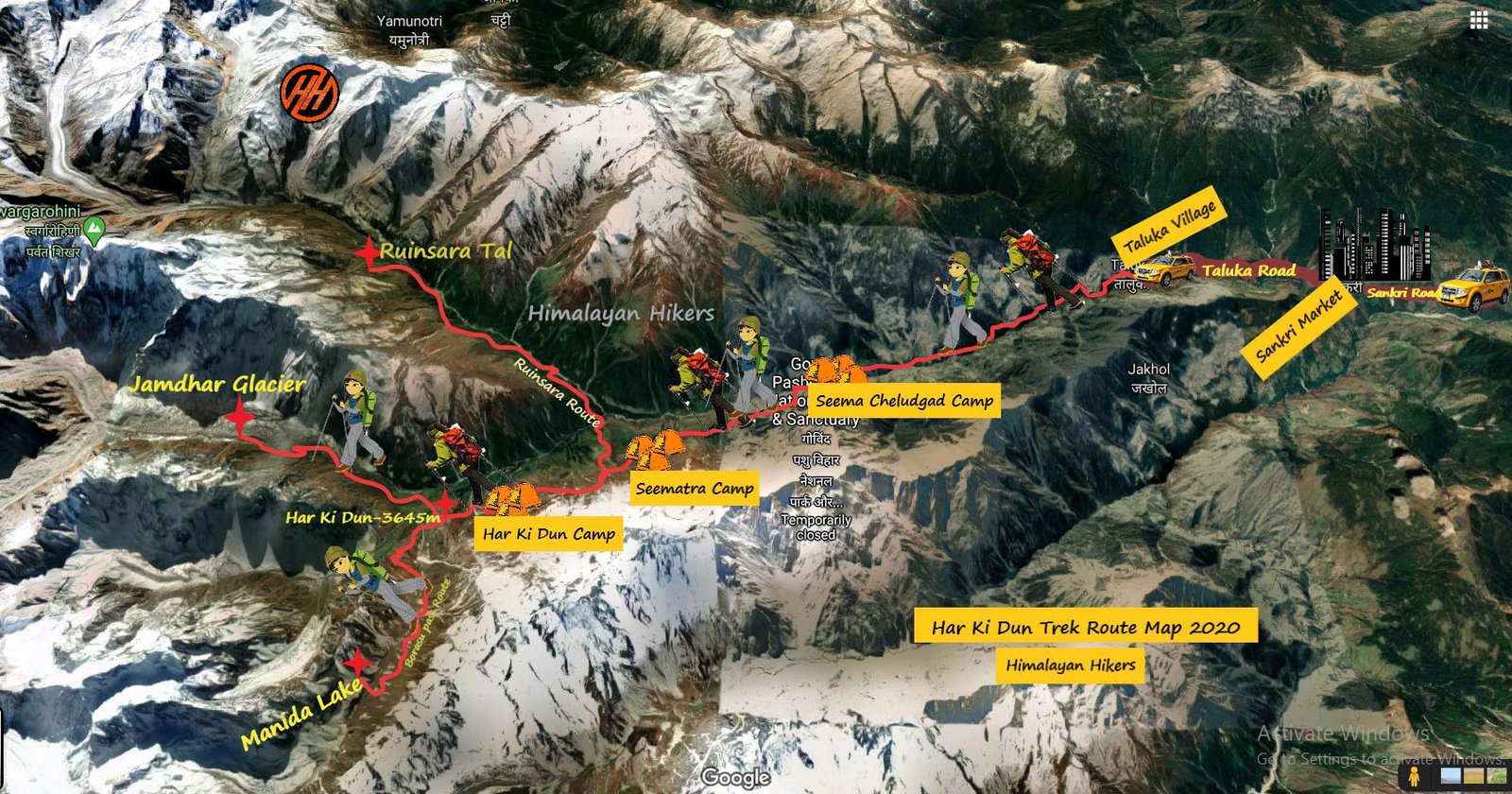
How to Reach Har Ki Dun Trek?
First of all, you people have to come to Dehradun Uttarakhand
From Dehradun itself, you will go with the Himalayan hikers for this Har Ki Dun trek.
In Dehradun, you will get our staff that will arrange transport for you. The contact no Transport coordinator or our office team will give you a week ago to your departure
Train and flight are always available from where you will go to Dehradun.
Himalayan Hikers arranged for your transport from Dehradun railway station or Airport
Transport costs you can pay directly to your taxi driver both sides pick up and drop
Your Travel Plan for Har Ki Dun Trek
Har Ki Dun trek is located in the Uttarkashi district of Uttarakhand and can be reached through Dehradun, which is the nearest major city. Here are the steps to reach Har Ki Dun trek from Dehradun:
- By air: The nearest airport to Dehradun is Jolly Grant Airport, which is about 29 km away. From the airport, you can take a taxi or a bus to Dehradun.
- By train: Dehradun is well connected by rail to major cities in India. The Dehradun Railway Station is located in the heart of the city and can be reached easily by taxi or auto-rickshaw.
- By road: Dehradun is connected to major cities by road and has a good network of buses and taxis. You can take a bus or a taxi from Delhi, which is about 240 km away, to reach Dehradun.
Once you reach Dehradun, you can take a taxi or a bus to reach Sankri, which is the starting point of the Har Ki Dun trek. The distance between Dehradun and Sankri is about 190 km, and it takes around 8-9 hours to reach by road. From Sankri,
Here are the various options to reach Dehradun from some major cities in India:
Mumbai to Dehradun:
- By Air: You can take a direct flight from Mumbai to Dehradun. The flight duration is approximately 2 hours and there are multiple airlines operating on this route.
- By Train: You can take a direct train from Mumbai to Dehradun. The journey duration is approximately 30-36 hours, depending on the train you choose.
- By Road: There are no direct buses from Mumbai to Dehradun. You can take a bus to Delhi or Chandigarh and then take another bus or taxi to reach Dehradun.
Delhi to Dehradun:
- By Air: You can take a direct flight from Delhi to Dehradun. The flight duration is approximately 1 hour and there are multiple airlines operating on this route.
- By Train: You can take a direct train from Delhi to Dehradun. The journey duration is approximately 5-7 hours, depending on the train you choose.
- By Road: You can take a bus or a taxi from Delhi to Dehradun. The distance is approximately 250 km and the journey duration is around 6-7 hours.
Pune to Dehradun:
- By Air: There are no direct flights from Pune to Dehradun. You can take a connecting flight via Delhi or Mumbai.
- By Train: There are no direct trains from Pune to Dehradun. You can take a train to Delhi or Chandigarh and then take another train to reach Dehradun.
- By Road: There are no direct buses from Pune to Dehradun. You can take a bus to Delhi or Chandigarh and then take another bus or taxi to reach Dehradun.
Chennai to Dehradun:
- By Air: There are no direct flights from Chennai to Dehradun. You can take a connecting flight via Delhi or Mumbai.
- By Train: There are no direct trains from Chennai to Dehradun. You can take a train to Delhi or Chandigarh and then take another train to reach Dehradun.
- By Road: There are no direct buses from Chennai to Dehradun. You can take a bus to Delhi or Chandigarh and then take another bus or taxi to reach Dehradun.
Bangalore to Dehradun:
- By Air: You can take a direct flight from Bangalore to Dehradun. The flight duration is approximately 2 hours and there are multiple airlines operating on this route.
- By Train: There are no direct trains from Bangalore to Dehradun. You can take a train to Delhi or Chandigarh and then take another train to reach Dehradun.
- By Road: There are no direct buses from Bangalore to Dehradun. You can take a bus to Delhi or Chandigarh and then take another bus or taxi to reach Dehradun.
Hyderabad to Dehradun:
- By Air: You can take a direct flight from Hyderabad to Dehradun. The flight duration is approximately 2-3 hours and there are multiple airlines operating on this route.
- By Train: There are no direct trains from Hyderabad to Dehradun. You can take a train to Delhi or Chandigarh and then take another train to reach Dehradun.
- By Road: There are no direct buses from Hyderabad to Dehradun. You can take a bus to Delhi or Chandigarh and then take another bus or taxi to
Reach Sankri by yourself
Take a bus from the Railway station of Dehradun, the first one leaves at 5:30 am, the other one at 6:30 am and the last bus leaves at 7:00 am. So reach there on time.
You can also hire a taxi from Dehradun Railway Station, the fare is Rs 6000 from Dehradun to Sankri (190 km)
A short story of your journey Dehradun to Sankri?
The journey from Dehradun to the Sankri is beautiful and it is you in Dehradun. From Rajpur Road you will go and they will come to Mussoorie which is called the queen of the mountains. After Mussoorie, you will come to Kamptitall. Here you will stop 45 minutes for breakfast and after breakfast, you will come along the Yamuna River – Purola, here you will stay for lunch for 1 hour. After that you will be taken straight to the place where our team Himalayan Hikers will be ready to welcome you.
Before starting the journey to Har Ki Dun trek, make sure that you need payments, and then take out the cash on the way, no bank and ATM. No, the Purola market is the last place where you can withdraw cash from ATM, (If you want to withdraw money then do it in Dehradun.)
Mobile Connectivity
Sankri is a small village located in the Uttarkashi district of Uttarakhand, India. Being a remote location, the mobile network connectivity in Sankri may be limited. However, some of the major mobile network providers in India like , Jio, Vodafone and BSNL have network coverage in the area. It’s important to note that the network coverage may vary depending on the location and the network provider. In some areas, you may experience poor or no network connectivity, while in others, you may have good network coverage. It’s a good idea to check with your network provider regarding the network coverage in Sankri and the surrounding areas before your trip.
The Grand Shiva Home Stay in Sankri, Uttarkashi, Uttarakhand
The Grand Shiva Home Stay is our newly constructed luxurious hotel in Sankri (the base camp of Kedarkantha Trek). It offers you local and delicious food prepared by our local family members, 24 Horse Hot Water, Cold Water, Free Wi-Fi, Room Services, and much more, with the help of which we provide our guests with a special experience. Our Homestay has exquisite furnishings with luxurious furniture and high-quality toiletries.
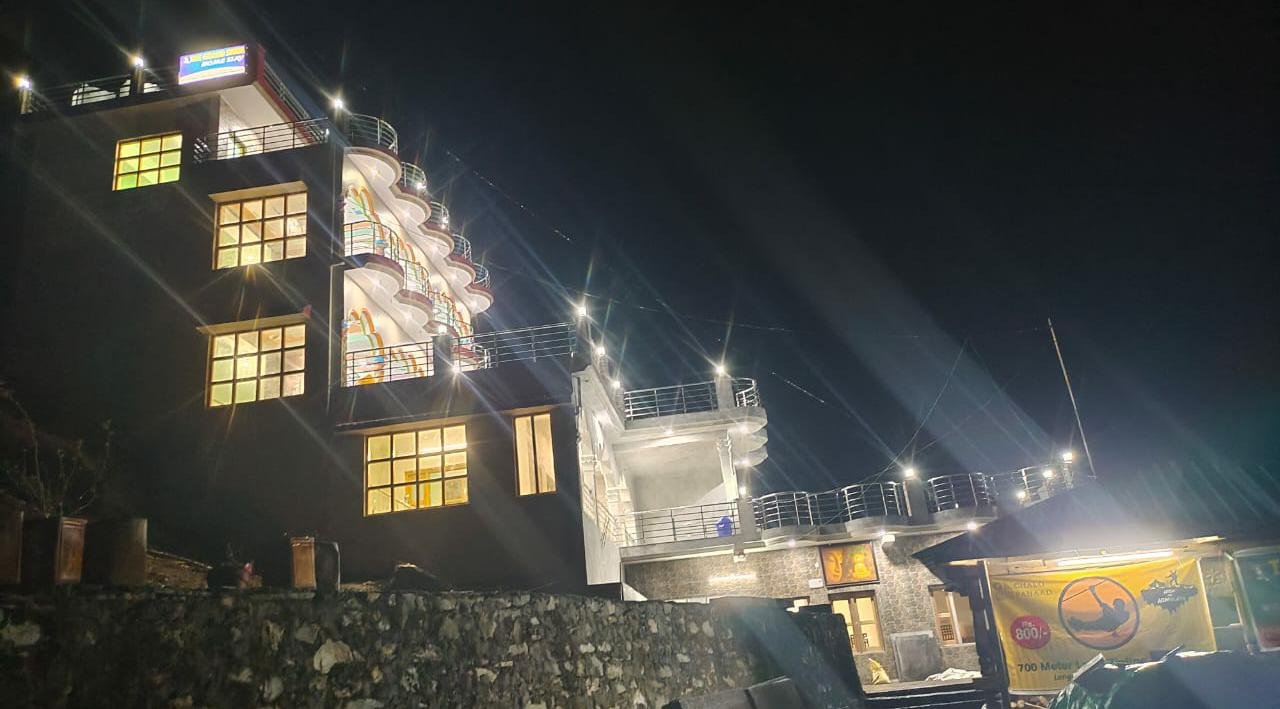
Luxury Rooms in The Grand Shiva Home Stay Sankri
The Grand Shiva Home Stay rooms are spacious, elegant, and comfortable all at once, equipped with everything you need for a wonderfully rejuvenating stay. Every detail of the design and features have been carefully considered. Suites feature lavish furnishings with sleeping and sitting areas and a host of other amenities, including complimentary Wi-Fi Internet,
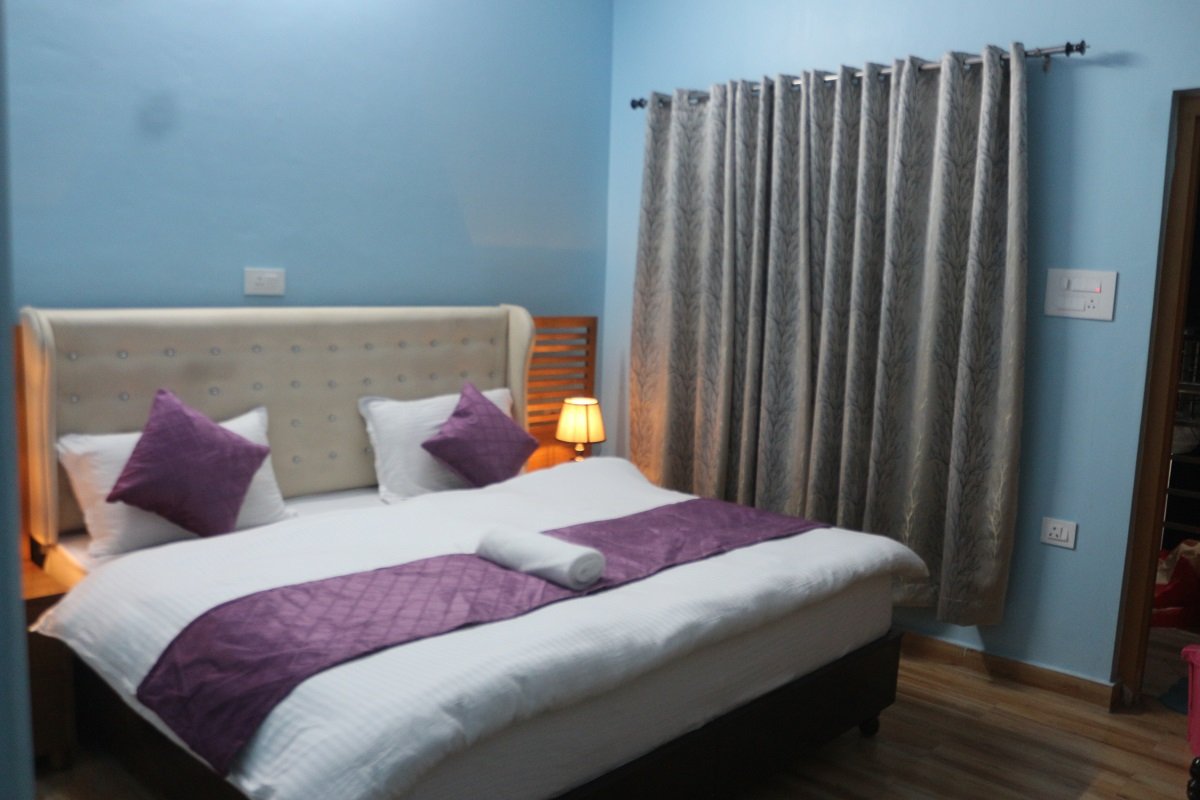
What do we do for safety in the Har Ki Dun trek?
First of all, the safety of trekkers is much more for us, if you see in the trek, then there are all the risks, which I do not think about.
Himalayan Hikers worry more about you that no one should ever have any problem in the trek.
What should we and you keep more safety in the trek
- Whenever you are going for any trek, it is very important that you go completely fit and ready.
- The trek is not difficult, if you make your feet and your mind calm and strong, you will find the trek very easy.
- While trekking, keep in mind that you are walking on the right route or not always with your guide.
- Most people look somewhere and where they are walking, this can cause twitching in your legs, which can ruin your entire trek.
- It is important to ask your doctor if you have any medical problems
- I should always keep my medical kit with me, it is very important.
- Himalayan Hikers always keep a medical kit with you, such as oxygen cylinders, and medicine to be given in an emergency on the trek
- If any trekkers have any more problems, then they are brought back to the base camp by laying them in the stretcher.
- Our camp in Har Ki Dun trek is around the tree line where you can not have any problem of oxygen
- In case of any medical problem, the help of your guide or well-informed trekkers should be taken
- If there is major health problems in Har Ki Dun trek, then Nearest Hospital is in Mori which is about 46 Kms away from Har Ki Dun trek.
Important to make certain preparations. Here are some key aspects to consider:
Physical Fitness: Enhance your physical fitness and stamina through regular exercise, such as cardiovascular workouts, hiking, and strength training. Focus on building endurance and leg strength to cope with the trek’s demands.
Trekking Gear: Invest in appropriate trekking gear, including sturdy and comfortable trekking shoes, layered clothing suitable for changing weather conditions, a backpack, a sleeping bag, a trekking pole for stability, and a raincoat or poncho.
Packing Essentials: Pack essential items such as a first aid kit, sunscreen, sunglasses, a hat, insect repellent, toiletries, quick-drying towels, a headlamp or flashlight, water bottles or a hydration bladder, and energy-rich snacks.
Acclimatization: Allocate a day or two for acclimatization in Sankri, the base village for the trek. This will allow your body to adjust to the altitude and reduce the risk of altitude sickness.
Trekking Permits and Research: Obtain the necessary permits for the trek, which can be acquired in Sankri. Additionally, conduct thorough research on the route, weather conditions, and any recent updates or advisories related to the trek.
Trekking Guide or Local Support: Consider hiring an experienced trekking guide or joining a guided tour to enhance safety and local knowledge. They can provide assistance with navigation, ensure proper campsites, and offer insights into the region.
Hydration and Water Purification: Stay hydrated throughout the trek by carrying an adequate supply of water. Carry water purification tablets or a water filter to treat water from streams or sources along the trail.
Weather Preparedness: Be prepared for changing weather conditions, as it can vary significantly during the trek. Carry appropriate clothing layers to adjust to temperature fluctuations, and keep an eye on weather forecasts before starting the trek.
Emergency Contacts and Communication: Carry a list of emergency contacts, including local authorities, trek organizers, and medical services. Ensure you have a reliable means of communication, such as a mobile phone or satellite phone, in case of emergencies.
Leave No Trace: Respect the environment and practice the principles of Leave No Trace. Dispose of waste responsibly and follow guidelines to minimize your impact on the natural surroundings.
Remember, the Har ki Dun trek can have specific requirements and conditions that may change over time. Stay updated with the latest information and seek advice from experienced trekkers or local guides for any additional preparations specific to your trekking period.
For Himalayan Hikers or trekkers, it’s crucial to have some emergency medical support available, given the remote and rugged terrain they often traverse. Here are some essential medical supplies to consider carrying:
- First Aid Kit : Include bandages, antiseptic wipes, adhesive tape, gauze pads, scissors, tweezers, and a CPR mask.
- Oxygen cylinder- Oxygen can be beneficial in alleviating symptoms of altitude sickness, such as headache, dizziness, nausea, and shortness of breath. Administering oxygen can provide relief and help prevent the condition from worsening.
- Personal Medications : Any prescribed medications should be carried in sufficient quantities.
- Pain Relief : Ibuprofen or acetaminophen for pain relief in case of minor injuries or headaches.
- Antihistamines : For allergic reactions and insect bites.
- Anti-diarrheal Medication : Such as loperamide, in case of gastrointestinal issues.
- Water Purification Tablets : In areas where clean water may not be readily available.
- Blister Treatment : Moleskin or blister pads for foot care.
- Tweezers : For removing splinters or ticks.
- Emergency Blanket : To keep warm in case of exposure.
- Whistle and Signal Mirror : For attracting attention in emergencies.
- Flashlight or Headlamp : Essential for navigating in the dark or signaling for help.
- Emergency Communication Device : Such as a satellite phone, PLB (Personal Locator Beacon), or a two-way radio for calling for help if needed.
- Basic Wilderness First Aid Guide : To assist in treating common injuries or illnesses.
- Sun Protection : Sunscreen, sunglasses, and a wide-brimmed hat to protect against sunburn.
- Emergency Shelter : Lightweight emergency shelter or tarp for protection from the elements.
It’s also essential for hikers to have basic knowledge of first aid and wilderness survival skills. Additionally, informing someone of your hiking plans and expected return time can be crucial in case of emergencies. Always be prepared and stay safe while exploring the beautiful but challenging Himalayan terrain.
FAQ Har Ki Dun Trek 2024
Q- why should you do har ki dun trek.
Har Ki Dun is located in the Garhwal region of Uttarakhand, India, which is rich in culture and tradition. Along the trekking route, trekkers get a chance to interact with the locals, who belong to villages like Osla, Taluka, and Sankri, and experience their unique way of life, customs, and hospitality. Har Ki Dun valley holds historical significance as it is believed to be the path followed by the Pandavas during their ascent to heaven in the Hindu epic Mahabharata. This adds a spiritual and mythological dimension to the trek, attracting pilgrims and history enthusiasts alike.
Q -What is the best time to visit Har ki dun Trek?
The best time to visit Har Ki Dun depends on your preferences and the kind of experience you’re seeking. However, the most favorable time for trekking in the region is during the following periods:
Summer (March to June) :- Post-Monsoon/Early Autumn (September to November) :
Q- How many days is it best to do Har Ki Doon trek?
The ideal duration 6 nights 07 Days minimum for the Har Ki Dun trek depends on various factors, including your fitness level, trekking experience, and personal preferences. Typically, the trek is completed in 6 to 8 days. Here’s a common itinerary:
Q-Is it suitable for first time trekkers?
Yes, the Har Ki Dun trek is suitable for first-time trekkers, provided they are reasonably fit and prepared for moderate physical activity. Here are a few reasons why it’s a good option for beginners:
Moderate Trek, Gradual Altitude Gain:, Scenic Beauty: Guided Tours Available: Cultural Experience:
However, even though the Har Ki Dun trek is suitable for beginners, it’s essential to prepare adequately by building stamina through regular exercise, including cardiovascular and strength training. Additionally, packing appropriate gear, clothing, and essentials, as well as being mindful of altitude-related challenges, will contribute to a safer and more enjoyable experience for first-time trekkers.
Q- Points to keep in mind on Har Ki Doon Trek?
When embarking on the Har Ki Dun trek, it’s essential to keep several points in mind to ensure a safe and enjoyable experience. Here are some key considerations:
Physical Fitness: -Altitude Acclimatization:- Proper Gear: -Hydration and Nutrition: -Trekking Permits: -Leave No Trace: -Safety Precautions:- Weather Awareness:- Emergency Preparedness:-
Q- Documents to be carried for Har Ki Dun trek?
Identification Proof: Carry a government-issued photo identification document such as a passport, Aadhar card, driver’s license, or voter ID card. This is required for permits, registrations,
Trekking Permits/Permissions :- Travel Itinerary :- Medical Information :- Travel Insurance :- Fitness Certificate /Medical certificate;- Emergency Contacts :- Photocopies/Scans:- Cash and Payment Methods:- Trekking Agency/Guide Details :
Q- What kind of weather will there be in Harkidoon at what time?
Spring (March to May):
- March: The weather gradually transitions from winter to spring. Days can still be cool, with temperatures ranging from 5°C to 15°C (41°F to 59°F). Nights are cold, with temperatures dropping to around 0°C (32°F) or below.
- April to May : Spring fully sets in, with milder temperatures during the day ranging from 10°C to 20°C (50°F to 68°F). Nights are still chilly, with temperatures ranging from 5°C to 10°C (41°F to 50°F).
Post-Monsoon/Early Autumn (September to November) :
- September October & November: After the monsoon season, the weather begins to clear up. Days are pleasant, with temperatures ranging from 10°C to 25°C (59°F to 77°F). Nights are cool, with temperatures around 10°C to 15°C (50°F to 59°F).
- October: Autumn sets in, bringing crisp, clear days with mild temperatures ranging from 10°C to 20°C (50°F to 68°F). Nights become colder, with temperatures ranging from 5°C to 10°C (41°F to 50°F).
Himalayan Hikers – Provided food During the Har Ki Dun Trek
– We serve five -05 times meals a day including- Breakfast, Lunch, Eevening Snakes, Soup, Dinner, A variety of delectable and healthy food is provided which includes; Indian, Chinese and other Western meals. They are nutritious and keep you fit and healthy on the trek.(Veg or non-veg food) With our local food and Day Pack, for Summit Day like fresh fruits
Food Menu – Roti + Rice + Salad + Papad +Matter paneer +Daal +mix veg+ daily more vegetable +sweet+ Bread +Omelets +Nutella + jam + butter +Muesli, Milk+Banana+ Allo parantha +Tea & coffee Cornflakes, Milk +Egg bhurji +Bread, Peanut Butter +Pancake +Plain parantha +Fruits+ Porridge Oats+ +Bread & cheese +Poha +Boiled egg + Gulab Jamun+ Custard+ Jalebi+ Chilla +Honey+ Puri + Chole more
Note: – This is only list Himalayan Hikers Team Cook provide you more healthy food and more items of per day menu
The type of food provided during a trek can vary depending on factors like the location, duration, and the trekking company or organization you’re with. However, there are some common types of food that are often included in trekking provisions:
- Carbohydrates : Foods high in carbohydrates provide energy for the trek. This includes items like rice, pasta, bread, and potatoes. More
- Proteins : Protein-rich foods help with muscle repair and recovery. Common protein sources include lentils, beans, tofu, meat (if available), eggs, and dairy products.
- Fruits and vegetables : These provide essential vitamins, minerals, and fiber. While fresh produce may not always be available, dried fruits and vegetables or canned options might be included.
- Snacks : Trekking often involves long hours of physical exertion, so snacks are important for quick energy boosts. Snacks like nuts, energy bars, trail mix, and chocolate are common choices.
- Local cuisine: Depending on the region you’re trekking in, you might also get the chance to sample local dishes. This can be a delightful way to experience the culture and flavors of the area.
Day 1: Pickup from Dehradun Railway Station and Drive to Sankri (base camp) by taxi-Tempo Travellers
Total distance 190 km – 8/9 Hours journey
Mode of journey – By taxi- Tempo Travellers 13+D
Altitude – Sankri base camp – 1920 Meters
Night stay – The Grand Shiva Hotel – on twin share basis
Himalayan Hikers organizes transport for trekkers from Dehradun Railway Station in the morning which will leave for Sankri around 6:00 am to 7:00 am.
The route from Dehradun Railway Station to Sankri is a picturesque journey through the Himalayan foothills, passing through charming towns and scenic landscapes. Here’s a suggested route along with notable viewpoints and markets:
- Dehradun Railway Station: Start your journey from Dehradun Railway Station. You can hire a taxi or take a bus to begin your trip towards Sankri.
- Dehradun City: As you leave the railway station, you’ll pass through Dehradun city. If you have time, you can explore some of the local markets here, such as Paltan Bazaar or Rajpur Road, where you can find local handicrafts, clothing, and delicious street food.
- Mussoorie Road: The route to Sankri often begins by heading towards Mussoorie Road. Along this route, you’ll start witnessing the gradual ascent into the hills. The drive itself offers beautiful views of the surrounding valleys and forests.
- Kempty Falls: If you have time for a detour, Kempty Falls is a popular tourist spot along Mussoorie Road. It’s a scenic waterfall surrounded by lush greenery, offering a refreshing stop on your journey.
- Yamuna Bridge: As you continue your drive, you’ll cross the Yamuna Bridge. This bridge offers stunning views of the Yamuna River flowing through the valley below.
- Naugaon: Naugaon is a small town you’ll pass through on your way to Sankri. While there might not be significant markets here, you can find local shops and eateries to grab a quick snack or take a break.
- Purola: Purola is another town along the route where you can find local markets. It’s a good place to stock up on any essentials you may need for your journey ahead.
- Jarmola: As you near Sankri, you’ll pass through Jarmola, a small village known for its serene surroundings and traditional Himalayan architecture. Take a moment to enjoy the quaint charm of this village before continuing your journey.
- Sankri: Finally, you’ll arrive at Sankri, a scenic village nestled in the Uttarkashi district of Uttarakhand. The drive from Dehradun Railway Station to Sankri takes approximately 8-10 hours, depending on road conditions and traffic.
Throughout your journey, you’ll encounter numerous viewpoints offering breathtaking vistas of the Himalayas and the surrounding valleys. Be sure to stop and take in the beauty of the landscape as you make your way to Sankri.
Day 2 : Trek from Sankri to Dharkot via Taluka by taxi – 21 km same day trek to Cheludgad camp
Total distance 27 km – 4/5 Hours journey
Mode of journey – On foot (06 km) and By taxi (21 km)
Altitude – Cheludgad camp/seema – 2600 Meters
Night Stay – Camp site – on twin share basis
travel from Sankri to Dharkot by taxi and then trek to Cheludgad camp on the same day, here’s a suggested itinerary:
- Start early in the morning from Sankri to make the most of your day.
- Hire a taxi from Sankri to Dharkot via Taluka, which is approximately an 21-kilometer journey. The road from Sankri to Dharkot is a scenic route passing through forests and along the Supin River.
- The journey by taxi should take around 45 minutes to an hour, depending on road conditions.
- Ensure you have arranged the taxi in advance or find one upon arrival in Sankri.
- Upon reaching Taluka, you’ll begin your trek towards Cheludgad camp. Taluka serves as the starting point for several treks in the region.
- The trek from Taluka to Cheludgad camp is approximately 06 kilometers and typically takes around 4-6 hours, depending on your pace and the trail conditions.
- The trail offers beautiful views of the surrounding forests, rivers, and mountains. You’ll pass through quaint villages, lush greenery, and occasionally cross wooden bridges over streams.
- Cheludgad camp is a picturesque camping site along the trekking route, situated amidst serene surroundings. It’s an ideal spot to set up camp for the night.
- Upon reaching Cheludgad camp, set up your tents and settle in for the night.
- Enjoy the tranquility of the Himalayan wilderness and the clear night sky filled with stars.
- You can either cook your meals at the campsite if you’re carrying camping gear or arrange for meals with local guides or camping services in advance.
Please note:
- It’s essential to start early to ensure you have enough daylight for both the taxi ride and the trek to Cheludgad camp.
- Check the weather conditions before starting your trek and prepare accordingly with appropriate clothing, footwear, and gear.
- Carry sufficient water, snacks, and any other essentials for the trek.
- Ensure you have necessary permits if required for trekking in the region.
- Respect the local environment and culture, and follow Leave No Trace principles during
Day 3 : Trek from Cheludgad camp to Har Ki Dun Camp
Trek Distance 13 Km – 6/7 Hours journey/p>
Mode of journey – On foot – 13 km
Altitude – Har Ki Dun base camp – 3500 Meters
The trek from Cheludgad camp to Har Ki Dun camp is a beautiful and moderately challenging trek that offers stunning views of the Himalayan landscapes. Here’s what you can expect in terms of trek route, difficulty level, time required, and views:
- The trek route from Cheludgad camp to Har Ki Dun camp typically follows a well-defined trail.
- You’ll start from Cheludgad camp and ascend gradually along the trail, passing through forests, meadows, and crossing streams.
- The route takes you deeper into the Govind National Park, offering glimpses of diverse flora and fauna along the way.
- After a few hours of trekking, you’ll reach the Har Ki Dun valley, where the Har Ki Dun campsite is located.
- The trek from Cheludgad camp to Har Ki Dun camp is considered to be of moderate difficulty.
- While the trail is well-marked and not overly steep, there are some sections that involve gradual ascents and descents.
- Trekking poles can be helpful, especially while crossing streams or navigating uneven terrain.
- The trek from Cheludgad camp to Har Ki Dun camp typically takes around 5-7 hours, depending on your pace and trail conditions.
- Factors such as weather conditions and your level of fitness can also affect the trekking time.
- It’s advisable to start early in the morning to make the most of daylight hours and to reach the campsite before nightfall.
- Throughout the trek, you’ll be treated to breathtaking views of the surrounding Himalayan peaks, including Swargarohini, Bandarpoonch, and Black Peak.
- The trail offers panoramic vistas of lush green valleys, snow-capped mountains, and cascading waterfalls.
- As you approach Har Ki Dun camp, the scenery becomes even more spectacular, with the iconic valley opening up before you, surrounded by towering mountains.
Overall, the trek from Cheludgad camp to Har Ki Dun camp is a memorable experience, combining natural beauty with a sense of adventure. Be sure to carry essential trekking gear, stay hydrated, and take breaks as needed to enjoy the stunning views along the way.
Day 4 : Exploration Day (Manida Lake) (Jaundhar Glacier View ) Har Ki Dun valley back to camp
Trek Distance – Manida Lake 08 Km – 5/6 Hours journey
Jaundhar Glacier – 14 km – 7/8 Hours journey
Mode of journey – on foot
Altitude – Har Ki Dun – 3645 Meters
Exploration Day in the Har Ki Dun valley, with visits to Manida Lake and the Jaundhar Glacier View, offers an opportunity to witness some of the most breathtaking sights in the Himalayas. Here’s a detailed guide:
- Start from the Har Ki Dun campsite early in the morning.
- Trek towards Manida Lake, which is nestled amidst the scenic beauty of the valley.
- After spending some time at Manida Lake, continue towards the Jaundhar Glacier Viewpoint.
- Return to the Har Ki Dun campsite by late afternoon or early evening.
- The trek from Har Ki Dun campsite to Manida Lake involves a moderate level of difficulty.
- The trail meanders through alpine meadows, dense forests, and rocky terrain.
- You’ll encounter some ascents and descents along the way, so sturdy trekking shoes and trekking poles are recommended.
- The trek to Jaundhar Glacier Viewpoint may involve a slightly more challenging ascent, depending on the specific route chosen.
- The trek to both Manida Lake and the Jaundhar Glacier Viewpoint is of moderate difficulty.
- While the trails are well-defined, some sections may be steep or rocky, requiring moderate physical fitness and trekking experience.
- Throughout the trek, you’ll be surrounded by the majestic peaks of the Himalayas.
- The Har Ki Dun valley is known for its panoramic views of peaks such as Swargarohini, Bandarpoonch, and Black Peak.
- From the Jaundhar Glacier Viewpoint, you’ll get a closer look at the glaciers and snow-capped peaks that define the region.
- Manida Lake offers serene surroundings with crystal-clear waters reflecting the surrounding mountains.
- The Jaundhar Glacier Viewpoint provides a stunning panorama of glaciers cascading down from high mountain peaks.
- Along the trekking route, you’ll be treated to spectacular vistas of alpine meadows, lush forests, and cascading waterfalls.
- Keep an eye out for wildlife such as Himalayan birds, ibex, and musk deer, which are commonly spotted in the region.
Overall, the Exploration Day trek to Manida Lake and the Jaundhar Glacier Viewpoint offers a perfect blend of natural beauty, adventure, and Himalayan grandeur. Be sure to carry adequate water, snacks, and camera gear to capture the unforgettable moments along the way.
Jaundhar Glacier
If you want to go to Jaundhar glacier, 7 km away from the Har Ki Dun valley. then you have to cross some ridges, the trail is not an easy one and remains covered in snow but ahead it eases.
After reaching the final ridge you will see the Jaundhar Glacier and other towering peaks, then we’ll return back to the campsite and enjoy delicious evening snakes, Soup and Dinner enjoying bonfire and overnight stay there.
Day 5 : Trek from Har Ki Dun to Cheludgad camp Via Osla Village
Trek Distance 13 km – 6/7 Hours journey
Altitude – Cheludgad camp – 2600 Meters
Night Stay – on twin share basis
Trekking from Har Ki Dun to Cheludgad camp via Osla Village offers a diverse and scenic route through the Himalayan landscapes. Here’s what you can expect in terms of route, views, location, and trek level:
- Start your trek from the Har Ki Dun campsite in the morning.
- Descend back towards the village of Osla, which lies along the banks of the Supin River.
- From Osla, continue along the trail that leads towards Cheludgad camp.
- The route takes you through dense forests, charming Himalayan villages, and picturesque meadows.
- As you descend from Har Ki Dun towards Osla, you’ll be treated to panoramic views of the Har Ki Dun valley and the surrounding peaks.
- The trail passes through lush green forests and offers glimpses of the Supin River flowing alongside.
- Upon reaching Osla Village, you’ll have the opportunity to explore its traditional architecture and interact with the locals.
- Continuing towards Cheludgad camp, the trail offers stunning vistas of the Himalayan foothills and valleys below.
- Osla Village is situated at an altitude of around 2,570 meters (8,430 feet) above sea level.
- Cheludgad camp is located at a higher altitude, providing panoramic views of the surrounding mountains and valleys.
- The trek from Har Ki Dun to Cheludgad camp via Osla Village is of moderate difficulty.
- While the trail involves some steep descents and ascents, it is generally well-defined and suitable for trekkers with moderate fitness levels.
- Trekking poles may be helpful, especially during the descent from Har Ki Dun to Osla.
- Osla Village is known for its ancient temple dedicated to Duryodhana, a character from the Hindu epic Mahabharata.
- The trail offers opportunities to observe the local way of life in the mountain villages and interact with the friendly villagers.
- Cheludgad camp provides a tranquil setting amidst the Himalayan wilderness, making it an ideal spot to unwind and enjoy the natural beauty of the surroundings.
Day 6 : Trek from Cheludgad to Dharkot 06 km same day Drive to Sankri
Trek Distance 27 km – 5 / 6 Hours journey
Mode of journey – On foot – 06 km – By taxi 21 km
Trekking from Cheludgad to Taluka and then driving to Sankri on the same day is feasible but requires an early start and efficient time management. Here’s a suggested itinerary:
- Start your trek early in the morning from Cheludgad campsite.
- The trail from Cheludgad to Taluka is approximately 12 kilometers and typically takes around 4-6 hours, depending on your pace and trail conditions.
- The trek involves descending from the higher altitude of Cheludgad towards Taluka, passing through forests, meadows, and streams.
- Ensure you have enough water and snacks for the trek, and take breaks as needed to rest and enjoy the scenery.
- Reach Taluka by late morning or early afternoon.
- Upon reaching Taluka, arrange for a taxi or private vehicle to drive you back to Sankri.
- The drive from Taluka to Sankri takes approximately 45 minutes to an hour, covering a distance of around 11 kilometers.
- Enjoy the scenic drive back to Sankri, passing through picturesque villages and landscapes.
- Upon reaching Sankri, you can relax and unwind after the trek.
It’s essential to start the trek early to ensure you have enough time to reach Taluka and catch transportation back to Sankri
Day 7: Return – Drive from Hotel Sankri to Dehradun by tempo travellers or Taxi
Distance – 19 0 Km – 8/9 Hours journey
Mode of journey – By taxi- Tempo Travellers
The drive from Sankri to Dehradun offers stunning views of the Himalayan landscape and takes you through picturesque valleys and charming mountain villages. Here’s a guide to the route and what you can expect during the journey:
- The route from Sankri to Dehradun typically follows the same path as the one taken when you initially traveled from Dehradun to Sankri.
- You’ll start by leaving Sankri and heading towards Taluka, continuing through the scenic valleys and forests.
- From Taluka, the route descends towards the Yamuna Bridge, where you’ll cross the Yamuna River.
- After crossing the bridge, you’ll continue along the road towards Naugaon and then further towards Purola.
- From Purola, the route takes you through Jarmola and Mori, eventually leading to Nainbagh and then onwards to Dehradun.
- You can hire a tempo traveler or taxi from Sankri for the journey back to Dehradun.
- Tempo travelers are larger vehicles suitable for groups, while taxis are better for smaller groups or individuals.
- Ensure you arrange for transportation in advance, especially during peak tourist seasons, to avoid any last-minute hassles.
- The drive offers breathtaking views of the Himalayan peaks and valleys throughout the journey.
- You’ll pass through lush green forests, meandering rivers, and terraced fields as you descend from the mountains towards the plains.
- Keep your camera ready to capture the scenic vistas and charming mountain villages along the way.
- The drive from Sankri to Dehradun usually takes around 8-10 hours, depending on road conditions, traffic, and the chosen mode of transportation.
- It’s advisable to start early in the morning to make the most of daylight hours and to reach Dehradun before nightfall.
- There are several small towns and villages along the route where you can stop for refreshments and restroom breaks.
- Purola and Mori are two towns where you can find shops, restaurants, and other amenities.
- Plan your stops accordingly to ensure a comfortable journey.
Mandatory Documents
Please carry the documents given below.
Original and photocopy of government photo identity card- (Aadhar Card, Driving License, Voters ID, etc, Passport and Visa important to foreigners Medical Certificate (First part should be filled by the Doctor and Second part by the Trekker) Declaration Certificates
Note: – Many trekkers commit the same mistake of carrying unnecessary items on a trek which only makes the backpack heavy. It is important to know the right items to carry. It differs from season to season if you are trekking in summers then carry less layers of warm clothing and if you are trekking in winters carry enough layers to protect yourself against chilly cold.
Necessary Items for trekkers

Backpack (50 to 60 liters) A strongly built backpack with good support is compulsory for a trek. (Rain cover is important)
Sturdy Trekking Shoes The shoes should be strong enough with good support. The people ask if sports shoes would be comfortable but it is good to bring the right trekking shoes.
The Clothes You Should Bring On a Trek Avoid keeping extra clothes because it only makes you backpack heavy.
Trek Pants – The jeans are never suitable for a trek so you need at least 2-3 trek pants for treks carry more for longer treks.
Jacket – Jackets are very important to carry on a trek it protects you against the chilly weather. So carry 2 jackets on a week long trek.
Layers of warm Clothing Carry warm woolen layers or fleece. Carry more layers during winter season (at least 2 to 3) and less during summer.
Thermals – The Temperature decreases at night so you might be need thermals for Night.
T- Shirts – Bring those t shirts which dry fast.
Poncho –They are needed if you are trekking on a Rainy day to keep you dry.
Hiking Pole
Water Bottle 2
Cap or Balaclava
Woolen and Waterproof Gloves
Socks (Woolen and Regular)
Torch head light
Personal Toiletry Items – (toothpaste, toothbrush, toilet paper, sanitizer etc.)
Carry Personal Medical Kit
Personal Medical Kit (Carry minimum 5 tablets and maximum 10)

Diamox – (Prevents altitude sickness)
Digene – (It cures discomfort in stomach, acidity)
Crocin Advance – (Cures fever and headache)
Aspirin/Combiflam – (Pain reliever)
Disprin – (Cures headache)
Avomine – (Prevents motion sickness)
Avil – (It treat allergies)
Norflox TZ & Lomofen – (Prevents Diarrhoea)
Ranitidine – (Reduces the amount of acid in stomach)
Volini/Moov spray – (For sprains)
Betadine/Savlon – (Antiseptic cream)
Stretchable/Elastic bandage
Note:- Use medicines only when prescribed by the doctor. In case you face any problem during your trek, discuss and take advice from the Professional guide.
It is important to have some guidelines in place in case something unexpected happens. Here are some general guidelines that may be helpful:
- Have a first-aid kit: Make sure to carry a well-equipped first-aid kit that can be used to treat minor injuries and ailments.
- Follow safety protocols: It is important to follow all safety protocols and guidelines related to the trek. This includes staying on designated trails, avoiding risky or dangerous areas, and staying with your group.
- Have a communication plan: Make sure to have a communication plan in place in case of emergencies. This may include carrying a mobile phone or a satellite phone, or using a walkie-talkie to stay in touch with other members of your group.
- Know the local emergency services: Be aware of the local emergency services available in the area where you will be trekking. This includes knowing the location of the nearest hospital, police station, or rescue service.
- Carry proper gear and equipment: Make sure to carry appropriate gear and equipment for the trek, including proper footwear, warm clothing, and rain gear. This will help you stay comfortable and safe during the trek.
- Follow Leave No Trace principles: Follow Leave No Trace principles and leave the trekking area as you found it. This includes packing out all trash and waste, avoiding damaging vegetation, and respecting wildlife.
- Stay calm and collected: In case something unexpected happens, try to stay calm and collected. Assess the situation and take appropriate action to stay safe and help others in your group.
It’s also a good idea to consult with a local trekking agency or experienced guide before embarking on a trek, as they can provide additional guidance and support to ensure a safe and enjoyable experience.
03 May to 09 May 2024 (full)
04 May to 10 May 2024 (full)
05 May to 11 May 2024 (full)
10 May to 16 May 2024 (full)
11 May to 17 May 2024 (Full)
12 May to 18 May 2024 (Full)
17 May to 23 May 2024 (Full)
18 May to 24 May 2024 (Full)
19 May to 25 May 2024 (Full)
22 May to 28 May 2024 (Full)
25 May to 31 May 2024 (Open)
26 May to 01 June 2024 (Open)
01 June to 07 June 2023 (Open)
02 June to 08 June 2023 (Open)
08 June to 14 June 2023 (Open)
09 June to 15 June 2023 (Open)
15 June to 21 June 2023 (Open)
16 June to 22 June 2023 (Open)
22 June to 28 June 2023 (Open)
23 June to 29 June 2023 (Open)
September -2024
07 Sep to 13 Sep 2024 (Open)
08 Sep to 14 Sep 2024 (Open)
14 Sep to 20 Sep 2024 (Open)
15 Sep to 21 Sep 2024 (Open)
21 Sep to 27 Sep 2024 (Open)
22 Sep to 28 Sep 2024 (Open)
28 Sep to 04 Oct 2024 (Open)
29 Sep to 05 Oct 2024 (Open)
October -2024
05 Oct to 11 Oct 2024 (Open)
06 Oct to 12 Oct 2024 (Open)
12 Oct to 18 Oct 2024 (Open)
13 Oct to 19 Oct 2024 (Open)
19 Oct to 25 Oct 2024 (Open)
20 Oct to 26 Oct 2024 (Open)
26 Oct to 01 Nov 2024 (Open)
27 Oct to 02 Nov 2024 (Open)
November - 2024
02 Nov to 08 Nov 2024 (Open)
03 Nov to 09 Nov 2024 (Open)
09 Nov to 15 Nov 2024 (Open)
10 Nov to 16 Nov 2024 (Open)
16 Nov to 22 Nov 2024 (Open)
17 Nov to 23 Nov 2024 (Open)
23 Nov to 29 Nov 2024 (Open)
24 Nov to 30 Nov 2024 (Open)
30 Nov to 06 Dec 2024 (Open)
What is Included In This Trek?
Transport Facility from Dehradun to Dehradun. Tempo Travllers or Bolero Taxi
Forest Permit and entrance fee
Accommodation in The Grand Shiva Hotel at Sankri Best Accommodation
Accommodation in tents on twin share basis
All meals: Breakfast, Lunch, Tea, Coffee, Dnacks, Soup and Dinner
High quality tents
Sleeping bags
Separate Toilet tents – Ladies and Gents
Dining Tent
Dining Table
Kitchen team
Radio Walkie Talkie for Communication
Good Experience Trek Leader guide and Technical guide
Medical Kit
Oxygen Cylinders
Crampons and Gaiters
What is not Included in this Trek?
Personal Insurance
Medical Certificate
Personal toiletry Items and Personal Medicine kit
On first day En Route to base camp the Breakfast and Lunch are Not Included
Last Day En Route Lunch and Dinner are Not Included
If you not carry your bag during the trek- Offloading Bag Costs Per bag Per day Rs.400.00 This costs pay to Directly our Branch office at Sankri
24 reviews for Har Ki Dun Trek
Pranav khunt – May 16, 2024
Our guide was Mr Pramod Rao – most enthusiastic and friendly . Felt like our own family member and helped like he meant it, not out of obligation. Kitchen staff was very cooperative and food was mashallaha –maja hi a Gaya didn’t expected this type of service at altitude of 3500mtr. Thanks Himalayan Hikers for wonderful experience and special thanks to Pramod ji. it goes without saying that next time -only HH
Karthik – March 30, 2024
My wife and I recently done har ki dun with himalayan hikers. It was one of the most beautiful trails i ever witnessed. I thank himalayan hikers for making this memorable. Right from the pick up until drop, I never felt the need of any thing. Each and everything was taken care of. The food was amazing through out the trek. The himalayan hikers team treated us not like some random trekkers but like family. I really appreciate this thing. The guide was very experienced and made sure that we made the best of each and every second we spent on the trail. I thank each and every member of himalayan hikers team who made our trek an unforgettable one. Its more than worth what we have paid for. Thank you.
Amitha Nair – November 17, 2023
The trek for Har Ki Dun was really beautiful. We were a team of 6 and the guide was helpful with proper information. The highlight I would like to point out is about the food served was hot and everyday there were better options than the previous day, I could not expect anything better while camping in the hills. We were taken to all the places as the itinerary suggested. We went around the villages 300 years old and met the local people. And also experience the local tea and the pahadi maggi. Only feedback I would have was to train the younger staffs as a part of the guide’s team to be respectful as we all come tired from the trek. But there were no hickups whatsoever.
riju das – November 17, 2023
I had very good experience with himalayan hikers for har ki dun trek. The food was really amazing and the guide Ganga g was helpful in nature. The entire trek was very organized. So 5 star for them…cheears
Iimon – November 17, 2023
very good trek. very good organization by Himalyan Hikers. the scenary is very good. loved the valley. very beautiful place. lloking ahead for next time.
Natasha M – November 15, 2023
The trek was breathtakingly beautiful. We went in November and even experienced snowfall. Himalayan Hikers had planned the trip very well. Our guide Vikram along with Dhanesh and the rest of the team were friendly yet professional and took good care of us and the food cooked by chef Pradeep, was delicious. Our children aged 12 years and 9 years, enjoyed the trek thoroughly. Thank you Deepak and Kuldeep.
Shailendra Sajwan – April 22, 2023
I planned this trek as solo and was amazed by the service of Himalayan Hikers. The way they organised the entire trek, was fantabulous. The food was beyond expectations with great taste and variety in each meal. Looking forward to have more trek with Himalayan Hikers
Himalayan Hikers – April 22, 2023
thanks Mr. Shailendra sir ji
Ahin Chattopadhyay – October 16, 2022
We completed Har ki Dun trek with HH, starting from 2nd October to 8th October. HH had been brilliant, starting from cooking to our sleeping arrangements. They had been excellently cooperative and attentive towards our needs. It was a pleasure travelling with them.
Himalayan Hikers – October 16, 2022
thanks Mr. Ahin Chattopadhyay ji
Sindhu and Ben Clark – August 16, 2022
We have known Kuldeep and his team for over a decade and have never been disappointed. The team is excellent, food exceptional and wholesome. Harish, Negi and Janak took care of us. Home stay in Oslo was wonderful.
Thank you to Kuldeep and his team….
Himalayan Hikers – August 16, 2022
thanks Sindhu madam ji – Our team will be very happy with your experience
Kritika Bhatt – June 18, 2022
As suggested by my father who has done this trek almost 3-4 times now, I decided to give Har Ki Dun a try. It was just me and my partner who started the journey along with Kamlesh ji (lead guide), thapa (cook) and in no time they became like family. The entire experience was so warm and surreal. Adding to the beauty of the mountains, the staff made sure we have the best time of our lives. The humble yet sumptuous food, welcoming attitude and heartwarming hospitality made this trek a cake walk. If you want a trek to be more than just walking , you need to try it out with these people and through Himalayan Hikers. I have already planned my winter trek with them. Hoping to weave more memories with these amazing people. Cheers to the team and the company. ❤️❤️❤️❤️
Himalayan Hikers – June 18, 2022
thanks Kritika ji With this experience, our team will do even better, welcome you again
Madhuchanda Basak – May 13, 2022
we a group of 11 trekkers mainly sr.citizens trekked har ki dun/view pt jaumdhar glacier. we reached Dehradun from Noida on 30th april’22 & were received by Himalayan Hikers and were taken care of till we safely reached back Dehradun. The quality of logistic supports & food provided by the agency during trekking was of high standard & at reasonable price. we plan to trek Tarsar Marsar trek in Kashmir with them by august end.
Himalayan Hikers – May 17, 2022
Hi sir namaste please call us 9756197558
arti Chauhan – February 20, 2022
Himalayan hiker one of the best trekking organisation. The way they organise all events are really good… ??
Manmohan singh Negi – February 20, 2022
Loved The Trip And Enjoy Full ❤️ Great Experience ❤️ Thanks for the wonderful Trip ❤️❤️
Prachu Bhatele – October 16, 2021
Recently our Group of 11 members went on the Har ki dun trek which was organised by Himalayan Hikers. Our group members were of different age groups and physical standards. We were very happy by the professional manner in which the trek was conducted. The guides were excellent and ensured we have a great and enjoyable trek. The support staff was excellent and the standard ad quality of the food served was outstanding. I strongly recommend Himalayan Hikers to conduct any future treks. Well done and keep it up.
Monika shah – October 11, 2021
i didi har ki dun ruinsara tal trek with himlayan hikers 3 to 11 oct 2021 good hospitality and very caring people . good food and best equipment, tent, sleeping bag pillow foam mattress himalayan hikers local trekking organisation in sankri har ki dun valley thanks H.H
Mahesh Shah – May 4, 2020
)-”I already given a 5-star rating, but I also wanted to provide my two cents in case anyone is unsure about purchasing” Feedback from Mahesh Shah, Mumbai. We were group of 26 senior citizens and we intended to go for a first trek in our life to Har-ki-Dun in Oct 2012. We hired 15 horses, as some people wanted to go on horse not to trek. It was quite difficult terrain. Mr.Chain Singh and his team had managed quite well to an extent I can say that I have a doubt whether other team could have managed such senior citizens with care and love. I strongly feel that Mr.Chain Singh and his team can deliver to the trekers best services and attention. I recommend to all as we had best experience with him. If you want to contact me for further information you can call me on my mobile 09820023462. Mahesh Shah, Mumbai.
CHITRA SHARMA – May 4, 2020
CHITRA SHARMA from Bangalore I did my Har ki Dun trek from 29th Dec to 2nd Jan 2016 with Himalayan hikers . It was a great experience. Kuldeep ji, it was a pleasure meeting an experienced mountaineer as you.. The staff Ramesh ji and Vikram ji took very good care of us. Thank you for organizing a wonderful trek for us. Looking forward to more treks in future..
Abhishek Bhargava – December 1, 2019
To describe har ki dun I only have these words – “WOW”. After witnessing nature at its best I lost my heart there. I had no idea that my first Himalayan trek would be so amazing. Everything went smooth on the trek because of good arrangements and execution. The facilities and services provided were outstanding and the adventure of this trek was perfect for us. After combining everything, I want to say that our group had a great experience. – Abhishek Bhargava, Mumbai
Beena Gada – November 20, 2019
Our trek to Har ki dhun was in the end of march.being my first trek ever i was not that prepared but the motivation what we got from the team himalyan hikers was great.They are great backups who will stay with you till the end even if you are the slowest and motivate you to complete the trek.The food and hospitality is the best.We specially thank Pramodji and Gangaji our trek leaders who were very helpful. We had the best of experience with team Himalayan hikers.I. Surely going to plan my next trip with them very soon with my kids.
Moitreyee Dutta – November 20, 2019
One of the best trekking organisation. The way they organise all events are unmatchable. And the guides are the treasure of this group.
Sukeshi Vora – November 19, 2019
We had amazing winter trek of Harkidun with Team Himalayan Hikers…..Taking shelter in cave during adverse snowstorm and having riverside birthday celebrations of my son were the unforgettable experiences gifted to us by Gangaji and Pramod Ranaji…..Warmth and hospitality of staff is beyond words!!! In fact when all other trekking companies backed out due to heavy snowstorm, Himalayan Hikers team motivated us to complete the trek and reach the summit to admire the virgin beauty of mighty Himalayas. We’re eagerly awaiting to do Rupinpass trek ,Bardasar lake trek and Annapurna basecamp trek with them!!! Just can’t forget sipping hot tea with snacks sitting on riverside dining table….in misty weather!!! Trekking with Himalayan Hikers was an awesome experience!!!
Deb – November 19, 2019
It’s a must go trek for all the trek lovers. Himalayan hikers has a very good team to organize this trek. We enjoyed a lot and waiting for our next trek with Himalayan hikers.
Arnab Ganguly – November 19, 2019
We went with Himalayan Hikers on june for Har Ki Dun trek. They are awesome. Starting from food variety & quality, their guides and accomodation they were very good. They take care of every small things. Will love to do trek again with them.
Pankaj bhandari – November 19, 2019
I have done har ki doon with himalayan hikers and trust me what they committed they stood upto that ,they provide us everything food, tents, mules, medicines …thing which I liked most is the staff efficiency. They have really experienced staff who are very polite and helpful .they will help you through out your journey…so I will highly recommend them…Thanku kuldeep singh ji , chain singh ji for making my trip so amazing and successful
Your email address will not be published. Required fields are marked *
Name *
Email *
Save my name, email, and website in this browser for the next time I comment.
Related Tours
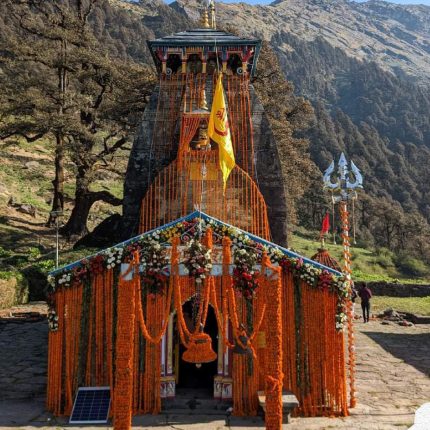
Panch Kedar Trek
The five pilgrim site circuit of Kedarkhand in garhwal region…
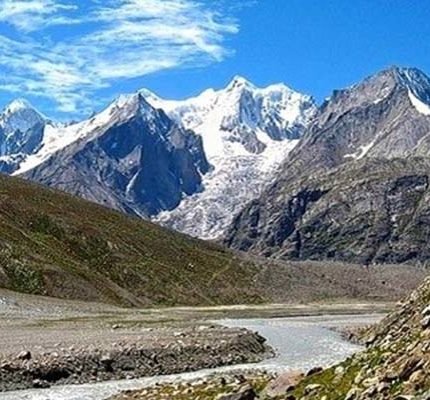
Rumtse to Tso Moriri Trek
Lake Moriri or Tso Moriri trek lies in the Jammu and Kashmir region.
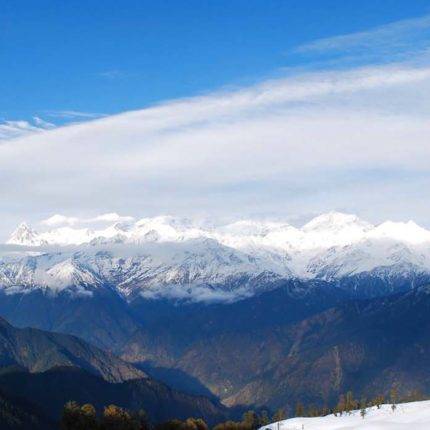
Dayara Bugyal Trek
The Most Popular Winter Trek in Uttarakhand Himalayas
Price: ₹ 11,000.00
Book the tour
Send a quick enquiry.
- Overview Itinerary Dates Include/Exclude
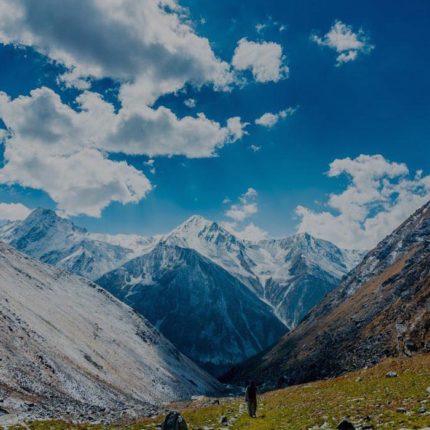

Manaslu Circuit Treks
Trek For All
Manaslu Trek Route: The Ultimate Himalayan Adventure
Are you a nature lover looking for the ultimate Himalayan adventure? Look no further than the Manaslu Trek Route. Known as one of the most challenging and remote trekking routes in Nepal, the Manaslu Trek offers breathtaking views of the Himalayan mountains, lush forests, and stunning landscapes. With its remote location, the Manaslu Trek provides a unique opportunity to experience the natural beauty of Nepal while avoiding the crowds of more popular trekking routes.
Along the way, you’ll encounter traditional villages, ancient monasteries, and diverse wildlife. The trek also offers a glimpse into the rich cultural heritage of the region, with its mix of Buddhist and Hindu influences. While it may be a challenging trek, the Manaslu Route is well worth the effort for those seeking an unforgettable adventure in the heart of the Himalayas. So pack your bags, lace up your boots, and get ready to embark on the journey of a lifetime.
Table of Contents
Why the Manaslu Trek Routes are Perfect for nature lovers
The Manaslu Trek Route is perfect for nature lovers because it takes you through some of the most beautiful and remote areas of Nepal. The trek is located in the Manaslu Conservation Area , which is home to a diverse range of flora and fauna. The area is known for its rhododendron forests, which bloom in the spring and add a splash of color to the landscape. The trek also takes you through the Larkya La Pass, which offers stunning views of the Himalayan mountains.

In addition to the natural beauty of the area, the Manaslu Trek Route also offers a glimpse into the rich cultural heritage of the region. The trek takes you through traditional villages, where you can see how the locals live and experience their way of life. You will also pass by ancient monasteries, where you can learn about the Buddhist and Hindu influences of the area.
Overall, the Manaslu Trek Route offers a unique opportunity to experience the natural beauty and cultural heritage of Nepal in a way that few other treks can match.
Overview of the Manaslu Conservation Area
The Manaslu Conservation Area is a protected area in Nepal that covers an area of 1,663 square kilometers. The area is named after Mount Manaslu , which is the eighth-highest mountain in the world. The conservation area is home to a diverse range of flora and fauna, including the snow leopard, Himalayan tahr, and gray wolf.
The Manaslu Trek Route takes you through the conservation area, allowing you to experience its natural beauty firsthand. The area is known for its stunning landscapes, which include snow-capped mountains, lush forests, and meandering rivers. The trek also takes you through traditional villages, where you can experience the local culture and way of life.

The Manaslu Conservation Area is a protected area, which means that it is carefully managed to ensure the preservation of its natural resources. As a trekker on the Manaslu Trek Route, it is important to respect the rules and regulations of the conservation area to help preserve it for future generations.
Highlights of the Manaslu Trek Route
The Manaslu Trek Route is a challenging trek that takes you through some of the most beautiful and remote areas of Nepal. Here are some of the highlights of the trek:
Larkya La Pass
The Larkya La Pass is the highest point on the Manaslu Trek Routes, reaching an altitude of 5,135 meters . The pass offers stunning views of the Himalayan mountains, including Manaslu, Himalchuli, and Cheo Himal. The pass is challenging, but it is well worth the effort for the breathtaking views. Visit trip package: Manaslu Larkya La Pass Trek
Traditional Villages
The Manaslu Trek Route takes you through several traditional villages, including Soti Khola, Machha Khola, and Samagaon . These villages offer a glimpse into the local culture and way of life, with traditional houses, temples, and markets.

Ancient Monasteries
The trek also takes you past several ancient monasteries, including the Ribung Gompa and the Samagaon Gompa. These monasteries offer a glimpse into the Buddhist and Hindu influences of the area, with stunning architecture and intricate artwork.
Natural Beauty
The Manaslu Trek Route is known for its natural beauty, with stunning landscapes that include snow-capped mountains, lush forests, and meandering rivers. The trek also takes you through the rhododendron forests, which bloom in the spring and add a splash of color to the landscape.
Best time to trek the Manaslu Trek Routes
The best time to trek the Manaslu Trek Routes is from September to November and from March to May. During these months, the weather is relatively stable, and the skies are clear, allowing for stunning views of the Himalayan mountains. The weather can be unpredictable during the monsoon season, which lasts from June to August, and the winter months can be extremely cold and snowy.

Difficulty level and fitness requirements
The Manaslu Trek Route is a challenging trek that requires a good level of fitness and endurance. The trek involves long days of hiking, with steep ascents and descents, and the Larkya La Pass is particularly challenging. The trek reaches an altitude of over 5,000 meters, which can cause altitude sickness in some trekkers.
It is important to prepare for the trek by training beforehand and ensuring that you have the proper equipment and clothing. Trekking poles can be particularly helpful in reducing the strain on your knees and legs.
What to pack for the Manaslu Trek Route
When packing for the Manaslu Trek Route, it is important to pack light but also ensure that you have everything you need for the trek. Here are some essential items to pack:
- Hiking boots
- Warm clothing
- Sleeping bag
- Trekking poles
- First aid kit
- Water bottle
- Insect repellent
It is also important to pack a good-quality backpack that can hold all of your gear comfortably.
Accommodation and food options during the trek
The Manaslu Trek Route offers a range of accommodation options, including teahouses and camping. Teahouses are small guesthouses that offer basic accommodations and meals, while camping allows you to experience the trek in a more remote and secluded way.
The food options on the trek are varied, with many teahouses offering traditional Nepali cuisine, as well as Western options. The food is generally simple but filling, with plenty of carbohydrates to fuel your trek.
Cultural Experiences on the Manaslu Trek Routes
The Manaslu Trek Route offers a range of cultural experiences, including visits to traditional villages and ancient monasteries. The area is home to a mix of Buddhist and Hindu influences, and you can learn about the local culture and way of life as you trek through the area.
One highlight of the trek is the Manaslu Conservation Area Project, which is a community-based conservation project that aims to protect the natural resources of the area while also supporting the local communities. The project offers a range of cultural experiences, including homestays and cultural performances.
Safety Tips for the Manaslu Trek Routes
The Manaslu Trek Route is a challenging trek that requires careful preparation and planning. Here are some safety tips to keep in mind:
- Acclimatize properly to avoid altitude sickness.
- Follow the rules and regulations of the Manaslu Conservation Area.
- Stay hydrated and well-fed to maintain your energy levels.
- Take breaks when needed and listen to your body.
- Be prepared for changes in weather and bring appropriate gear.
It is also important to trek with a reputable guide or trekking company to ensure that you have the support and guidance you need.
List of Manaslu Trek Routes
- Manaslu Circuit Trek
- Manaslu Tsum Valley Trek
- Manaslu Circuit Trekking & Larke Peak
- Lower Manaslu Trek
- Manaslu Larkya La – Pass Camping Trek
The Manaslu Trek Routes are challenging but rewarding trek that offers a unique opportunity to experience the natural beauty and cultural heritage of Nepal. With stunning views of the Himalayan mountains, lush forests, and traditional villages, the trek is a must-do for nature lovers and adventure seekers. By following the proper preparation and safety tips, you can experience the trek in a safe and enjoyable way. So pack your bags, lace up your boots, and get ready to embark on the journey of a lifetime.
Keep Reading See All

3 Ways To Manaslu Circuit Adventure

How many days is the Manaslu Trek?
Leave a reply … cancel reply.
Your email address will not be published. Required fields are marked *
Notify me of follow-up comments by email.
Notify me of new posts by email.

- Annapurna Base Camp Trek
- Annapurna Circuit Trek
- Upper Mustang Trek
- Ghorepani Poon Hill Trek
- Mardi Himal Trek
- Dhaulagiri Circuit Trek
- Nar Phu Valley Trekking
- Annapurna Base Camp Helicopter Tour
- Muktinath Helicopter tour
- Everest Base Camp Trek
- Everest Three Pass Trek
- Everest View Trek
- Gokyo Lake Trek
- Everest Base Camp Trek with Gokyo Lakes
- Everest Base Camp Helicopter Tour
- Luxury Everest Base Camp Trek
- Langtang Valley Trek
- Langtang Gosaikunda Trek
- Helambu Trek
- Tamang Heritage Trek
- Langtang Gosainkunda Helicopter Tour
- Manaslu Circuit Trek
- Manaslu and Tsum Valley Trek
- Tsum Valley Trek
- Shey Phoksundo Lake Trek
- Upper Dolpo Trek
- Lower Dolpo Trek
- Makalu Base Camp Trek
- Kanchenjunga Circuit Trek
- Kathmandu Valley City Tour
- Pokhara City Tour
- Nagarkot to Changunarayan Hike
- 3 Nights 4 Days Bhutan Tour
- 4 Nights 5 Days Bhutan Tour
- 5 Nights 6 Days Bhutan Tour
- 6 Nights 7 Days Bhutan Tour
- Muktinath Helicopter Tour
- Motorbike Tour In Nepal
- Photograhy Tour in Nepal
- Chitwan National Park Tour
- Bardiya National Park Tour
- Chitwan, Pokhara and Lumbini Tour
- Koshi Tappu Wildlife Reserve tour
- Mera Peak Climbing
- Island Peak Climbing
- Lobuche East Peak Climbing
- Yala Peak Climbing
- Terms & Conditions
- Message From Director
Featured Trip - Helambu Trek -

- 24/7 Call Support +9779808225444
- Any Question? Email Us [email protected]

Langtang Trek Route
- Trekking info »
27th Sep, 2023
- Magnificent Himalayan Treks
The Langtang Trek Route is a popular trekking route in Nepal that offers stunning views of the Himalayas, including Langtang Lirung (7,234 m), the 99th highest mountain in the world. The trek is also known for its cultural richness and diverse landscapes, which include lush forests, alpine meadows, and glaciers.
Table of Contents
The Langtang Trek is typically done in 7-10 days, depending on the pace of the trek and whether or not any side treks are added. The trek starts and ends in the town of Syabrubesi, which is located about 120 km northeast of Kathmandu.
The trek to langtang begins with a gradual ascent through lush forests and traditional Tamang villages. You will also cross several suspension bridges over the Langtang River. The trail then becomes steeper as you approach Langtang Village, which is a charming village with guesthouses, restaurants, and shops.
From Langtang Village, you can continue on to Kyanjin Gompa, a Buddhist monastery located at the foot of Langtang Lirung. Kyanjin Gompa is a popular base for acclimatization and side treks. Some popular side treks from Kyanjin Gompa include Tserko Ri (5,000 m) and Langtang Ri (4,130 m), both of which offer stunning views of the surrounding mountains.
The Langtang Trek is a moderate trek, but it is important to be acclimatized to the high altitude before attempting the trek. It is also recommended to hire a guide or porter, especially if you are not experienced in trekking at high altitudes.
Itinerary for Langtang Trek
Day 1: kathmandu to syabrubesi (1,550 m).
The first day of the Langtang trek is a long bus ride from Kathmandu to Syabrubesi. The road is winding and narrow, but the views of the Himalayas are stunning. Once you arrive in Syabrubesi, you can check into your guesthouse and relax for the evening.
Day 2: Syabrubesi to Lama Hotel (2,380 m)
The second day of the trek to Langtang is a gradual ascent through lush forests and traditional Tamang villages. You will also cross several suspension bridges over the Langtang River. The trail ends at Lama Hotel, where you can stay for the night.
Day 3: Lama Hotel to Langtang Village (3,430 m)
The third day of the Langtang trek is a steeper ascent to Langtang Village. The trail passes through rhododendron forests and offers stunning views of the Langtang Lirung peak. Langtang Village is a charming village with guesthouses, restaurants, and shops.
Day 4: Langtang Village to Kyanjin Gompa (3,870 m)
The fourth day of the Langtang trek is a short trek to Kyanjin Gompa, a Buddhist monastery located at the foot of Langtang Lirung. Kyanjin Gompa is a popular base for acclimatization and side treks.
Day 5: Acclimatization day in Kyanjin Gompa
The fifth day of the trek is an acclimatization day in Kyanjin Gompa. You can use this day to rest, explore the monastery, or do a side trek, such as to Tserko Ri (5,000 m) or Langtang Ri (4,130 m).
Day 6: Kyanjin Gompa to Lama Hotel (2,380 m)
The sixth day of the trek to Langtang is a descent back to Lama Hotel. The trail passes through the same forests and villages that you passed through on the way up.
Day 7: Lama Hotel to Syabrubesi (1,550 m)
The seventh day of the Langtang trek is a long descent back to Syabrubesi. Once you arrive in Syabrubesi, you can board a bus back to Kathmandu.
Optional side treks route for Langtang:
Tserko Ri (5,000 m): Tserko Ri is a peak located near Kyanjin Gompa. It offers stunning views of the Langtang Lirung peak and the surrounding mountains. The trek to Tserko Ri takes about 6-7 hours round trip.
Langtang Ri
Langtang Ri (4,130 m): Langtang Ri is another peak located near Kyanjin Gompa. It offers stunning views of the Langtang Lirung peak, the surrounding mountains, and the Langtang Valley. The trek to Langtang Ri takes about 4-5 hours round trip.
Langtang Glacier
The Langtang Glacier is one of the longest glaciers in the Himalayas. It is located about 2 hours from Kyanjin Gompa. The trek to the Langtang Glacier is challenging, but it is worth the effort for the stunning views.
Tips for the Langtang Trek Route:
- The best time to do the Langtang Trek is during the spring (March-May) and autumn (September-November) seasons, when the weather is mild and sunny.
- The Langtang Trek is a moderate trek, but it is important to be acclimatized to the high altitude before attempting the trek.
- It is recommended to hire a guide or porter for the Langtang Trek, especially if you are not experienced in trekking at high altitudes.
- Be sure to pack warm clothes,
Recent From Trekking info

25th Sep, 2023

26th Sep, 2023
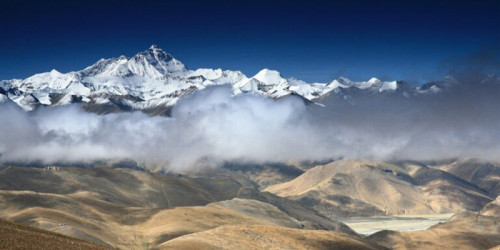
28th Sep, 2023

29th Sep, 2023
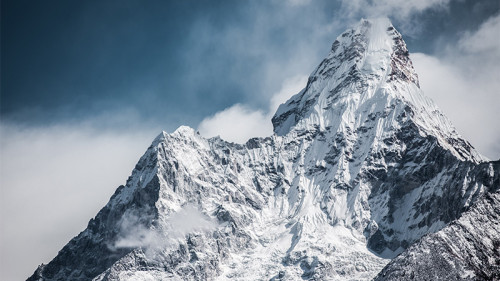
1st Oct, 2023
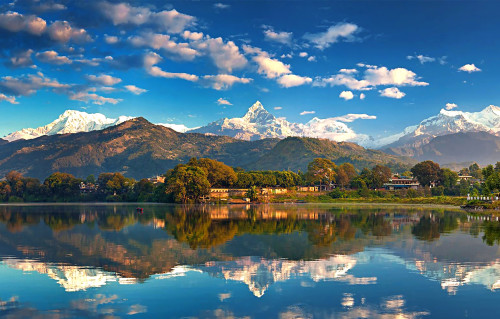
9th Dec, 2023

25th Feb, 2024
Find & follow us on, proudly member of.
© 2001 - 2024 All rights reserved. Magnificent Himalayan Treks
Notice. This site uses cookies to optimize your user experience. By using this site, you are consenting to our use of these cookies. Check out our Privacy Policy and our Cookies Policy.
National Geographic content straight to your inbox—sign up for our popular newsletters here
Meet the Himalayan trekking guide reclaiming the mountains for women
The Himalayan trekking leader is part of a new generation of Nepalese women claiming their space amid some of the world’s highest peaks.

When 27-year-old Sumitra Acharya took on a job as a trekking porter in 2019, she had a mountain to climb. With Nepal’s outdoor industry a male-dominated field, she defied societal expectations, carrying 15kg loads of clothing, supplies, sleeping bags and more for some 10 miles a day to ease the burden for visiting mountaineers. Five years on, she’s leading expeditions to Everest Base Camp and Annapurna — and, she hopes, inspiring other Nepalese women to reach for new heights.
Why are there so few women in Nepal’s trekking industry?
The willingness is there, but it’s not easy out in the field. Guides are on the job for long stretches of time, and for long days, mostly in male groups. The traditional view in our society is still that women need to be near the house, do chores. The outdoors isn’t thought to be for them — not yet.
Why did you decide to become a porter?
I decided to work in the tourism industry, and I saw tour operator Intrepid was looking for female porters. I instantly said no; at the time, I’d even complain about having to carry bags home from my local market. But when I told my mother, her first reaction was, “If it’s not for you, you can always come back home — but at least give it a try.” So, I did.
What challenges did you face?
My parents and brothers supported me, but other relatives and friends told me I was making a mistake. And while there were other female porters and guides at Intrepid, I saw no local women on the trails. I was discouraged by male porters I’d meet at base camps or checkpoints. They’d see me and snort. They told me I was beautiful, that I should get married and enjoy my husband’s money. Some would stare at me like I was an alien, around hotel corners or sitting in dining halls.
Where did you find the resilience to keep going?
The people I was working with had my back. They taught me everything, from controlling my pace while hiking to befriending hotel owners so I wouldn’t get homesick. As we say, when there are 1,000 shackles binding you, there’s always one thing that can set you free.
Has the industry changed since you joined?
The number of female porters, assistant guides and leaders at Intrepid keeps growing. There were a few when I joined; this year, at Intrepid, we’re 37 and counting. I have a few close friends who are passionate about the outdoors, be it climbing or trekking. Their families don’t believe they should pursue it as a career, but they’re taking a stand for themselves. I think that’s the major difference now. Girls are getting an education and want to be independent.
Where does your passion for the outdoors come from?
I always wanted to do solo backpacking trips, but I didn’t do any exploring until I was 20. I was born in a rural community in Sindhupalchok district, northeast of Kathmandu, but raised in a city in the Kathmandu Valley. There are no transport links to my home village; whenever I visited, I struggled to walk the hour and a half it took to get there, so I thought I wasn’t made to climb mountains. Then, while studying agriculture in Jiri town, I went on a hike to nearby Cherdung Hill, which reaches 12,000ft. It proved to me that this was something I could do.
What are some of your favourite hikes?
Besides Everest, another popular trekking area in the Himalayas is Manaslu — the eighth-highest mountain in the world at 26,781ft. You can still find a proper sense of rawness there, in the local culture and traditions. As for new hikes I’d like to do myself, it would be the country’s far west. There are a number of destinations, but my pick would be Upper Dolpo.
What is your proudest achievement?
If one single girl is inspired by my story, that’d be it. But equally, I’m proud to be here, talking about my life and how it’s changed in just five years. I’m doing my dream job, showing my country to people from around the world. I feel like a leader.
Intrepid runs a number of small-group trips to Nepal.
Introducing Nat Geo Kids Book Bundle!
Related topics.
- MOUNTAIN CLIMBING
You May Also Like

Was Nepal right to ban solo trekking in the Himalayas?

A practical guide to hiking the Himalayas

Eight life-affirming trips to take this year

How climbers faced down the ‘death zone’ on one of Earth’s tallest mountains

Get ready for your next iconic adventure like a pro with these tips
- Environment
- Paid Content
- Photography
History & Culture
- History & Culture
- History Magazine
- Mind, Body, Wonder
- Terms of Use
- Privacy Policy
- Your US State Privacy Rights
- Children's Online Privacy Policy
- Interest-Based Ads
- About Nielsen Measurement
- Do Not Sell or Share My Personal Information
- Nat Geo Home
- Attend a Live Event
- Book a Trip
- Inspire Your Kids
- Shop Nat Geo
- Visit the D.C. Museum
- Learn About Our Impact
- Support Our Mission
- Advertise With Us
- Customer Service
- Renew Subscription
- Manage Your Subscription
- Work at Nat Geo
- Sign Up for Our Newsletters
- Contribute to Protect the Planet
Copyright © 1996-2015 National Geographic Society Copyright © 2015-2024 National Geographic Partners, LLC. All rights reserved
- Yekaterinburg
- Novosibirsk
- Vladivostok

- Tours to Russia
- Practicalities
- Russia in Lists
Rusmania • Deep into Russia
Out of the Centre
Savvino-storozhevsky monastery and museum.

Zvenigorod's most famous sight is the Savvino-Storozhevsky Monastery, which was founded in 1398 by the monk Savva from the Troitse-Sergieva Lavra, at the invitation and with the support of Prince Yury Dmitrievich of Zvenigorod. Savva was later canonised as St Sabbas (Savva) of Storozhev. The monastery late flourished under the reign of Tsar Alexis, who chose the monastery as his family church and often went on pilgrimage there and made lots of donations to it. Most of the monastery’s buildings date from this time. The monastery is heavily fortified with thick walls and six towers, the most impressive of which is the Krasny Tower which also serves as the eastern entrance. The monastery was closed in 1918 and only reopened in 1995. In 1998 Patriarch Alexius II took part in a service to return the relics of St Sabbas to the monastery. Today the monastery has the status of a stauropegic monastery, which is second in status to a lavra. In addition to being a working monastery, it also holds the Zvenigorod Historical, Architectural and Art Museum.
Belfry and Neighbouring Churches

Located near the main entrance is the monastery's belfry which is perhaps the calling card of the monastery due to its uniqueness. It was built in the 1650s and the St Sergius of Radonezh’s Church was opened on the middle tier in the mid-17th century, although it was originally dedicated to the Trinity. The belfry's 35-tonne Great Bladgovestny Bell fell in 1941 and was only restored and returned in 2003. Attached to the belfry is a large refectory and the Transfiguration Church, both of which were built on the orders of Tsar Alexis in the 1650s.

To the left of the belfry is another, smaller, refectory which is attached to the Trinity Gate-Church, which was also constructed in the 1650s on the orders of Tsar Alexis who made it his own family church. The church is elaborately decorated with colourful trims and underneath the archway is a beautiful 19th century fresco.
Nativity of Virgin Mary Cathedral

The Nativity of Virgin Mary Cathedral is the oldest building in the monastery and among the oldest buildings in the Moscow Region. It was built between 1404 and 1405 during the lifetime of St Sabbas and using the funds of Prince Yury of Zvenigorod. The white-stone cathedral is a standard four-pillar design with a single golden dome. After the death of St Sabbas he was interred in the cathedral and a new altar dedicated to him was added.

Under the reign of Tsar Alexis the cathedral was decorated with frescoes by Stepan Ryazanets, some of which remain today. Tsar Alexis also presented the cathedral with a five-tier iconostasis, the top row of icons have been preserved.
Tsaritsa's Chambers

The Nativity of Virgin Mary Cathedral is located between the Tsaritsa's Chambers of the left and the Palace of Tsar Alexis on the right. The Tsaritsa's Chambers were built in the mid-17th century for the wife of Tsar Alexey - Tsaritsa Maria Ilinichna Miloskavskaya. The design of the building is influenced by the ancient Russian architectural style. Is prettier than the Tsar's chambers opposite, being red in colour with elaborately decorated window frames and entrance.

At present the Tsaritsa's Chambers houses the Zvenigorod Historical, Architectural and Art Museum. Among its displays is an accurate recreation of the interior of a noble lady's chambers including furniture, decorations and a decorated tiled oven, and an exhibition on the history of Zvenigorod and the monastery.
Palace of Tsar Alexis

The Palace of Tsar Alexis was built in the 1650s and is now one of the best surviving examples of non-religious architecture of that era. It was built especially for Tsar Alexis who often visited the monastery on religious pilgrimages. Its most striking feature is its pretty row of nine chimney spouts which resemble towers.

Plan your next trip to Russia
Ready-to-book tours.
Your holiday in Russia starts here. Choose and book your tour to Russia.
REQUEST A CUSTOMISED TRIP
Looking for something unique? Create the trip of your dreams with the help of our experts.
- My View My View
- Following Following
- Saved Saved
Blizzard in the Himalayas traps trekkers, killing nine from India
- Medium Text
Sign up here.
Reporting by Shivam Patel and Tanvi Mehta; Editing by Bernadette Baum
Our Standards: The Thomson Reuters Trust Principles. New Tab , opens new tab
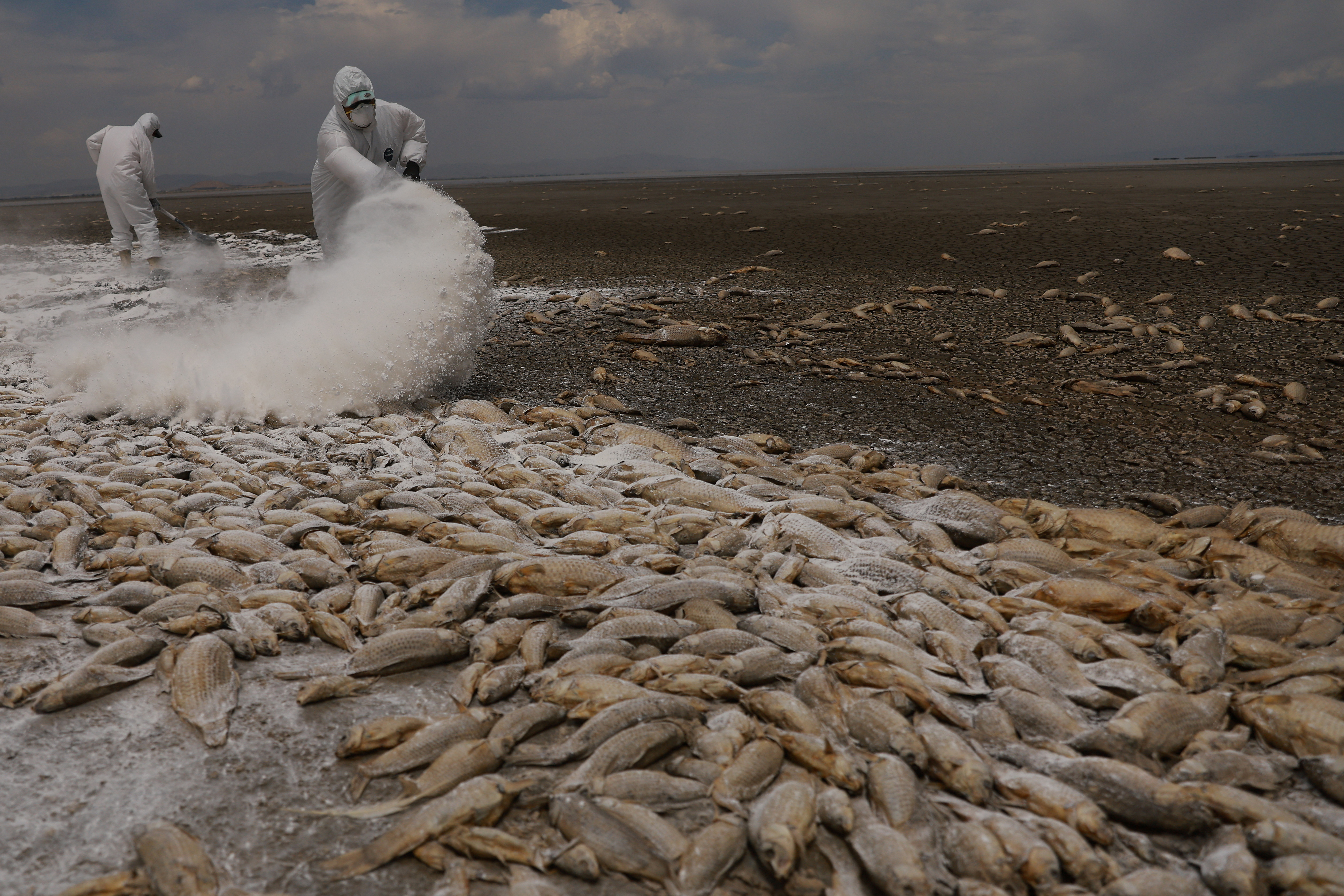
World Chevron
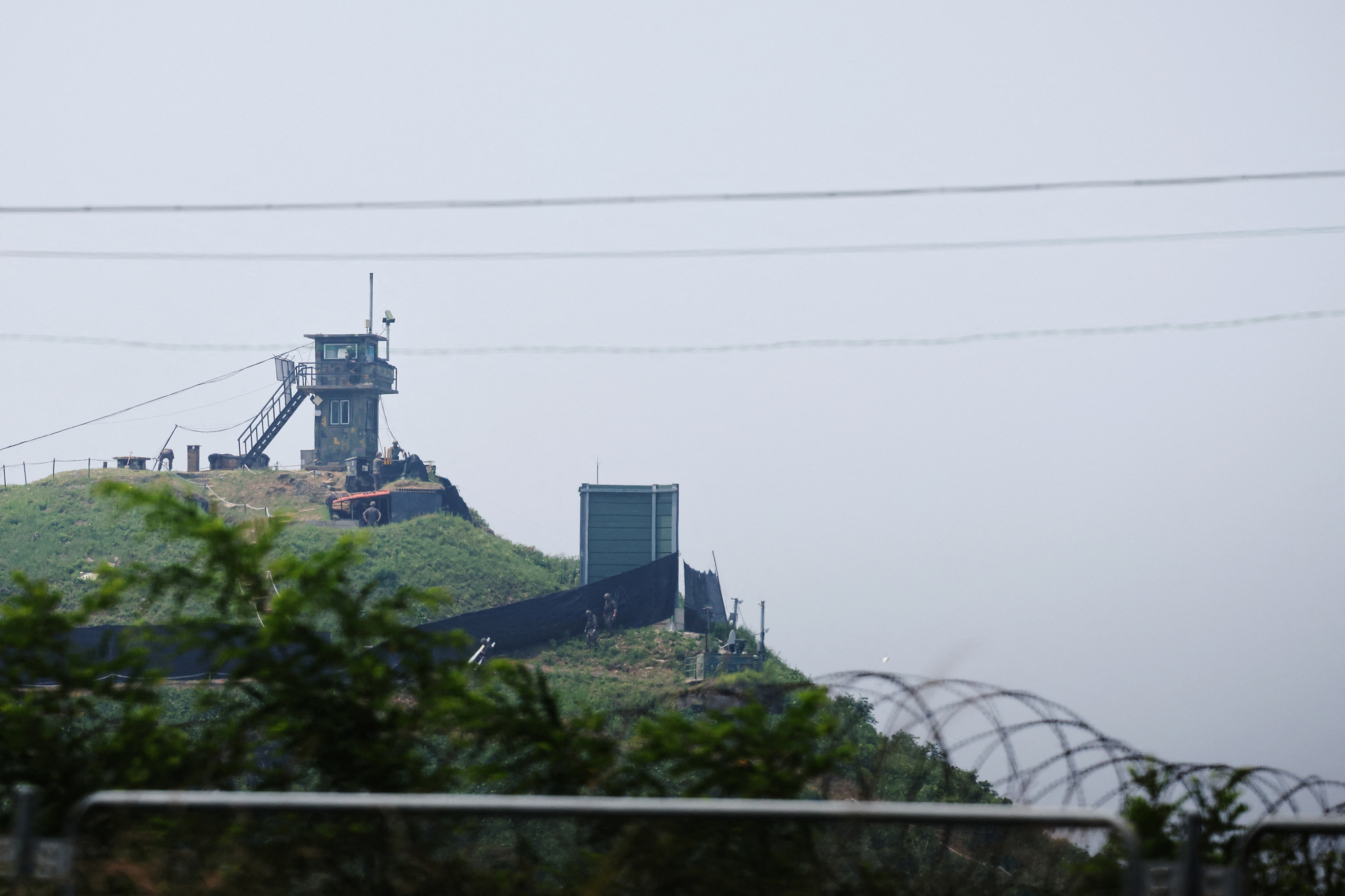
North Korea leader's sister warns of new response against South Korean loudspeakers, leaflets
Seoul was following through on a warning demanding that Pyongyang stop sending balloons carrying trash into the South.

- India Today
- Business Today
- Harper's Bazaar
- Brides Today
- Cosmopolitan
- India Today Hindi
- Reader’s Digest
- Aaj Tak Campus
4 dead in Uttarakhand after group of 22 goes missing due to bad weather, 8 rescued
A group of 22 trekkers en route to sahastra tal in uttarakhand's uttarkashi went missing and got trapped due to bad weather. four of them were feared killed and rescue teams were sent to the spot to rescue the remaining trekkers..
Listen to Story

- 22-trekking member group goes missing while en route Uttarakhand's Sahastra Tal
- Trekking agency informs authorities that four of its members were feared killed
- Rescue teams sent to the spot to rescue the remaining trekkers trapped
Four people were killed after a 22-member trekking team, which had gone trekking to Sahastra Tal in Uttarakhand's Uttarkashi, lost their way due to bad weather and got trapped along the route. Eight of them were rescued and the bodies of four trekkers were found in Uttarkashi.
Uttarkashi District Magistrate Meharban Singh Bisht said that the trekking team comprising 18 members from Karnataka, one from Maharashtra and three guides from Uttarkashi had gone on a trekking expedition to Sahastra Tal on May 29 and were to return on June 7.
A trekking agency, Himalayan View Tracking Agency, Maneri, which took the trekkers to the Sahastra Tal, informed authorities about four people who were feared killed and requested the evacuation of 13 trapped members. All the trekkers were registered by the district administration.
Bisht requested the State Disaster Response Force (SDRF) to send rescue teams to the spot and rescue the trekkers. He also ordered to send local-level rescue teams to the site as well. The SDRF has reached out to 10 more people from the trekkers' group.
He said Sahastra Tal is located at an altitude of about 4,100-4,400 metres and that the incident site is located in the border area of ​​Uttarkashi and Tehri districts. "For the quick rescue of the trekking team, we have set rescue teams to Uttarkashi and Ghansali Tehri sides," he added.
Sahastra Tal is a group of seven lakes on a peak and it is believed that Pandavas had left for heaven from this place.
The District Magistrate wrote to the Joint Secretary of the Central Defence Department for air rescue and the SDRF commandant for ground rescue assistance.
He also said the trekking agency had informed authorities to send people from Silla village to the spot to assist rescue teams. A request was also made to send teams of police and the forest department from the Tehri district to the spot. Rescue teams that were dispatched were facing delays in reaching the spot due to the inclement weather.
The Tehri district administration sent teams to rescue the trekkers trapped at Sahastra Tal. Talks were on to involve the Indian Air Force in the rescue operation. Published By: Prateek Chakraborty Published On: Jun 5, 2024 ALSO READ | Uttarakhand bans use of mobile phones to shoot reels near Char Dham temples ALSO READ | Satellite captures extent of Uttarakhand forest fire
IN THIS STORY

IMAGES
VIDEO
COMMENTS
The route has to Mount Everest Advance Base Camp is a challenging but beautiful trek through a stunning mountain landscape. The journey to EABC starts in Lhasa (11,975ft/ 3,650m) the capital of Tibet where it's best to spend a few days acclimatizing before heading out towards Everest.
Kanchenjunga Trek. In between the Nepal and Sikkim borders lies a glorious mountain at an elevation of 8568 meters. It is none other than the sacred Mt. Kanchenjunga, the third-highest mountain in the world. The Kanchenjunga Trek is a remote trekking experience to the third-highest mountain on earth.
In conclusion, trekking in the Himalayas is a transformative experience that combines natural beauty, physical challenges, and cultural immersion. By understanding the unique terrain, adequately preparing for your trek, choosing the right route, and navigating cultural etiquette, you can make the most of your Himalayan adventure.
The Goechala trek route is almost 75 km long and it rises to an altitude 15,100 ft. ... The Bali Pass trek is a difficult Himalayan trek. This is partly due to the high altitude that rises to over 16,000 ft. The Bali Pass trek is more than an adventure filled trek, you also pass through some historical villages and trek to Ruinsara Tal - a ...
The Nepal section of the Great Himalaya Trail was officially opened in 2011 and covers a staggering 1,700 kilometers - separated into ten sections. The trail takes 6 months and, if you were to use an operator, would cost in the region of US$30,000. Those few who have trekked the entire 1,700 km have described it as a spiritual journey.
The GHT High route is the world's highest and hardest trekking route. GHT Short Treks. Here's a chance to explore the highest mountains in the world in bite-size GHT Nepal Short Treks in 9 to 23 days ... There are three main 'styles' of trekking the Great Himalaya Trail, each of which has pros and cons. Your choice will depend on your ...
This classic trek meanders through Himalayan foothills and over high passes, offering picturesque mountain views along the way. Annapurna Circuit Trek. ... Route Details. At its pinnacle, the trek crosses the Thorung La Pass (5,416 meters) before descending down to the town of Muktinath. From here the road construction activities (2004 -2008/09 ...
Trekking the full GHT can take anywhere between 90 and 150 days. Most parts of the GHT can be trekked independently, without a guide or porters. Unless you're very experienced trekking in the Himalaya and speak Nepali (or other local languages), though, the help of a local guide and/or porter is a good idea, at least on some parts of the trail.
The Great Himalaya Trail is a route across the Himalayas from east to west. The original concept was to establish a single long distance trekking trail from the east end to the west end of Nepal that includes a total of roughly 1,700 kilometres (1,100 mi) of path. There is a proposed trail of more than 4,500 kilometres (2,800 mi) stretching the ...
Explore All the Treks Provided by Trek The Himalayas: From Easy to Challenging, Green Valleys to Snow-Capped Peaks. Immerse Yourself in Diverse Landscapes and Vibrant Cultures. Plan Your Adventure Today!
The Great Himalaya Trail A Pictorial Guide II Edition. Robin Boustead, an Australian who has been trekking the Himalaya for over two decades, is a modern GHT pioneer. He walked the Great Himalaya route for the first time in 2008 and 2009 with his team (Pema Tsering Sherpa, Lakpa Sherpa, and Karma Sherpa) and successfully completed in 157 days.
Discovery World Trekking has been organizing treks and tours in remote Nepal for over a decade. If you wish to complete the section of the great Himalaya Trek route in Nepal, you can call/Viber/WhatsApp us at +977-9840055491 or email [email protected]. Share with your Friends.
Himalayan Map House publish a range of Great Himalaya Trail maps (see below) designed to work in combination with the Nepal Trekking and Great Himalaya Trail guidebook. These mapes are accurate to scales between 1:100,000 and 1:150,000 depending on the region, waterproof and updated every two-three years. For more information, free downloads or ...
Please see the 'Route Information and GPX Notes' below for more information on these tracks and way points. We are always looking for more, please contact us! ... many of the files cannot be used to approximate distance as you rarely walk in a straight line for 10 minutes in the Himalaya. Most locals will also refer to distance in hours walking ...
This classic trek takes place in the Bagmati Zone of Nepal and allows you to experience the immense beauty of the surroundings. Along your trek, you will get to witness 4 of the 6 highest mountain peaks in the world — Cho Oyu (8,201 m), Mt. Makalu (8,470 m), Mt. Lhotse (8,516 m), and Mt. Everest (8,848 m). Everest Base Camp is a teahouse trek ...
2. The Annapurna Circuit. Annapurna Circuit trekking is one of Nepal's most popular trekking routes. The Circuit takes hikers through a diverse range of landscapes, from dense jungle to high-altitude mountain passes. The route is approximately 200 kilometers long and typically takes between 10 and 21 days to complete.
Day 5 : Trek from Har Ki Dun to Cheludgad camp Via Osla Village. Trek Distance 13 km - 6/7 Hours journey. Mode of journey - On foot - 13 km Altitude - Cheludgad camp - 2600 Meters. Night Stay - on twin share basis Trekking from Har Ki Dun to Cheludgad camp via Osla Village offers a diverse and scenic route through the Himalayan landscapes.
The Larkya La Pass is the highest point on the Manaslu Trek Routes, reaching an altitude of 5,135 meters. The pass offers stunning views of the Himalayan mountains, including Manaslu, Himalchuli, and Cheo Himal. The pass is challenging, but it is well worth the effort for the breathtaking views. Visit trip package: Manaslu Larkya La Pass Trek.
- Magnificent Himalayan Treks. The Langtang Trek Route is a popular trekking route in Nepal that offers stunning views of the Himalayas, including Langtang Lirung (7,234 m), the 99th highest mountain in the world. The trek is also known for its cultural richness and diverse landscapes, which include lush forests, alpine meadows, and glaciers.
The Himalayan trekking leader is part of a new generation of Nepalese women claiming their space amid some of the world's highest peaks. 27-year-old Nepal-native Sumitra Acharya began working as ...
Zvenigorod's most famous sight is the Savvino-Storozhevsky Monastery, which was founded in 1398 by the monk Savva from the Troitse-Sergieva Lavra, at the invitation and with the support of Prince Yury Dmitrievich of Zvenigorod. Savva was later canonised as St Sabbas (Savva) of Storozhev. The monastery late flourished under the reign of Tsar ...
In 1938, it was granted town status. [citation needed]Administrative and municipal status. Within the framework of administrative divisions, it is incorporated as Elektrostal City Under Oblast Jurisdiction—an administrative unit with the status equal to that of the districts. As a municipal division, Elektrostal City Under Oblast Jurisdiction is incorporated as Elektrostal Urban Okrug.
Moscow Oblast (Russian: Московская область, romanized: Moskovskaya oblast, IPA: [mɐˈskofskəjə ˈobləsʲtʲ], informally known as Подмосковье, Podmoskovye, IPA: [pədmɐˈskovʲjə]) is a federal subject of Russia (an oblast).With a population of 8,524,665 (2021 Census) living in an area of 44,300 square kilometers (17,100 sq mi), it is one of the most densely ...
June 6, 20242:40 AM PDTUpdated 4 min ago. NEW DELHI, June 6 (Reuters) - At least nine Indian trekkers died in the Himalayas after getting trapped during a blizzard, authorities said on Thursday ...
Permission is granted to copy, distribute and/or modify this document under the terms of the GNU Free Documentation License, Version 1.2 or any later version published by the Free Software Foundation; with no Invariant Sections, no Front-Cover Texts, and no Back-Cover Texts.A copy of the license is included in the section entitled GNU Free Documentation License.
A group of 22 trekkers en route to Sahastra Tal in Uttarakhand's Uttarkashi went missing and got trapped due to bad weather. Four of them were feared killed and rescue teams were sent to the spot to rescue the remaining trekkers. ... A trekking agency, Himalayan View Tracking Agency, Maneri, which took the trekkers to the Sahastra Tal, informed ...